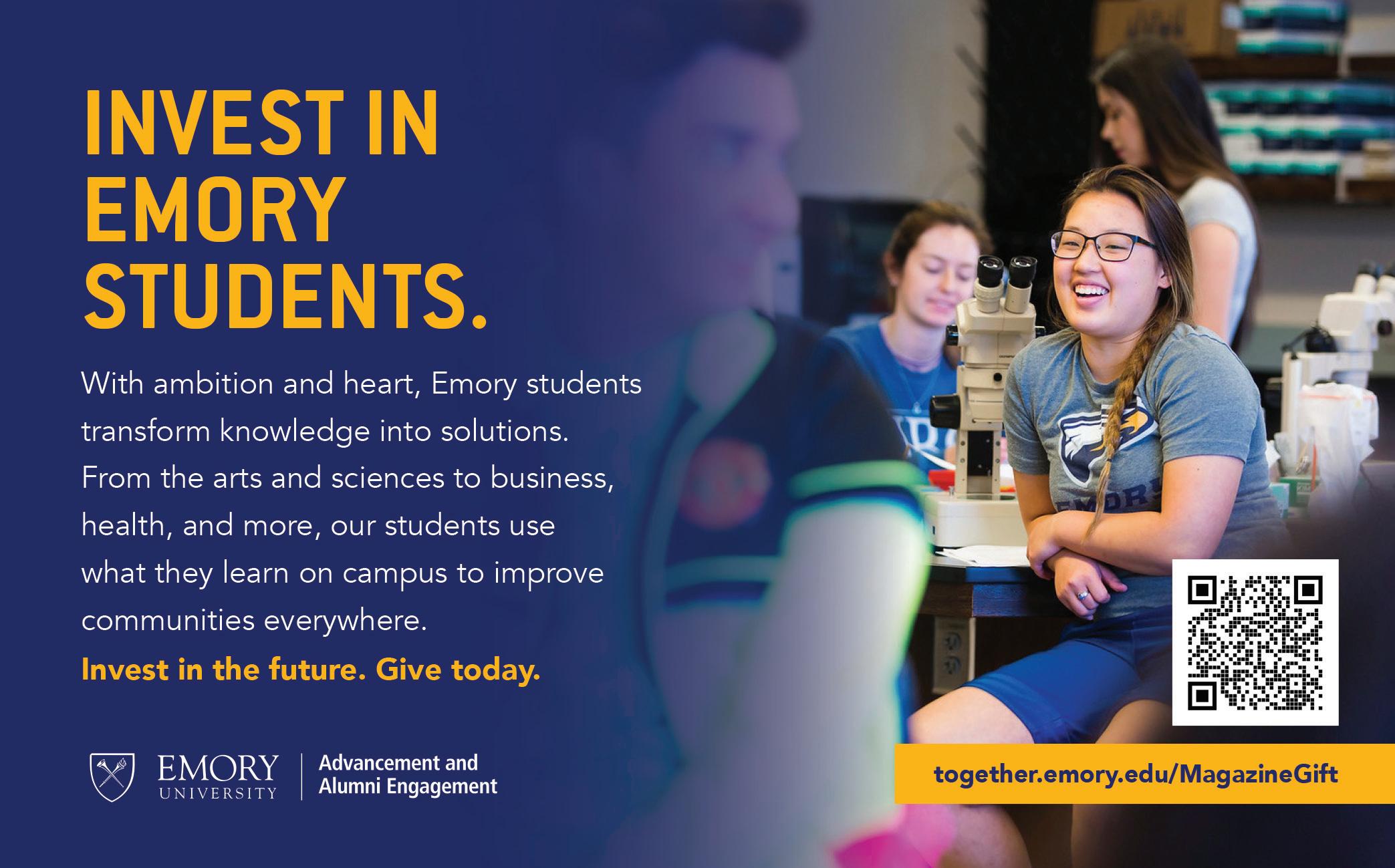

A TOP-RANKED FORMULA FOR


32 FROM BENCH TO BREAKTHROUGH
Discover innovations developed by Emory researchers that are changing health care — and saving lives — around the world. 38
SEEING IS BELIEVING
From rare books to unusual artifacts, Emory Libraries preserve unexpected treasures and put them to work in classrooms, exhibits and research. 48
RECASTING THE ‘VILLAIN’
Learn how Emory playwright Kimberly Belflower’s fearless coming-of-age play made the leap from page to Broadway and became a smash hit.
IN CASE YOU MISSED IT READ SPRING 2025 STORIES available only in digital format.
REMEMBERING JIMMY CARTER WATCH THE EMORY MEMORIAL service and read more stories about Carter's decades-long relationship with the university.
BONUS CONTENT
ENJOY EXTENDED READS about the library's archival treasures and game-changing medical research.
Editor-in-Chief
Roger Slavens
Assistant Vice
President, Content and Brand Story
Laura Douglas-Brown 95C 95G
Contributors
Michelle Babcock, John Baker Brown 99T, Susan Carini 04G, Jennifer Carlile, Anna Chapman, Daniel Christian, Carol Clark, Phil Engel, Ashlee Gardner, Shawn Reeves, Michelle Ricker, Kate Sweeney, Tony Van Witsen
Production Manager
Matilda Redfern
Advertising Manager
Jarrett Epps
Art Director Elizabeth Hautau Karp
Graphic Design Elizah Huff
Selena Lim
Peta Westmaas
Creative Director, Publications
Amanda C. Qubty
Photography Kay Hinton
Avery Spalding
Sarah Woods
Vice President, Communications and Marketing
Luke Anderson
University President Gregory L. Fenves
EMORY MAGAZINE (ISSN 00136727) is published by Emory’s Division of Communications and Marketing. Nonprofit postage paid at 3900 Crown Rd. SE, Atlanta, Georgia, 30304; and additional mailing offices. POSTMASTER: Send address changes to Advancement and Alumni Engagement Office of Data Management, 1762 Clifton Road, Suite 1400, Atlanta, Georgia 30322.
Emory Magazine is distributed free to alumni and friends of the university. Address changes may be emailed to eurec@emory. edu or sent to the Advancement and Alumni Engagement Office of Data Management, 1762 Clifton Road, Suite 1400, Atlanta, GA 30322. If you are an individual with a disability and wish to acquire this publication in an alternative format, please contact Roger Slavens (address above).
Emory Magazine Summer 2025 (Vol. 100 No. 4) ©2025, is a publication of the Division of Communications and Marketing.
Emory is an equal opportunity employer, and qualified applicants will receive consideration for employment without regard to race, color, religion, sex, national origin, disability, protected veteran status or other characteristics protected by state or federal law. Inquiries should be directed to the Department of Equity and Civil Rights Compliance, 201 Dowman Drive, Administration Bldg., Atlanta, GA 30322. Telephone: 404-727-9867 (V) | 404-712-2049 (TDD).
The comments and opinions expressed in this magazine do not necessarily represent those of Emory University or the staff of Emory Magazine.


THE BIG PICTURE
THERE'S NO PLACE LIKE HOME
The Emory Eagles softball team is just one of many success stories in a landmark year for Division III athletics at the university. From national titles to personal bests to championship runs across multiple sports, the 2024–25 season has been one for the record books. Page 18 has the proof — and the full recap of just how high the Eagles soared.

>> EMORY TRADITIONS
JOYFUL TEARS, POWERFUL WORDS MARK EMORY’S 180TH COMMENCEMENT
Usher Raymond IV inspires graduates with passionate message: ‘It’s not the degree, it’s you.’
Excited graduates and their proud families and friends filled Emory’s campus May 9–12 to mark the university’s 180th Commencement, honoring the achievements of thousands of hardworking students in the Class of 2025. Due to the forecast of possible severe weather, the university-wide Commencement ceremony was moved indoors to the Woodruff P.E. Center and combined with the diploma ceremony for Emory College of Arts and Sciences students earning bachelor of arts degrees.
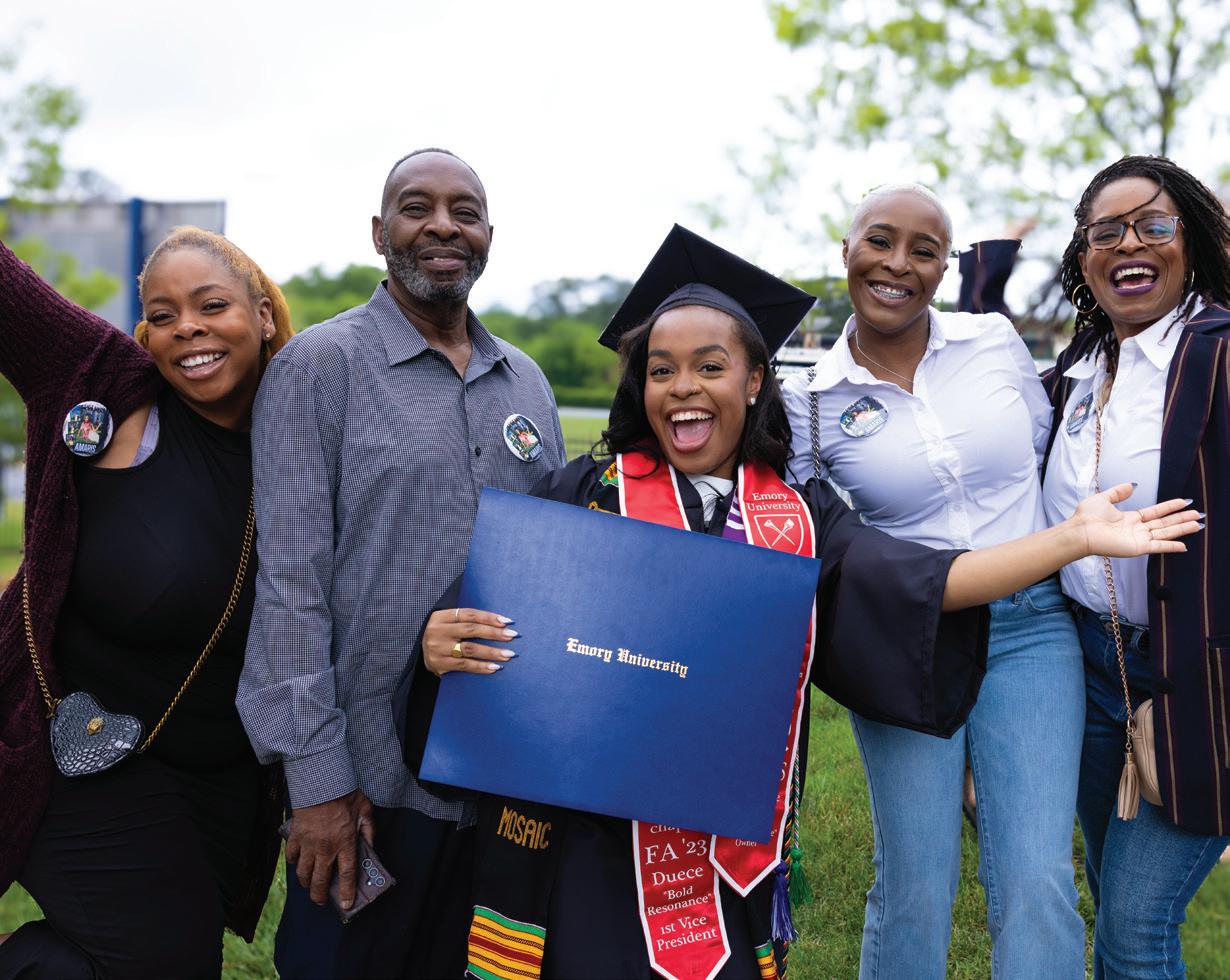
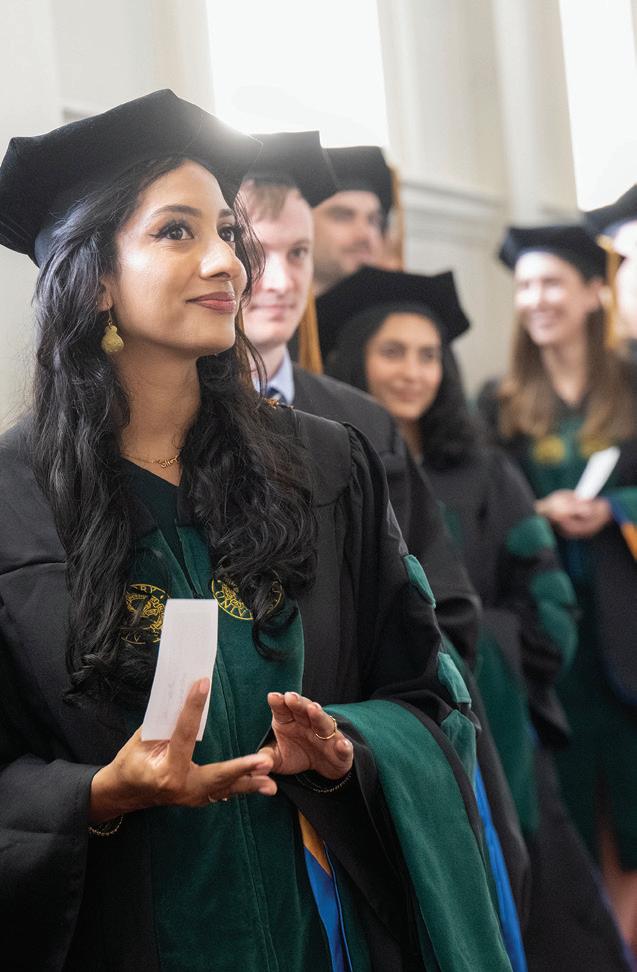
HONORED GUESTS
Emory awarded two additional honorary degrees at Commencement to:

No amount of rain could dampen the immense sense of accomplishment and pride among those in attendance. Graduates hugged, posed for photos and shed tears as they looked back fondly on their Emory experiences and looked forward to their bright futures.
Promptly at 8 a.m., faculty, students, Emory leaders and honored guests processed in, accompanied by the boom of a bass drum and the iconic skirl of bagpipes from the Atlanta Pipe Band.
Families waved to get their graduate’s attention and snapped photos. Graduates pored over their programs to locate their names and took videos of the blue-lit room. Once the platform party was seated and the bedel was placed on stage, Tracy McGill, chief marshal of the university, called Commencement to order.
“Class of 2025, I want you to always remember that you are capable of greatness, and that your time at Emory has prepared you for everything that comes next,” said Emory President Gregory L. Fenves.
Grammy Award–winning performer and philanthropist Usher Raymond IV created his own new chapter in the Emory story, receiv-
ing an honorary doctor of humane letters degree during the ceremony and serving as the keynote speaker.
During his address, Usher encouraged members of the Class of 2025 to look beyond what is printed on the degrees that they will receive via mail this summer. “It’s not the degree that gives the power. It’s you,” he said. “You create the value behind that degree. It is your ambition, your integrity, your hustle, your heart. It’s how you choose to show up when no one is watching.”
Usher also encouraged graduates to follow their passions and explore uncharted territory.
“Don’t be afraid to wander into space that you don’t understand, as long as you are bringing passion with you. Be willing to stretch, be a little unrealistic, be a little delusional even in your pursuit of happiness and fulfillment,” he said.
With the official conferral of degrees en masse, Emory welcomed 5,527 new graduates across the university into a dynamic alumni community of more than 176,000 around the world. These new graduates earned a total of 5,629 degrees and hailed from 53 U.S. states and territories, along with 71 other nations.

SUSAN B. HASSMILLER, a national leader in nursing and health education, received a Doctor of Humane Letters for advancing nursing practice, reducing health disparities and expanding opportunities for nurses.
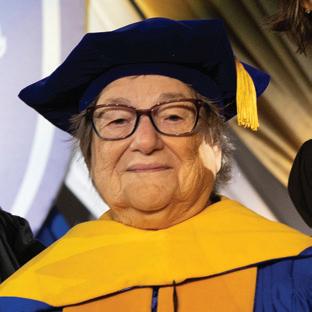
LEONORE A. HERZENBERG, a trailblazing geneticist, received a Doctor of Science for key discoveries in immunology and inventing the Fluorescence Activated Cell Sorter, a breakthrough in biomedical research.
HAPPY GRADS Emory bestowed 5,629 degrees to 5,527 new graduates from across the university, welcoming these new alumni into a dynamic global community.
>> ACADEMIC ACCOLADES
Emory Honors 2025 Award Winners
Recognizing trailblazing educators to standout student leaders, Emory’s Commencement awards celebrate those who have served the university with the highest distinction.

JAN LOVE
Thomas Jefferson Award
Honoring faculty and staff who have significantly enriched the intellectual and civic life of the Emory community through leadership and influence
An internationally recognized ecumenical leader, Jan Love has had a transformational impact at Emory. Appointed in 2007 as the first woman and layperson to lead Candler School of Theology, she guided major expansions in facilities, faculty, programs and inclusivity until she stepped down from the deanship in 2024. A professor of Christianity and world politics, Love helped create The Candler Foundry and La Mesa Academy while raising funds for divinity scholarships. She also served as interim provost from 2019-2021, leading Emory through presidential transition, the COVID-19 pandemic and pivotal conversations on racial justice.
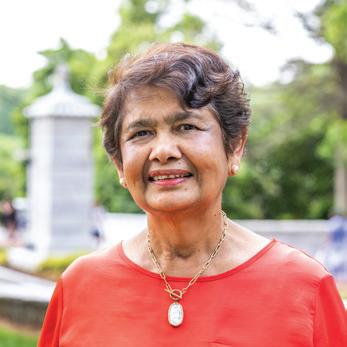
AMITA MANATUNGA
Exemplary Teacher of the Year Award
Honoring exceptional teaching, significant contributions to the scholarly life of the university, and high personal and professional standards
Amita Manatunga has dedicated more than 30 years at Emory to providing impactful mentorship and expanding student opportunities through innovative curriculum development. As the Donna J. Brogan Professor in Biostatistics at Rollins School of Public Health, she has led research on critical public health issues and was elected to the American Association for the Advancement of Science in 2024. As a teacher and mentor, she has helped shape the careers of many biostatistics students who now hold top roles across government, academia and the private sector.
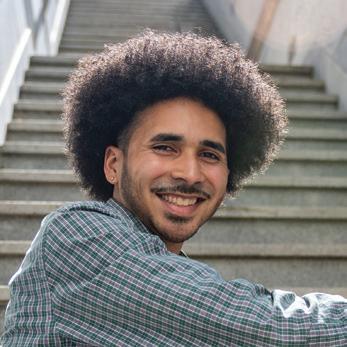
TERRENCE LURRY 25C
Marion Luther Brittain Award
Presented to an undergraduate who has provided exceptional service to Emory University through leadership, character, and commitment to community
For most of his undergraduate years, Terrence Lurry served as a leader with Campus Life, helping to foster a sense of belonging and community among students. A QuestBridge Scholar and first-gen student, Lurry worked with the Belonging and Community Justice team to build Emory First, a hub for first-generation, lowincome students, and served as executive student director. He also served as a leader with Wonderful Wednesday, Emory Black Men’s Initiative and Graduation Generation. An aspiring anesthesiologist assistant, he earned his bachelor’s degree in chemistry and a minor in ethics.

ROSELINE JEAN LOUIS 25PHD
Marion Luther Brittain Award
Presented to a graduate who has provided exceptional service to Emory University through leadership, character, and commitment to community
A single mother of four and former labor and delivery nurse, Roseline Jean Louis returned to school after a 12-year break, earning her bachelor’s degree in nursing at Emory in 2018 and her PhD in 2025. She served on the School of Nursing’s Committee on Community and Diversity, was elected president of the PhD Nursing Student Association by her peers and co-chaired the Laney Graduate School’s Black Student Taskforce. Her work in maternal health equity — including as a National Birth Equity Research Scholar — reflects her commitment to systemic change in care and community health.
BEE THE CHANGE
How Emory student Mikaila Ulmer turned childhood bee stings into a sweet, purposedriven business — and continues to buzz with ambition. >> BOLD IDEAS
BY ROGER SLAVENS
Sometimes when life gives you lemons, you make lemonade. When Mikaila Ulmer 26C got lemons — two unexpected honeybee stings in a week at the age of 4 — she turned the scary ordeal into a national lemonade brand, a nonprofit foundation and a movement to save her newfound flying friends.
“My immediate reaction was to be terrified by the bees,” Ulmer says. “But my parents encouraged me to learn about them instead of staying afraid, taking me to our local library where I read picture books, watched videos — one set to the classical song ‘Flight of the Bumblebee’ — and became completely fascinated by them. Obsessed, even. I also learned how essential honeybees were to our food system and that they were in trouble.”
Ulmer knew she had to help.
That same summer in 2009, she started a front-yard stand selling lemonade, sweetened with honey and made with her Great Granny Helen’s
1940s flaxseed recipe. A portion of the profits went to bee conservation. The buzz was good — people loved the drink and her story. She took the stand on the road, spreading her wings by selling lemonade at local fairs in her hometown of Austin, Texas. “That’s how Me & the Bees Lemonade was born,” she says.
BUILDING THE HIVE
Ulmer wanted her business — and her urgent mission to save the bees — to take flight, but the lemonade stand approach limited her. The turning point came two years later when a local pizza shop owner, impressed by Ulmer’s product and her storytelling, told her that if she could bottle the lemonade, he’d carry it. With help from her parents, who supported her ideas wholly “right from the start,” she found a commercial kitchen used by a salad dressing company that could bottle the drink. “I started small, personally delivering cases to local shops,” Ulmer says. “Then a Whole Foods store picked us up for Pollinator Week. It did so well, it turned into a permanent placement. Everything grew from there.”
In 2015, she pitched her business on ABC’s Shark Tank and landed a $60,000 investment from Daymond John. Ten years later, Me & the Bees is stocked in more than 600 stores nationwide, including Whole Foods, Target and H-E-B.
But for Ulmer, the business was always about combining purpose with
profit. In 2016, she founded the Healthy Hive Foundation, which focuses on protecting all bees — especially wild and native species most at risk.
“The mission has evolved greatly over time,” she says. “In addition to saving the bees and making great-tasting lemonade at Me & The Bees, Healthy Hive helps us protect pollinators through research, education and active habitat protection.”
BALANCING BEING A STUDENT WHILE RUNNING A COMPANY
Now 20, Ulmer is a rising fourth-year student at Emory, studying economics and quantitative sciences as a Woodruff Scholar, the university’s highest merit-based honors program.
She credits her studies with helping her see both her business and the broader economy through a new lens.
“I always wanted to invest in companies like mine — minority-owned, mission-driven, youth-led,” she says. “Economics and QSS give me the analytical tools to do that. I’ve gone from thinking like a founder to also thinking like an investor.”



LEMONADE LEADER
Mikaila Ulmer started her business at age 4.
She’s also a Robson Fellow at Emory’s Goizueta Business School, a program for students exploring public policy, macroeconomics and social impact.
“Those conversations have been transformational,” she says. “I’m excited to be mentored by professors like Jeff Rosensweig and surrounded by other students with big ideas.”
Managing school and her business is no small feat. “I’ve had to get really good with my calendar, lean on my team and say no to things I can’t take on,” she says. “Luckily, it’s truly a family-run company, which comes with challenges but also trust, shared values and a lot of heart. It makes it easier for me to manage from afar.”
finds synergy between the two — like using beverage market data for QSS class projects.
A MISSION WITH WINGS
Ulmer’s entrepreneurial impact has earned national acclaim. In 2016, she introduced President Barack Obama at the United State of Women Summit. A year later, she was named one of Time Magazine’s 30 Most Influential Teens. In 2020, she authored “Bee Fearless: Dream Like a Kid,” a business memoir designed to inspire young changemakers.
But her purpose remains rooted in something simple: doing good.
“Our generation sees so many prob lems that it’s easy to feel paralyzed,” she says. “But passion grows as you act.
like a CEO. “Kids don’t see limitations — they just see what could be,” the young entrepreneur says. “If you pair that kind of dreaming with research, action and a strong community, there’s no limit to what you can create.”
Looking ahead, Ulmer plans to continue digging deep into her studies at Emory, possibly pursue graduate school and ultimately enter the world of private equity or venture capital — becoming the kind of investor she once needed to get her big idea off the ground.


CANDLER CONCERT SERIES
Harlem Quartet featuring Aldo López-Gavilán, piano Friday, September 26, 2025 at 8 PM
Murmurs in Time Third Coast Percussion and Salar Nader, tabla Friday, October 17, 2025 at 8 PM
Cameron Carpenter, organ Friday, November 7, 2025 at 8 PM
Vikingur Ólafsson, piano
Thursday, January 29, 2026 at 8 PM

Emory Jazz Fest 2026
Schwartz Artist in Residence Friday, February 6, 2026 at 8 PM
Sphinx Virtuosi with Sterling Elliott, cello Thursday, February 19, 2026 at 8 PM
An Evening with Itzhak Perlman Thursday, March 26, 2026 at 8 PM
Catalyst Quartet with J’Nai Bridges, mezzo-soprano and Terrence Wilson, piano Friday, April 10, 2026 at 8 PM


PROMISING TREATMENT FOR EPILEPSY
Epilepsy is a persistent brain disorder that produces hard-to-control seizures and cognitive impairments in 1.2% of the U.S. population. It can be treated and sometimes managed but never cured.
Now, Emory researchers have discovered genetic pathways to address the stubbornly difficult challenge of alleviating epileptic seizures.
The researchers were part of a multi-institution team studying the chemical pathways that control entire networks of genes in mice to find patterns of gene activation associated with epileptic attacks. Armed with this knowledge, they used the existing drug tofacitinib to suppress seizures in the mice for weeks at a time
Nicholas Varvel, assistant professor in the Department of Pharmacology and Chemical Biology, published his research in Science Translational Medicine, representing an advance over current treatments that mostly address symptoms.
“This was one of the first, if not the first, demonstrations of true disease modification,” he says. “We looked at the
spontaneous seizures that are occurring in these animals and they were remarkably and enduringly suppressed for up to two months.”
Researchers investigated how certain brain conditions, such as brain injury or tumors, might lead to epilepsy. Using a data-mining tool called MAGIC, they analyzed more than 6,000 genes in epileptic mice to determine transcriptional signaling pathways — the chemical processes that turn genes off and on — that were most associated with epilepsy.
The team found certain clusters of genes were repressed after epileptic attacks while other groups increased their expression. The group that stood out was switched on by one set of genetic signaling proteins that were later repressed by a different protein. Then they got a surprise.
“The real peculiar thing here was that this pathway was engaged after the initial seizure,” Varvel says. “And then it was re-engaged in the time when the brain had epilepsy. So it seems there's a sort of two-fold engagement.”
The researchers turned to tofacitinib, an existing drug formulated to inhibit the JAK/STAT gene activation process as a treatment for rheumatoid arthritis.
When they administered the drug to epileptic mice, the first wave of epileptic attacks continued. Unexpectedly, though, they found that using the same drug to target the second wave of attacks produced strong results: an 80% reduction in severity and frequency of seizures. Additionally, eight out of 10 mice were seizure-free a month after they stopped administering the drug. There was also strong cognitive improvement.
To validate the drug’s effectiveness, the team replicated their experiments in labs nationwide with similarly strong results, and though the precise cellular mechanism remains unknown, they plan to investigate it further.
“This was one of the first, if not the first, demonstrations of true disease modification.”
— NICHOLAS VARVEL
ASSISTANT PROFESSOR, DEPARTMENT OF PHARMACOLOGY AND CHEMICAL BIOLOGY
Varvel believes tofacitinib ultimately may have an easier path to clinical applications in humans because it’s already on the market for rheumatoid arthritis. Before clinical trials, he wants to study a human population already using tofacitinib to see if they exhibit a lower incidence of epilepsy.
— Tony Van Witsen
>> RESEARCH EXCELLENCE
>> EDUCATIONAL INNOVATION
Helping Students Bring Ideas to Life
The Stuart and Mimi Rose Program will help equip undergraduates across disciplines with the skills, mentorship and resources to launch new ventures.
When Anthony Vargas 24Ox 26C was a child, he suffered headaches so severe he would scream into his pillow. At 14, he lost movement in his left hand. Doctors discovered an arachnoid cyst the size of a small lemon pressing against his brain. Emergency surgery saved his life.
Postrecovery, Vargas, an athlete and New Jersey sports fan, had to play basketball wearing a rugby helmet. Opposing players mocked him. He thought there had to be a better solution but he couldn’t find an alternative. So he created one.
Vargas built a prototype with his girlfriend’s volleyball knee pads. He called it the Chrome Dome, and it still sits on a shelf at home next to the rugby helmet.
He enrolled and played basketball at Emory University’s Oxford College, where his interest in entrepreneurship soared. After moving to Emory College of Arts and Sciences, the pre-med psychology major has continued to refine his rudimentary Chrome Dome design. His new device, Safe Squeeze Headgear, is a more stylish option targeted specifically to youth athletes. “I want to make safety fun,” Vargas says, “not just make fun safe.”
With support and mentorship from The Hatchery, Center for Innovation and the Goizueta Center for Entrepreneurship and Innovation, he has pitched his idea more than 100 times, collaborated with youth coaches across three states and is seeking an engineer to help optimize his product.
Vargas’ story captures the heart of a new initiative launching in the 2025–26 academic year: The Stuart and Mimi Rose Program for Student Startups. Designed to empower student entrepreneurs across all disciplines, the Rose Program will offer a series of courses, programming and mentoring opportunities open to students inter-
ested in founding their own ventures.
Housed in The Hatchery and administered through Goizueta, the program engages students from the start, with a week-long Ignite preorientation course focused on innovation for incoming first-year Oxford College and Emory College students. It continues with a three-course academic sequence focused on experiential learning, innovation and mentorship. After completing a foundational course, students can apply to become Rose Program Fellows and gain access to advanced training and a 10-week Summer Accelerator.
The program is intentionally inclusive, welcoming students from all majors. “Mimi and I believe great ideas can come from anyone, anytime, anywhere — no matter their background or academic major,” says Stuart Rose 76B. “We want every Emory student to feel like they have a chance to bring their ideas to life. Funding this program is our way to help make that happen.”
The Roses’ vision aligns closely with Emory’s broader goals around innovation and impact.
“Entrepreneurship really embodies Emory’s mission — it’s about figuring out how to apply knowledge and discovery to benefit society and expand impact,” says Wilbur Lam, vice provost for entrepreneurship.
Ben Garrett, The Hatchery’s director, believes that entrepreneurs thrive within a supportive ecosystem. “This is why, in addition to best-in-class instruction offered via the Goizueta Business School, The Hatchery will provide Rose Program participants with the ideal environment for student founders to succeed,” he says. “These students won’t just learn theories about entrepreneurship — they’ll be actively building their businesses in an environment that supports them every step of the way.” — Shawn Reeves
>> FACULTY EMINENCE

GREAT DEBATE
Mikaela Malsin named National Coach of the Year.
“When I think about Emory and my students and colleagues, I know I’ve found everything I could have had as a professor, and so much more, as a debate coach with Barkley Forum.”
The 22-year-old Malsin was stunned — but absolutely delighted. Wade’s comment was both an endorsement of the student’s skills as a debater and a prediction that an exciting career awaited her in the world of intercollegiate debate.
“I remember feeling a special thrill unlike any other,” Malsin says. “To hear a person of Melissa’s stature suggest to that audience that one day my contributions to our field might be mentioned in the same sentence with hers, Ross Smith’s and other debate coaches of similar prominence — it was probably the single most inspiring moment of my life.”
Today, Malsin serves as director of debate for Emory’s Barkley Forum. And she lived up to Wade’s expectations by winning the 2025 Ross K. Smith National Coach of the Year Award. Presented annually, the award recognizes lifetime achievement in coaching intercollegiate debate.
THE DATE WAS NOV. 21, 2009. The place was Wake Forest University. The occasion was the renaming of the National Coach of the Year Award, created in 1967, to honor the late, beloved debate coach Ross K. Smith.
The speaker was Melissa Maxcy Wade, executive director of forensics at Emory, the university’s former debate director and the 1991 recipient of the National Debate Tournament (NDT) National Coach of the Year Award. She was also one of the most respected members of the intercollegiate debate community.
Mikaela Malsin 10C, at the time an Emory senior and Barkley Forum debater, listened intently as Wade addressed hundreds of college debaters and their coaches at the annual gathering of the nation’s premier intercollegiate debate association. Then the unexpected happened: Wade mentioned Malsin’s name.
As Wade concluded her tribute to Smith, she named three young debate coaches from other schools and one Emory debate student: Malsin. Wade expressed her expectation that one day those four might each present the award being dedicated to Smith that evening and “keep the spirit and heart of its honoree alive, as I hope I have done tonight….”
Each year since 2021, when Malsin became Barkley Forum leader, the program has reaffirmed its position as one of the nation’s top intercollegiate debate programs.
The Barkley Forum has received three bids each season to attend the National Debate Tournament since Malsin’s arrival, seven of which were first round at-large (top 16) bids. During that time, an Emory student team has ranked third or better in the nation at the end of the regular season, including receiving the 2024 Copeland Award for the overall top two-person debate team in the country.
Malsin’s love of debate began when she joined her New Hampshire high school’s debate program, which her older brother helped establish when he was a student. Four years later, it was time for Malsin to choose a college.
“When I visited Emory as a high school senior, I fell in love with the university, and the rest, as they say, is history,” Malsin says.
Previously, Malsin served as director of debate at Georgetown University and as a debate coach at Wake Forest University, University of Georgia and Emory.
“I realized that everything I’ve done since college was geared toward becoming the best director of debate that I could possibly be,” says Malsin, who briefly considered a more scholarly career teaching in higher education. “When I think about Emory and my students and colleagues, I know I’ve found everything I could have had as a professor, and so much more, as a debate coach with Barkley Forum.” — John Baker Brown 99T
WHERE TRADITION MEETS HIGH-TECH SCHOLARSHIP
BY ASHLEE GARDNER
IDigital humanities at Emory foster a deeper understanding of the world we live in.
n the early days of computing, Jesuit scholar Roberto Busa embarked on an ambitious project with the help of IBM. The project, which began in 1949 and lasted 34 years, resulted in the “Index Thomisticus” — a digital concordance of the complete works of Thomas Aquinas. Requiring an estimated 10 million punch cards, the encoded text contained roughly 11 million words that could be sorted, indexed and analyzed to discover previously unseen trends.
Today, Index Thomisticus is known as one of the first digital humanities projects. This first ever e-book laid the foundation for a long tradition of using computational methods and digital tools to gain new insights into humanities subjects like art, philosophy, history and literature.
As the field of digital humanities has expanded and gained prominence in the early 21st century, Emory University has committed to innovative approaches that combine technology and liberal arts to address ethical and societal challenges while unearthing stories that matter.

With punch cards a distant memory, faculty and students are now applying sophisticated digital tools — from 3D modeling to text mining to large-scale data analysis — to recreate historical archeological sites, analyze legislative records to track shifts in government policy and understand trends in the publishing industry.
By leveraging interdisciplinary collaboration in humanities, quantitative theory and methods, computer science and artificial intelligence, Emory scholars are providing new insights into historical, cultural and political topics — integrating technological innovation with humanistic inquiry to foster a deeper understanding of the world.
NEW VIEWS Beck Miller is one of several student researchers with the Emory Digital Humanities Lab.
INTERDISCIPLINARY RESEARCH AIDED BY TECHNOLOGY
Jo Guldi, a professor in the Department of Quantitative Theory and Methods (QTM), was recruited to Emory through the university-wide AI.Humanity initiative in 2023 and describes her arrival here as a “homecoming.” She says the AI.Humanity initiative, which builds on Emory’s intellectual strengths to shape the AI revolution, offers a collaborative and enthusiastic environment for her work with “the most robust community of digital humanists anywhere in North America.”
As one of the founders of the subfield of digital history, Guldi transforms traditional humanities research by using AI and machine learning, particularly text-mining tools, to sift through vast historical, economic, legal and sociological datasets to understand changes in culture, ideas and political institutions over time.
“The growing volume of digitized historical records makes grappling with this tsunami of information impractical,” says Guldi. “AI tools can democratize historical research by making archives and resources more accessible. Researchers can analyze global trends, uncover connections across time and geography and better visualize complex historical processes.
For example, AI might reveal shifts in political discourse or social movements that would otherwise remain unnoticed.”
As part of the Emory Climate Research initiative, Guldi is currently collaborating on a project with Mindy Goldstein, clinical professor of law and director of the Turner Environmental Law Clinic, and Yang Liu, chair and Gangarosa Distinguished Professor in the Gangarosa Department of Environment Health at the Rollins School of Public Health.
The team is using LLMs to compile data on climate-related laws and policies in Georgia, starting with a taxonomy of county ordinances governing solar panels. Their methodology can be extended to track data and trends across multiple climate initiatives from electric vehicle infrastructure to urban farming, and from flood mitigation to water conservation. By visualizing this information and layering in public health data, they can provide a full picture of what is working for local communities. This will enable comparisons of future scenarios and support more informed policy decisions for climate action.
"We asked: what can a historian do with AI in the context of climate research? The use of language models
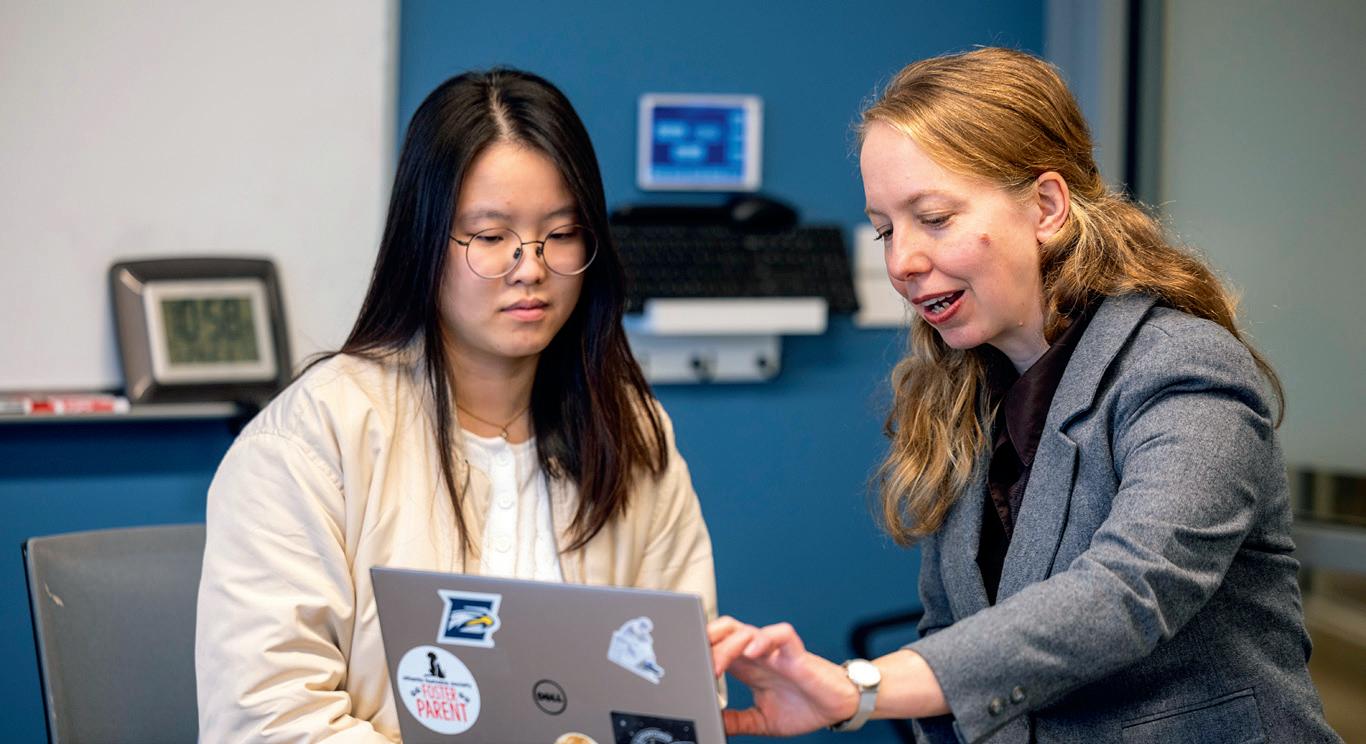
“At Emory, the digital humanities transcend the act of merging data with discourse; they serve as a catalyst for amplifying the voices and narratives that define our world. By weaving together technology and human curiosity, we empower scholars to rethink the essence of knowledge – how it’s created, shared and safeguarded for the future. This is not just innovation; it’s a commitment to preserving the human story in all its depth and complexity for generations to come.”
— Barbara Krauthamer Dean, Emory College of Arts and Sciences
will help link isolated information and policy, uncovering the dynamics of decision-making at local and state levels. Building this project across different disciplines and leveraging technology provides a ‘ground truthing’ for evaluation and action,” says Liu.
USING DATA TO UNCOVER HIDDEN TRUTHS
An institutional focus on digital humanities is supported by Emory’s publishing wing, the Emory Center for Digital Scholarship, which fosters the development of open-access, digital journals. These include Southern Spaces, Nonsite and Post 45, which was brought to the university in 2019 by Dan Sinykin, associate professor of English.
Branching off the Post 45 journal, Sinykin started the Post 45 Data Collective, a peer-reviewed, open-access repository for literary and cultural data from 1945 to the present.
Making literary and cultural data from this period more accessible and valuable has generated a wealth of powerful scholarship, according to Sinykin. For instance, one dataset provides 100 years of data on major lit-
NEW SKILLS Jo Guldi (right) and student Latifa Tan discuss text mining during a QTM seminar.
erary prizes. In addition to identifying the prize and the name of the winning author, it also contains the names of the prize judges, the author’s academic degrees and their advisors.
“The data shows how much more likely a writer is to win a major award if they earned an MFA from the Iowa Writers' Workshop or a BA from an Ivy League school; and it shows how the circulation of prizes is insular among insider networks,” explains Sinykin.
Other datasets include New York Times hardcover fiction bestsellers, records of Nordic crime fiction translations and winners of literature prizes from the National Endowment for the Arts.
In August 2024, Sinykin was awarded a National Endowment for the Humanities grant that will allow his team to build on the existing digital infrastructure and achieve interoperability between complementary datasets.
“We want to continue to build on these datasets and potentially use AI to allow them to talk to each other so that researchers can create a bigger
“Digital history has the winning ticket for designing AI that is factually reliable. Historians have tools for thinking about how to get from many words to a consensus around fact, evidence and data. Silicon Valley should be talking to us. Interdisciplinary collaboration is the best route to move from an AI of rumor, hearsay and hallucination to an AI that delivers truth on demand to high-stakes disciplines like medicine, law and finance, where facts drive decisions.”
— Jo Guldi, Professor Department of Quantitative Theory and Methods
and bigger map of sociological factors that influence the world of literature,” says Sinykin. “Who is most likely to get a publishing deal or a literary award? How do race, education and even personal connections influence those odds?”
Sinykin also explores the intersection of AI, humanities and social justice as a member of the steering committee for the Atlanta Interdisciplinary Artificial Intelligence (AIAI) Network. Directed by Lauren Klein, associate professor in the Departments of Quantitative Theory and Methods and English, and funded by a $1.3 million grant from the Mellon Foundation, the AIAI Network unites scholars from across Atlanta institutions to foster interdisciplinary research and public engagement that blends humanistic ways of thinking with technical expertise.
“We brought together partners from Clark Atlanta, Georgia Tech and the DataedX Group to highlight Atlanta as a leading example and center for research for digital humanities. Atlanta’s diversity and historic role in the civil rights movement provides a strong foundation for advancing ethical AI research and innovation across multiple fields,” Klein says.
EMBEDDING DIGITAL HUMANITIES INTO EMORY EDUCATION
Emory’s role in community building and collaboration between humanities scholars and technical researchers is rooted in a deep commitment to digital humanities within its own walls.
Klein, a longstanding leader in the field of digital humanities and editor of the field-defining “Debates in the Digital Humanities” book series, describes Emory’s focus on digital humanities as unique among peer institutions and “fundamentally interdisciplinary.” The community

is anchored by faculty who integrate technical sophistication with humanities research and teach a wide variety of undergraduate and graduate courses in areas ranging from quantitative literary analysis to digital scholarship and media studies to data and archives.
One mechanism for study is a Quantitative Sciences (QSS) degree, which functions almost like a double major combining core QTM courses with additional courses in other disciplines like film, marketing, classics, history and political science. Graduate students can also earn a Certificate in Digital Scholarship and Media Studies (DSMS) through the Laney Graduate School.
“Emory’s digital humanities curriculum is very customizable. At the center of the QSS degree, for example, is a fundamental understanding of the mathematical and statistical basis of digital tools and methods. But beyond this technical core, students can push forward in several different directions,” says Klein. “If your interest is in society and culture, you can learn the core and then go in that direction. If your inter-
NEW TEAMS Professor Lauren Klein (second from right) meets with students (l to r) Dani Roytburg, Odelia Larbi-Amoah, Margy Adams and Beck Miller in her Digital Humanities Lab.
est is in statistics or computer science, you can go in that direction.”
Experiential learning opportunities are also available through Emory’s Center for AI Learning and individual research labs.
Junior Odelia Larbi-Amoah 26C, for example, has worked on a variety of projects through Klein’s Digital Humanities Lab. As a double major in QSS and Women, Gender and Sexuality Studies, the issue of bias in technology is a focus for her.
One of the projects she worked on involved using census data to assess how well large language models recognize names that aren’t traditionally American and whether gender can be correctly inferred from them. Expanding datasets to include names from non-English-speaking countries can provide more inclusive outcomes when using data to make decisions about social policies.
“A software engineer may let their individual bias slip into their code, which can affect a lot of people once it’s released. When we have humanities intersecting with tech, we can consciously break down stereotypes to enhance coding practices and hopefully cut off bias before it becomes a bigger issue,” says Larbi-Amoah.
Dani Roytburg 25C is a recent grad who majored in computer science and QTM. His choice of study stemmed from broad interests that include politics, debate and architecture. Roytburg was fortunate to meet with Klein early in his undergraduate experience, which led him to add QTM as a major and join her lab.
“I was looking for a way to merge technical rigor with the adaptability of debate,” says Roytburg. “Using modern systems to analyze text at scale and understand and answer research questions in the humanities and social science contexts is the perfect
merging of technology and creativity.”
As part of a Digital Humanities Lab project, Roytburg joined a combined student and faculty team to work on another study involving the language of online social movements.
The research explored how political ideas move from the margins to the mainstream, and which groups, such as activists, politicians or the media, are responsible for introducing these new ideas into public discourse. To conduct the analysis, Roytburg developed his own model of online language change using advanced AI techniques.
Roytburg values this bidirectional approach to digital humanities, saying, “I’m not only employing state-of-the art technologies to understand the political culture but also using research techniques and decades-long scholarship in the humanities to develop new uses of AI itself.”
ACCESS, CONVERGENCE AND TRUTH-TELLING
Digitizing content has allowed for the democratization of vast amounts of information. Text on a page read by just a few people can now be viewed and consumed by anyone with access to a computer. Scholarly research, novels, artwork and historical records are at our fingertips.
Combining this data with computational methods and digital tools to push the boundaries of traditional humanities education and research opens scholars to even more insights and expands the impact of their work. A simple spreadsheet can be transformed into a user-friendly interactive map, a dataset can resurrect answers to questions lost to history and hidden patterns can emerge from writings of the past.
While technology can breathe life into humanities research, it is
RESOURCES
AND SUPPORT FOR DIGITAL HUMANITIES AT EMORY
Digital Publishing in the Humanities Initiative
Based at the Fox Center for Humanistic Inquiry, the initiative supports the development and publication of digital and open access monographs by faculty at Metro Atlanta institutions. The initiative also provides funding and expertise on digital publishing options.
Emory Center for Digital Scholarship (ECDS)
In addition to hosting digital journals like Post 45, ECDS collaborates with faculty, students and external institutions to produce innovative models of digital scholarship via multimedia production, digital exhibits, network and text analysis, and virtual/augmented reality, among other methods. ECDS also integrates digital pedagogy into classrooms, advancing research and outreach in the digital humanities.
Project Management for the Digital Humanities
This collaboration between ECDS, Emory Libraries and the Information Technology Services Project Management Office provides free curriculum for managing digital projects in libraries and other settings.
important to remember the reciprocal influence between the two, says Klein — humans shape technology just as much as technology shapes us.
“Digital humanities is about approaching technology from a humanistic perspective,” says Klein. “The focus is on two things at once: how digital technologies can be used to address humanistic research questions and how humanistic ways of thinking can be used to understand and inform the use of digital technologies. Emory has the right people and infrastructure in place to model how this important work should be done.”
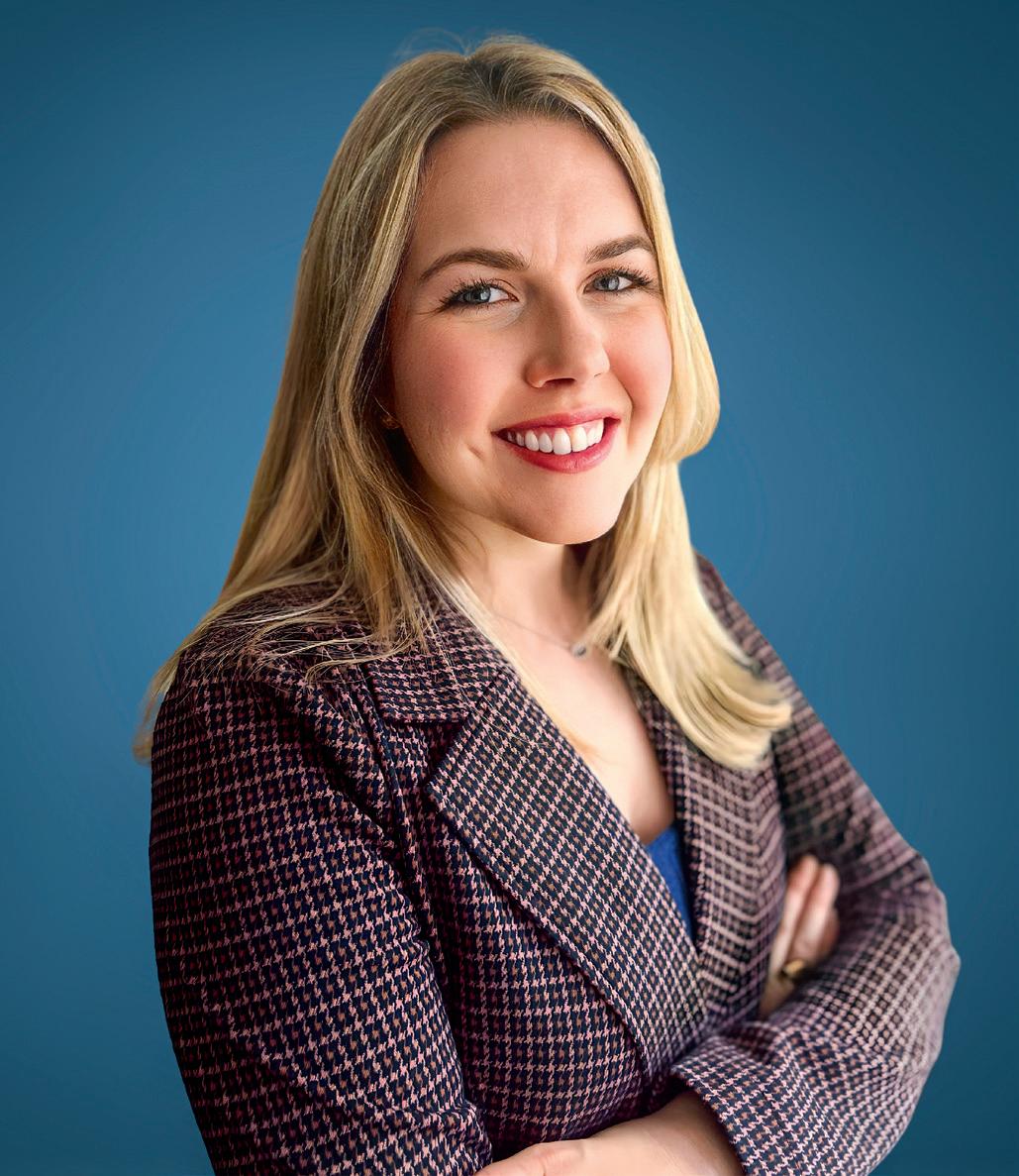
>> ALUMNI Q&A
SMARTER LIVING THROUGH ARTIFICIAL INTELLIGENCE
Alumna Celia Quillian wants everyone to see how accessible AI can be — and how it can genuinely improve life at home and on the job.
BY ROGER SLAVENS
Celia Quillian 22MBA thinks it’s time to stop freaking out about AI — and start having fun with it. In 2023, she launched SmartWorkAI on TikTok and Instagram to help people wrap their heads around tools like ChatGPT and discover how surprisingly useful (and not-so-scary) AI can be in daily life — whether planning a trip, writing a cover letter, or just trying to get through your inbox.
Now with more than 180,000 followers, Quillian’s SmartWorkAI serves up quick, practical tips that make integrating AI into your routine feel less like a tech leap and more like a life hack. Her book “AI for Life: 100+ Ways to Use Artificial
MAKING SENSE OF IT
Celia Quillian helps people learn how to use AI in everyday life through her social platform SmartWorkAI.
Intelligence,” published in January 2025 by Simon & Schuster, expands on that mission. It’s part guide, part confidence boost for anyone curious but hesitant to try AI.
Emory Magazine caught up with Quillian to talk about her journey from Goizueta Business School MBA student to AI influencer — and why she believes there’s never been a better time to embrace the tools shaping the future.
EMORY MAGAZINE: WHAT FIRST SPARKED YOUR INTEREST IN AI AND WHAT MADE YOU WANT TO SHARE THAT KNOWLEDGE WITH OTHERS?
CELIA QUILLIAN: Believe it or not, I launched my SmartWorkAI social media platform just a few months after I tried ChatGPT for the first time. I was excited about playing with AI and was surprised how much it could help me at work and home. However, when I looked at my social feeds for further guidance, I discovered that most content on generative AI tools was presented in an overly technical and complicated way — stuff that would easily overwhelm the average person. So I created posts and videos I felt would be less intimidating and give helpful advice for leveraging the power of AI in everyday life. Deep down, I could tell this technology was going to change how we did everything, how we told stories, how we engaged at work and got things done in our daily lives. And I think being new to AI myself — not some machine learning PhD — helped me present it in a relatable, beginner-friendly way.
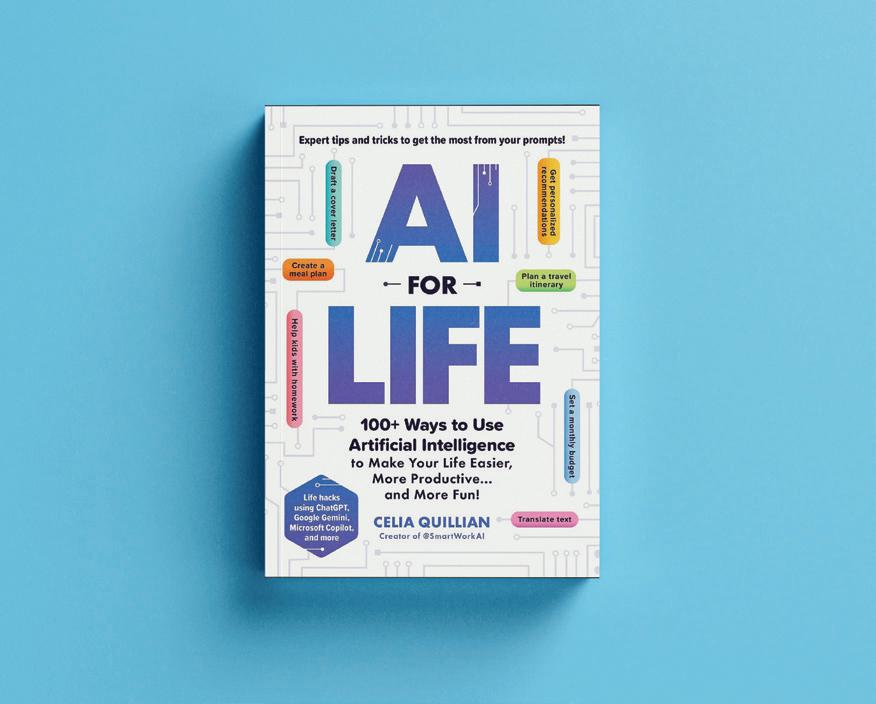
E M: WHAT’S THE BEST WAY FOR SOMEONE NEW TO AI TO START USING TOOLS LIKE CHATGPT?
QUILLIAN: The best approach is to pull up one of these generative AI tools like OpenAI’s ChatGPT, Google Gemini or Microsoft Copilot — all of which have free versions — and just start a conversation. Ask a question you’re curious about, something you might normally Google. You’ll often get a more detailed and thoughtful answer than a standard search result. Also, try to use it every day, even for small tasks, so you get comfortable and start seeing what it can really do.
EM: WHAT ARE SOME OF THE MOST USEFUL WAYS AI CAN HELP WITH EVERYDAY TASKS?
QUILLIAN: Travel planning is a great starting point. In fact, I say that travel is the “gateway drug” to using generative AI since it can handle so much of the mental load: where to go, what to do, what fits your budget. Input some basic parameters for your vacation and it can suggest sample itineraries, complete with recommended activities, restaurants and hotels. Generative AI is also fantastic for meal planning, grocery lists, brainstorming work ideas, in-depth research, budgeting, and even acting as a sounding board for your thoughts and feelings. My book features more than 100 use cases to explore.
EM: ARE THERE THINGS PEOPLE SHOULD BE CAREFUL ABOUT WHEN USING GENERATIVE AI?
QUILLIAN: Don’t upload ultra-personal information like Social Security numbers or bank account details. You can ask for financial or budget advice from AI, but don’t share sensitive data because these tools are online and at risk for data breaches. Also, always fact-check important details. AI can pull from unreliable sources when browsing for answers or sometimes “hallucinate” — basically make stuff up. And finally, I believe strongly that everyone who uses generative AI should remember that while it’s a helpful tool — it’s not a replacement for your brain.
EM: WHAT ARE SOME OF THE MOST CREATIVE WAYS YOU'VE SEEN PEOPLE USE AI IN THEIR PERSONAL LIVES?
QUILLIAN: My neighbor used the new image model in ChatGPT to help redesign her kitchen. She uploaded a photo of her existing kitchen along with some prompts. ChatGPT, with its new image generation model, was able to visualize for her different countertops, paint colors and cabinet hardware. She was thrilled! I’ve also seen people use AI as an all-in-one partner for healthy living — helping them plan meals, stay on track with fitness and weight loss goals, and offering the kind of personal coaching that keeps them motivated.
EM: WHAT’S COMING NEXT IN AI THAT EXCITES YOU MOST?
QUILLIAN: I'm really intrigued about agentic AI — tools that act like personal assistants and complete tasks for you through your computer. For example, instead of just suggesting a trip, these “agents” may soon be able to actually book the flights, hotels and activities on your itinerary. They could help schedule medical appointments. Or browse and buy personalized gifts online. What perhaps excites me most is that this
could actually help us spend less time on screens and more time being present.
EM: YOU CREDIT GOIZUETA MARKETING PROFESSOR MARINA COOLEY IN THE AUTHOR’S FOREWARD OF YOUR BOOK. HOW DID SHE INFLUENCE YOUR PATH?
QUILLIAN: Even after graduation, Marina Cooley continues to be a beloved mentor. She is just a dynamo of a woman. Marina taught a content marketing class on sticky storytelling — how to hook people into your story, especially on visual platforms like TikTok and Instagram. That class was eye-opening. I’d never really used TikTok before, but it inspired and helped me when I started SmartWorkAI. Even now, Marina encourages me to ask tough questions about my work and goals: What are you doing this for? Why? What’s the bigger picture? She’s been a huge influence on my success.
Deep down, I could tell this technology was going to change how we did everything, how we told stories, how we engaged at work and how got things done in our daily lives.
EM: YOU HAVE A DAY JOB THAT USES AI. WHAT IS IT?
QUILLIAN: I am director of AI and Growth at Greenlight Financial Technology here in Atlanta. We offer a debit card for kids and a financial education app that parents manage, along with a suite of safety features for the family. I started as a product marketer during my MBA and now work on the innovation team, where I evaluate AI tools and use them to make our company more efficient and effective.

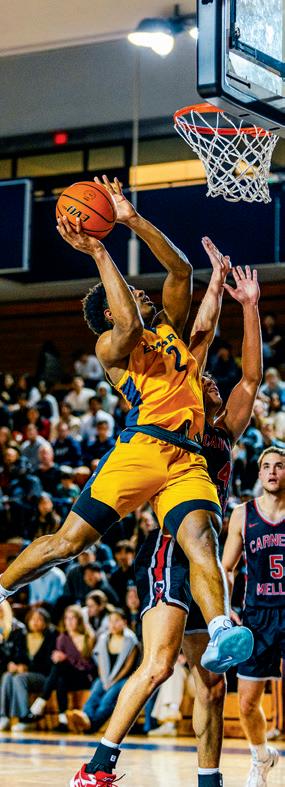

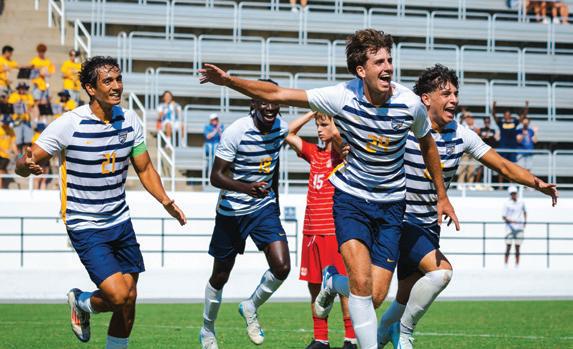
FIRECE COMPETITORS Emory athletes brought their best across all sports this past year.
>> ATHLETIC ACHIEVEMENTS
A YEAR TO REMEMBER
Emory Eagles soar to new heights in 2024–25.
Across courts, fields and pools, the Emory Eagles delivered one of the most successful athletic years in school history, culminating in winning the 2024–25 Learfield Directors’ Cup as Division III’s most successful athletics program overall. Here are some of the Eagles’ brightest highlights:
GOLF
Women’s Golf captured the NCAA DIII National Championship, the team’s second title, and set an all-time record for lowest four-day total score.
Carys Code won the women’s individual national golfing title, the second in program history, and also set an all-time record for lowest four-day total score at the championship.
Men’s Golf won the program’s 22nd UAA Championship and tied its best NCAA DIII National Tournament showing with its second-straight third-place finish.
Kevin Mu set an Emory record with his four-round score and finished third on the national individual leaderboard, earning First Team All-America honors.
BASKETBALL
Men’s Basketball advanced to the NCAA DIII Elite Eight, the team’s first appearance since 2014 and second ever.
TRACK & FIELD (INDOOR & OUTDOOR)
Nikki Boon won a national title in the Women’s Indoor Pentathlon, breaking the NCAA DIII record and becoming the first DIII woman to surpass 4,000 points. Her achievement marked the second-ever individual indoor national championship in program history for the Eagles. She followed that up by winning another national title in the Women’s Outdoor Heptathlon this spring.
Eva Carchidi became the first woman and second Eagle overall to win the NCAA DIII Outdoor 400m Dash national title in Emory history.
Men’s Outdoor Track & Field won the UAA Championship for the first time since 2015 and its seventh overall.
Women’s Outdoor Track & Field posted their best UAA finish since 2016.
SOCCER
Women’s Soccer reached the NCAA DIII Final Four for the second time ever, first since 2012.
VOLLEYBALL
Women’s Volleyball returned to the NCAA DIII Quarterfinals for the first time since 2019 (13th overall appearance).
The team claimed the program’s 11th UAA Championship.
CROSS COUNTRY
Women’s Cross Country equaled its best national finish ever with 7th place at the NCAA DIII Championships.
Men’s Soccer captured back-to-back University Athletic Association (UAA) titles, the program’s ninth overall.
TENNIS
Women’s Tennis advanced to the NCAA DIII Team National Semifinals.
Men’s Tennis reached the NCAA DIII Team National Quarterfinals.
SHORT LIST
SWIMMING & DIVING
Men’s Swimming & Diving finished as national runner-up at the NCAA DIII Championships.
Women’s Swimming & Diving placed 5th nationally.
Both teams won their 26th consecutive UAA titles.
Henri Bonnault (100 Breaststroke) and Liyang Sun (200 Breaststroke) won individual national championships in Men’s Swimming.
The Men’s 200 Medley Relay team (Bonnault, Jeff Echols, Nolan Lahmann, Dylan Yin) claimed a national title.
Four Eagle swimmers received the prestigious NCAA postgraduate scholarship.
SOFTBALL
The Eagles softball team advanced to the NCAA DIII Super Regional for the third time in the past 10 years.
BASEBALL
The Eagles baseball team made the NCAA DIII National Tournament for the first time since 2017.
ACADEMIC & NATIONAL RECOGNITION
70 Emory Eagles earned All-America honors and 13 student-athletes were named CSC Academic All-Americans.
Emory Athletics won the Learfield Directors' Cup, DIII's highest program honor.
LIFELONG LEARNER
At age 86, Hurl Taylor 85L 86L 16T 25B was the oldest graduate in Emory’s class of 2025. And it’s not the first time he’s held that distinction. He was also the oldest graduate in the class of 2016, when he completed a master’s of religion and public life at Candler School of Theology. This time around, he graduated with a master’s in business for military veterans through a new program offered by Goizueta School of Business. He also has two more from Emory: a 1985 juris doctorate and a 1986 master’s in litigation, both from the law school. He has five additional advanced degrees from other institutions. “I have been accused of being a lifelong learner, and I plead guilty to it,” Taylor says. And he won’t rule out another Emory degree. “If you offer a program that I like, look out,” Taylor says. “You’ll have a hard time keeping me away.””
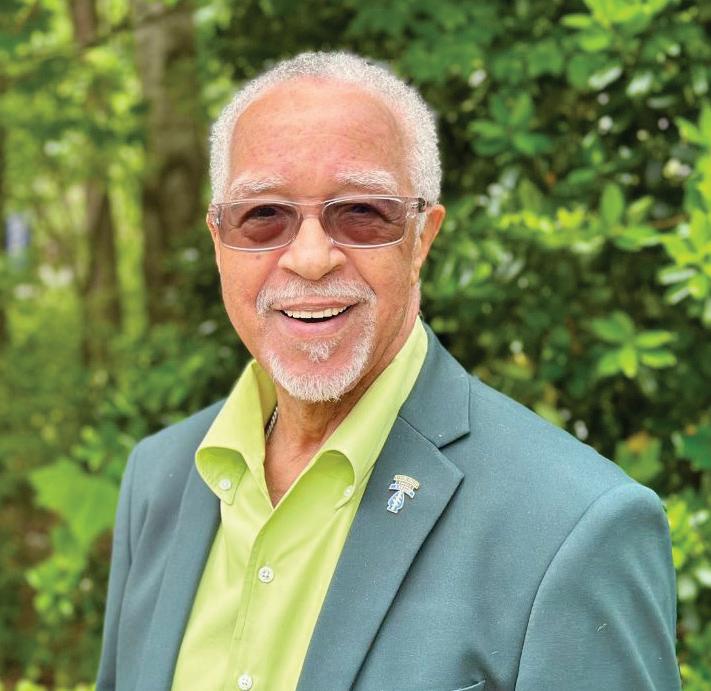
MAP TIME, NOT NAP TIME
Many behavioral studies suggest that using landmarks to navigate through large-scale spaces — known as map-based navigation — is not established until around age 12. A neuroscience study at Emory counters that assumption. Through experiments combining brain scans and a virtual environment the researchers dubbed Tiny Town, they showed that five-year-olds have the brain system that supports map-based navigation. The journal Proceedings of the National Academy of Sciences published the finding, the first neural evidence that this cognitive ability is in place in such young children. “While large-scale navigation abilities certainly continue to develop throughout childhood, our findings show that the underlying neural system is established remarkably early,” says Yaelan Jung, first author of the study and a postdoctoral psychology fellow. “[Five-year-olds] not only know that the ice cream store in the mountain region is different than the ice cream store in the lake region, they know how to navigate the streets to get to each of them,” says Daniel Dilks, associate professor of psychology and senior author of the study.
LITERARY ‘VENGEANCE’
This spring, PEN America selected “Vengeance Feminism” by Emory College’s Kali Gross as one of the 13 winners of its 2025 literary awards. The National Endowment for the Humanities Professor of African American Studies, Gross took home the PEN Open Book Award, granted for an “exceptional book-length work of any literary genre by an author of color.” Subtitled “The Power of Black Women’s Fury in Lawless Times,” Gross’ book features overlooked narratives of Black women who had to fight against discrimination, abuse and racial injustice. Gross has taught several courses at Emory that deal with themes discussed in the book. This fall, she is teaching the undergraduate course “The Other Salem,” which focuses on the historical experiences of Black women and capital punishment in the U.S., beginning with untold stories of Black women burned at the stake.

THE CARTER LEGACY
WHAT JIMMY CARTER BROUGHT TO EMORY WENT FAR BEYOND PRESTIGE AND PRESENCE — HE BROUGHT HIS STEADY, INDEFATIGABLE BELIEF IN THE POWER OF HOPE AND HUMAN DIGNITY.
IN THE QUIET SHADE OF EMORY’S Quadrangle, where old oaks stretch toward Georgia’s sun, where paved paths wind past lecture halls and libraries, the presence of Jimmy Carter is still deeply felt. Not in sorrow or silence, but in the daily rhythm of purpose, inquiry and compassion that pulses through the university he helped to shape.
Despite his death this past December, Carter’s legacy at Emory is not a closed chapter. It lives — steady and luminous — in the work, the questions and the unwavering optimism that he inspired in generations of students, faculty and staff.
For over four decades, Jimmy Carter was much more than a former U.S. president to the university. He was a professor, a mentor, a friend and a lodestar.
He came to Emory without fuss or fanfare, arriving instead with a challenge: to think boldly and act humanely. When he joined the faculty as University Distinguished Professor in 1982, just a year after leaving the White House, he did not seek a platform to reflect on past accomplishments. He sought a place to build. To listen. To teach.
Carter taught by example, of course, but also through wide-ranging conversations with students across disciplines, across generations, across every corner of campus. His open approach found its fullest expression in the annual Carter Town Hall, where students were invited to ask him anything — from politics to peanut farming — and received answers delivered with consideration and candor.
His long partnership with Emory was never transactional; it was transformational. Carter viewed the university less as a resting perch and more as a living laboratory for moral leadership, a place where ideas and ideals could intersect and be tested.
It’s where he founded The Carter Center, born from his vision but rooted in Emory’s mission to serve humanity. In collaboration with teachers, researchers and young scholars, the center would tackle some of the world’s most intractable challenges: disease eradication, election monitoring, human rights advocacy. Through that work, Carter offered a blueprint for how academia could serve as an engine for peace and compassion, a reminder that scholarship must never stand apart from the people it is meant to serve.
In total, Carter gave Emory far more than just his name and his presence. He shared with us his unshakable ethos: a resolute hope, even in the face of complex times. That hope — stubborn, resilient, luminous — still courses through the university’s veins. It is not past tense. It is present and alive.
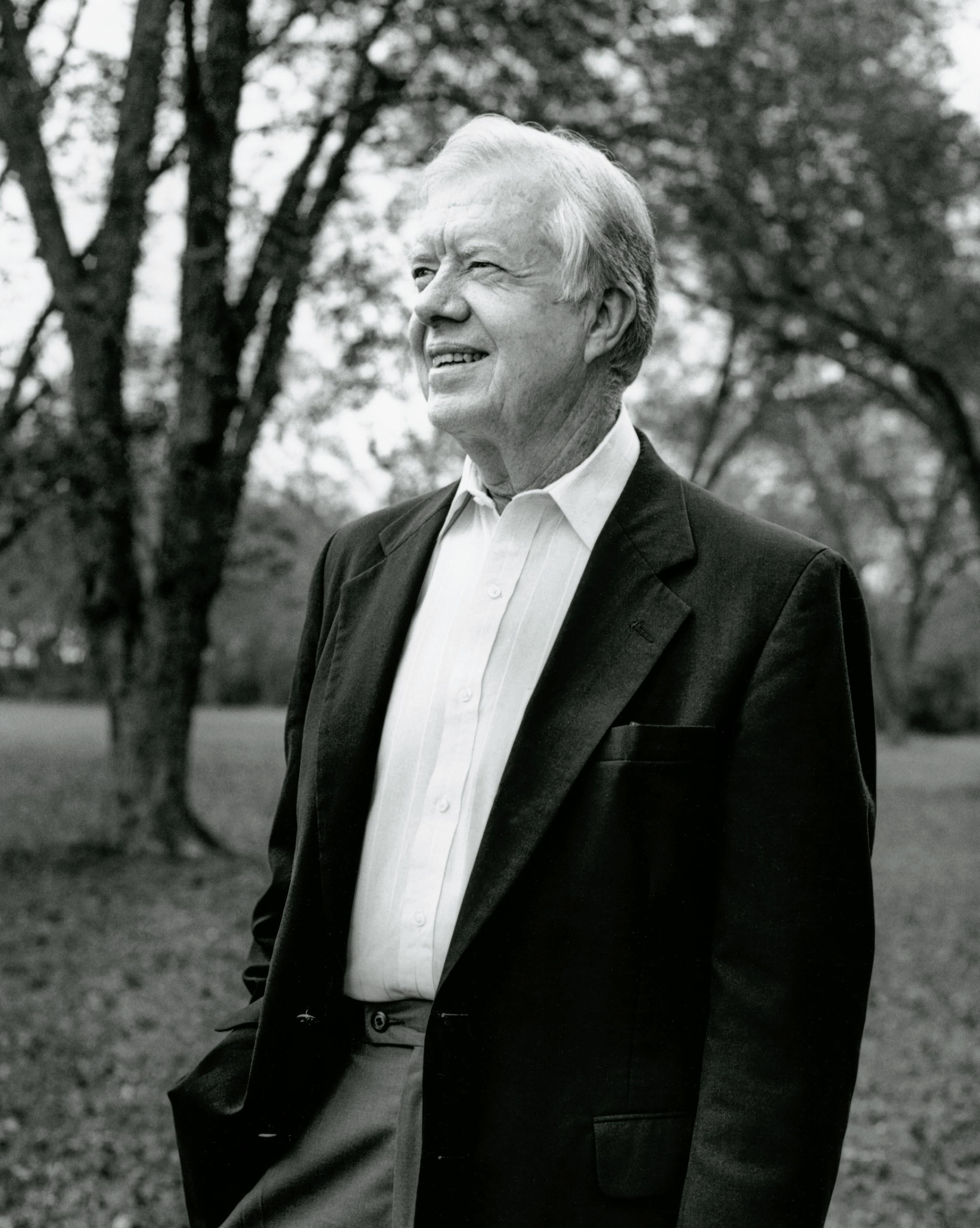
JIMMY CARTER & EMORY
President Jimmy Carter, born just five years after Emory University moved from its original location in Oxford, Georgia, to Atlanta, spent more than 40 years as an integral part of Emory. From becoming a University Distinguished Professor after the conclusion of his presidential service to establishing The Carter Center from the tenth floor of Emory’s Robert W. Woodruff Library while its permanent home was constructed, President Carter had an outsized impact on the university and, ultimately, the world.
1924
Jimmy Carter is born in Plains, Georgia — the first U.S. president born in a hospital — to farmer James and nurse Lillian Carter.
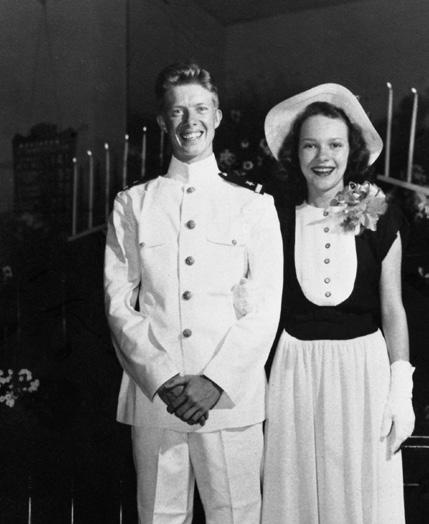
1971-75
1946
Carter graduates from the U.S. Naval Academy and shortly thereafter weds Rosalynn Smith at Plains Methodist Church.
As Georgia’s 76th governor, Carter prioritizes strengthening education and expanding mental health programs.
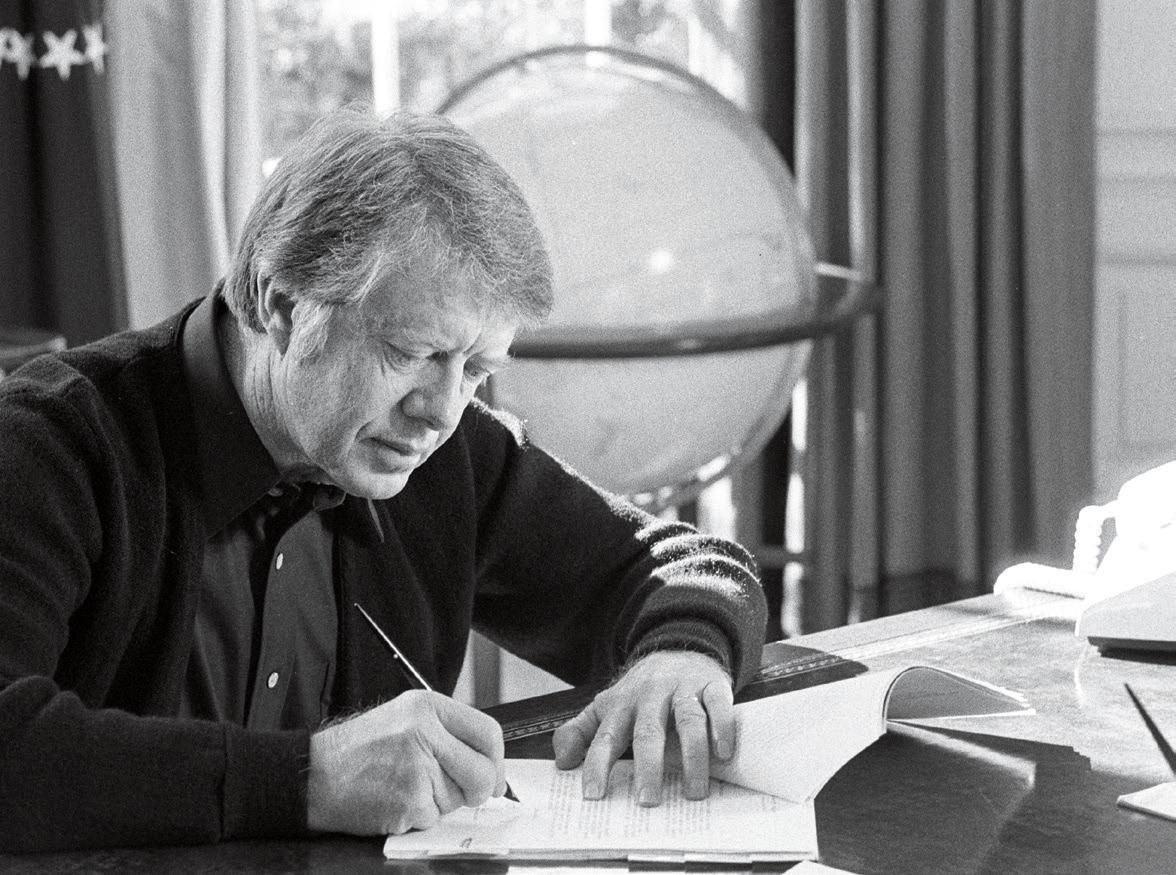
WHEN FORMER U.S. PRESIDENT JIMMY CARTER
joined the Emory faculty as University Distinguished Professor in 1982, he became a steady presence on campus. In addition to creating the robust partnership between the university and The Carter Center, he visited classes nearly every semester, fielded questions from first-year students at his annual Town Hall and held regular luncheons with small groups of faculty and staff.
Carter, who served as the 39th president of the United States from 1977 to 1981 and governor of Georgia from 1971 to 1975, passed away on Dec. 29, 2024, just months after celebrating his 100th birthday.
He was preceded in death by former first lady Rosalynn Carter, his beloved wife of 77 years, who passed away Nov. 19, 2023, and was memorialized in a national tribute service hosted by Emory.
The Carters worked closely with the university for more than four decades and their impact at Emory will continue for years to come.

PRESIDENTIAL PARTNER
A CONVERSATION WITH THEN-EMORY PRESIDENT
JAMES T. LANEY IN 1982 CONVINCED THE CARTERS THAT THE WORK THEY HOPED TO DO TO ADVANCE HUMAN RIGHTS COULD BEST BE DONE IN PARTNERSHIP WITH EMORY, DRAWING ON ITS UNIQUE RESOURCES.
In 1981, when Carter returned to his home state of Georgia, he had a range of options for how to shape his post-presidency career. With offers from a number of institutions, he chose to partner with Emory.
“I wanted the unrestricted ability to speak to the students in a very frank and unrestrained way,” Carter said, “and I felt Emory would give me
that opportunity. Since I have been a professor here, I have always been able, in lecture halls and town meetings, to speak without restraint.”
From the beginning, Carter was able to build strong ties with university leadership, including then-President Laney and faculty members who shared his vision for global humanitarian work.
From an office on the 10th floor of the Robert W. Woodruff Library, he launched The Carter Center, the organization whose work energized him and Rosalynn Carter for more than 40 years. Created in partnership with Emory to promote peace, democracy and the resolution of conflict around the world, the center’s mission quickly evolved to address critical shortfalls in global health as well.
“I knew that the center would be unique,
MEET AND GREET
Jimmy Carter, accompanied by then-Emory President James T. Laney, talks to a student on the university Quad.
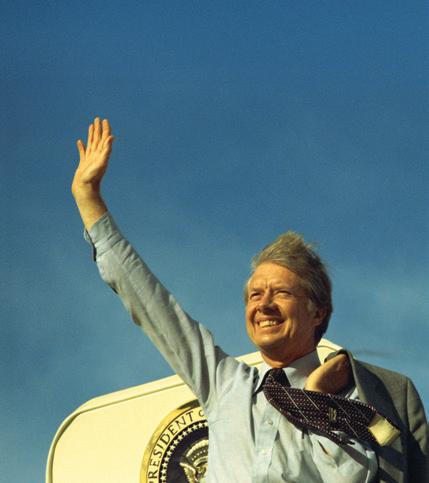
1977
1976
Carter defeats Gerald Ford to become president of the United States, campaigning on peace, human rights, and international cooperation.
James T. Laney becomes Emory president, helping forge the university’s close, lasting partnership with Jimmy Carter.
1979
Invited by Laney, Carter visits Emory to break ground for Cannon Chapel and receives an honorary law degree from the university.
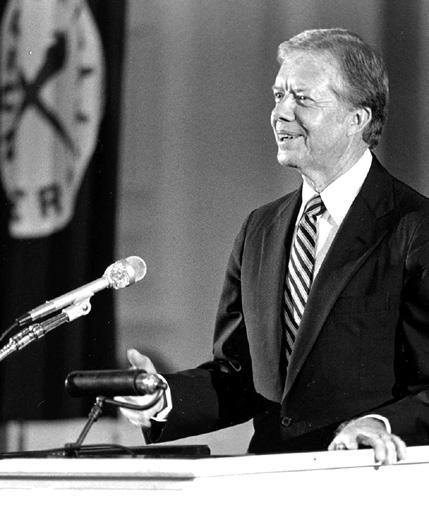
1982
1982
Following his presidency, Carter is named University Distinguished Professor, frequently visiting to teach, lecture and interact with students.
Carter creates an annual Town Hall, where for 38 years he engages Emory students with candid answers to their political and personal questions.
because it was to be a partnership between a former U.S. president with enormous energy and a university on the rise, and nothing like that had ever been tried before,” says Steven H. Hochman, the center’s director of research and faculty assistant to Carter, who was one of the first three staff members assisting the president in the library office. “However, no one imagined exactly how The Carter Center would develop.”
THE CARTER CENTER + EMORY
THE CARTER CENTER OCCUPIES FOUR INTERCONNECTED PAVILIONS LINKED TO THE JIMMY CARTER PRESIDENTIAL LIBRARY AND MUSEUM, JUST THREE MILES FROM EMORY’S ATLANTA CAMPUS.
Nestled in 37 acres of parkland, The Carter Center blossomed into a thriving organization that reaches around the world. To help support democratic governments in countries where they are nascent or threatened, the center’s peace programs have made it a pioneer in the field of election observation.
The center’s health programs are deliberately focused on preventable diseases that have been neglected or overlooked by other major health organizations. Now a recognized world leader in the practices that can achieve eradication or elimination, The Carter Center is nearly at the end of a long, wellfought battle to eradicate Guinea worm disease — just 15 cases of it were reported in 2024. It also has reduced suffering from river blindness, trachoma, schistosomiasis, lymphatic filariasis and malaria. Enormous progress has come from smartly using health education and simple, low-cost methods. Through efforts led by Mrs. Carter, the center also works to improve access to mental health care in the U.S. and around the world.
The partnership between Emory and The Carter Center resulted in a robust network of connections between the two organizations. Many of the center’s experts hold faculty appointments at Emory, and alumni, faculty and students regularly find pathways to participate in the center’s work. The center offers an internship program that has given more than 2,000 Emory students the enviable opportunity to experience its humanitarian efforts directly.
Harold J. Berman, one of the world’s foremost scholars of Soviet and post-Soviet law, was one example among many of the productive ties between the two institutions. Berman, Emory’s first Robert W. Woodruff Professor of Law, became a Carter Center Fellow in 1985 and developed a deep relationship with the Carters.
“We had fellows’ meetings where we discussed not only the future of The Carter Center, but the future of mankind,”
JIMMY CARTER & EMORY

SHAPING THE FUTURE Students were at the heart of Emory's bond with President Carter. Their questions, curiosity and ideals helped create a dialogue that lasted generations.
Berman said. “Jimmy Carter was terrific in those sessions. He ran those meetings with great dignity, imagination and intelligence.”
At Berman’s passing in 2007, Carter issued a statement calling him a “trusted advisor and friend.”
When Carter received the Nobel Prize for Peace in 2002, leaders across the university greeted the news with pride.
Laney, who had gone on to serve as U.S. ambassador to South Korea, had written a recommendation to the Nobel committee for Carter in 1994.
“It could have come earlier, and it would have been eminently justified,” Laney said. “But now it is a grand capstone of his life and career for which we all rejoice.”
CARTER ON CAMPUS
HIS PLEASURE IN THE EXCHANGE OF IDEAS ALWAYS EVIDENT, PRESIDENT CARTER GAVE GENEROUSLY OF HIS TIME TO VISIT EMORY CLASSES AND OFFER PERSPECTIVE ON STUDENTS’ VIEWPOINTS.
His larger-than-life status notwithstanding, Carter was in every sense a full-fledged faculty member at Emory: meeting often with students, advising them about their projects and engaging with other faculty to create the sort of initiatives that can arise only between a nongovernmental organization
“THE RELATIONSHIP BETWEEN EMORY AND THE CARTER CENTER IS PERMANENT AND IT’S VIRTUALLY INDESTRUCTIBLE. I HAVE PERSONALLY GOTTEN MORE OUT OF THIS PARTNERSHIP THAN EMORY HAS. IT HAS MADE THE TIME SINCE MY PRESIDENCY THE BEST TIME OF MY LIFE.”
— President Jimmy Carter
JIMMY CARTER & EMORY
1986
The Jimmy Carter Presidential Library and Museum and The Carter Center open permanently on a 35-acre wooded park in Atlanta.

1999
Jimmy and Rosalynn Carter receive the Presidential Medal of Freedom for their humanitarian efforts from President Bill Clinton.
1999
Carter joins Archbishop Desmond Tutu in a peace discussion at Emory’s Cannon Chapel, facilitated by Candler Dean Kevin LaGree.
2001
Carter dedicates Emory’s Lillian Carter Center for Global Health and Social Responsibility, named for his mother, a nurse and social advocate.
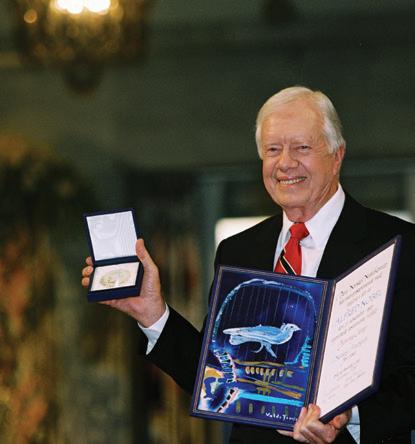
2002
For his decades of work in promoting peace and advancing human rights, Carter is awarded the Nobel Peace Prize.
“I’VE TAUGHT IN ALL THE SCHOOLS AT EMORY. IT HAS KEPT ME AWARE OF THE YOUNGER GENERATION, THEIR THOUGHTS AND IDEALS.”
— President Jimmy Carter
like The Carter Center and a research university like Emory.
In 2001, Carter and Emory’s Nell Hodgson Woodruff School of Nursing dedicated the Lillian Carter Center for Global Health and Social Responsibility in honor of Carter’s mother, who was a nurse. The center serves as the school’s hub of global education, research, practice and engagement. On the center’s 20th anniversary, Linda McCauley, dean of the nursing school, received a letter from Carter commending the center for honoring the “mission of improving the health of vulnerable people worldwide.”
For Emory’s first-year students, he conducted — despite his busy schedule — an unbroken string of Town Halls from 1982 to 2019, where they had the chance to hear from him and ask questions. Through the years, the president’s candor, warmth and sense of humor created an unforgettable memory that binds generations of students.
When, in lectures over the years, Carter reflected on his Emory career, he liked to playfully point out that he had taught students in every school of the university and published multiple books and articles but had yet to be awarded tenure.
Emory remedied that in June 2019, granting Carter tenured faculty appointments in four schools — Emory College of Arts and Sciences, Oxford College, Candler School of Theology and Rollins School of Public Health — to reflect the breadth of the president’s work and his impact on numerous fields.
RAISING
AWARENESS
KNOWN FOR HIS BOUNDLESS ENERGY, PRESIDENT CARTER WROTE 32 BOOKS, TAUGHT SUNDAY SCHOOL IN PLAINS, GEORGIA, BUILT HOUSES FOR THOSE IN NEED THROUGH HABITAT FOR HUMANITY AND TRAVELED THE WORLD WITH HIS WIFE, ROSALYNN, FOR THE CARTER CENTER.
When awarding the pair the Presidential Medal of Freedom in 1999, President Bill Clinton said, “Jimmy and Rosalynn Carter have done more good things for more people in more places than any other couple on the face of the Earth.”
In summer 2015, Carter revealed that he was being treated at Emory’s Winship Cancer Institute for metastatic melanoma. At the time, Carter thought he might have only weeks to live, but Winship doctors quickly developed a treatment plan for him, beginning with stereotactic radiation to control metastatic tumors in his brain and a new immunotherapy drug that worked systemically.

HUMANITARIAN
EFFORTS Jimmy and Rosalynn Carter were tireless champions of peace, public health and human dignity — living their values in service to others around the world.
The open way in which Carter shared his experiences brought public attention to the progress being made in cancer treatment. Carter continued to raise awareness for supporting scientific research. In 2016, he supported Winship’s successful efforts to gain comprehensive status from the National Cancer Institute.
For more than four decades after his presidency, Carter’s leadership of The Carter Center, his association with Emory and his commitment to his life’s work remained resolute.
“President Carter demonstrated to the world, and the Emory community, the basis of all true power — moral authority,” says Laney. “His steadfastness of purpose in making a better world won him global admiration, capped by the Nobel Peace Prize. Emory has been truly blessed in its association with President Carter, who has left us a model of a life of international renown devoted to service, the ideal Emory was founded upon.”
“I
WOULD LIKE TO BE REMEMBERED AS A CHAMPION OF HUMAN RIGHTS, AS A PRESIDENT WHO KEPT OUR COUNTRY AT PEACE AND AS HAVING BEEN A DISTINGUISHED PROFESSOR AT EMORY UNIVERSITY.”
— President Jimmy Carter
JIMMY CARTER & EMORY
2014
For his 90th birthday, Carter tours the Jimmy and Rosalynn Carter Pollinator Garden, created by Emory ecologist Jaap de Roode and undergraduate students.
2015
Winship Cancer Institute specialists begin treating Carter’s metastatic melanoma with surgery, radiation and immunotherapy.
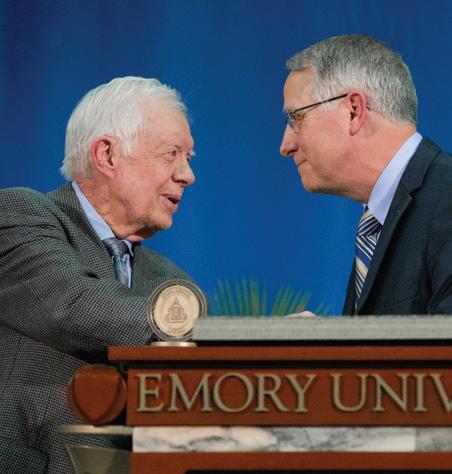
2017
2015 Carter receives the Emory University President’s Medal, one of the university’s highest honors, during the annual Carter Town Hall.
At Emory Law’s 100th anniversary, President Carter delivers the Bederman Lecture on “Human Rights in Today’s World.”
2019
Emory grants Carter tenure at Emory College of Arts and Sciences, Oxford College, Candler School of Theology and Rollins School of Public Health.

WHAT PRESIDENT CARTER TAUGHT US
IN EMORY CLASSROOMS, JIMMY CARTER TAUGHT WITH HONESTY, HUMILITY AND CURIOSITY.
HISTORIAN JOE CRESPINO SHARES HOW THE UNIVERSITY CAN CARRY FORWARD CARTER’S LEGACY BY FOLLOWING HIS EXAMPLE.
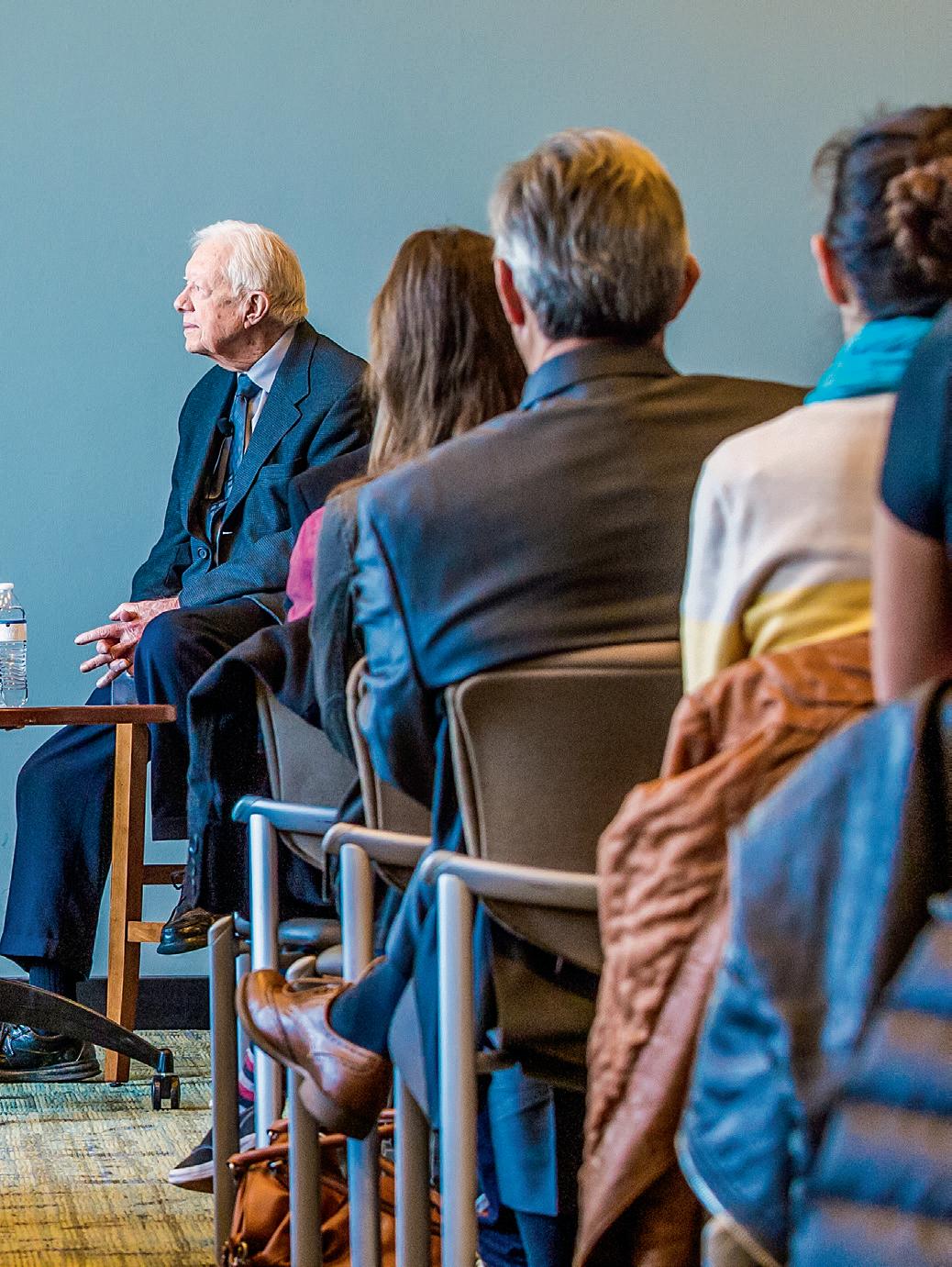
When Joe Crespino first began teaching at Emory, he never imagined that one day he'd be introducing students not only to the study of modern American history, but also to history itself, sitting just a few feet away.
As the inaugural Jimmy Carter Professor of History, Crespino had the rare privilege of working closely with Carter for more than a decade. In his classes, students researched Carter’s life and presidency, then met with the former president at the end of the semester to discuss their findings.
“Students would go into the archives, do this original research and then President Carter would come at the end of the semester. They could ask him about their research, have these brief oral history interviews,” Crespino recalls. “Those were some of my favorite moments in my teaching career.”
President Carter’s legacy at Emory, as Crespino sees it, is not bound to spaces where
he taught and listened or even to programs that bear the Carter name — though his influence is deeply felt in both. Instead, it lives in the spirit of inquiry, humility and public service Carter embodied in his more than 40 years as an Emory Distinguished Professor. “He was consistently on campus,” says Crespino. “He brought incredibly prominent global figures from around the world to Emory, and he interacted with students humbly. He allowed himself to be questioned — even interrogated — on controversial things, and he spoke freely and honestly.”
That authenticity made a deep impression on Crespino. “He didn’t have to keep showing up,” he says. “He didn’t have to be working in his 80s and 90s, traveling the globe, building houses for Habitat for Humanity or continuing to teach and engage students at Emory. But he did — all the way up until he physically couldn’t do it anymore.”
Crespino acknowledges that Carter’s death left a void. “It’s a huge loss,” he says. “To the university, to the world.”
As Emory looks ahead, Crespino believes that the best way to support Carter’s legacy is not by trying to replicate it, but by living the values Carter stood for. “He was a plainspoken person,” Crespino says. “He got in trouble sometimes — both as president and afterward — for saying what he really thought. He didn’t always follow the unwritten rules of the fraternity of former presidents. But his commitment to honest inquiry and open debate — that was unwavering.”
This, Crespino insists, is where Emory can lead. “We honor President Carter by staying true to our values of open inquiry, serious scholarship and great teaching,” he says. “That’s what we do as a great research university. And that’s the core of who he was.”
In many ways, Carter’s spirit remains woven into the fabric of Emory’s intellectual life: tireless, hopeful and devoted to the belief that truth, humility and dialogue can bridge even the oldest divides. “It’s that indefatigable commitment to peacemaking, to being a good citizen of every community he belonged to — from Plains, Georgia, to the world at large,” Crespino says. “That’s the spirit of President Carter. And that’s what we must carry forward.”
“AS A HISTORIAN, I BELIEVE THAT THE VALUES THAT I SAW PRESIDENT CARTER PRACTICE IN AN EMORY CLASSROOM — VALUES OF HUMILITY, OF OPTIMISM, OF FAITH IN THE POTENTIAL OF HIS FELLOW HUMAN BEINGS TO ACT WITH REASON AND GOODWILL — ARE THE SAME VALUES FOR WHICH JIMMY CARTER WILL BE REMEMBERED AS A PRESIDENT AND AS A STATESMAN.”
— Joe Crespino, Jimmy Carter Professor of History
JIMMY CARTER & EMORY

2019
Carter delivers his final in-person Town Hall for first-year Emory students, concluding an unbroken 38 years of the campus tradition.
2020
Due to COVID-19, Carter’s last Town Hall is a recorded interview with grandson Jason Carter; President Carter later retires from public life.
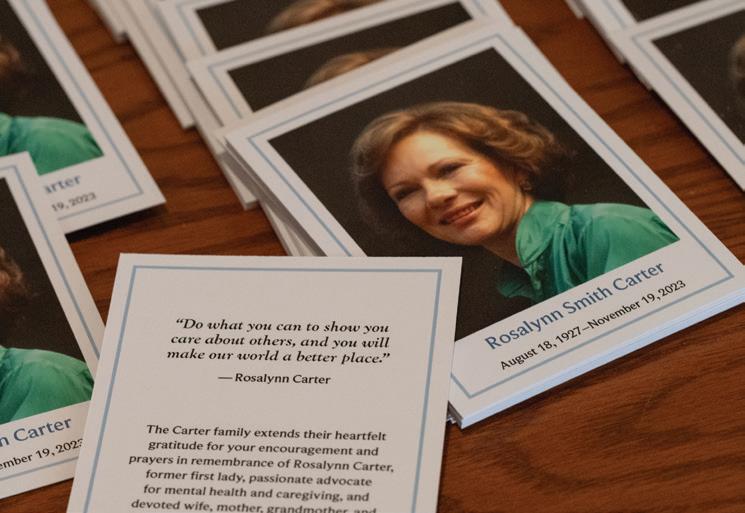
2023
Emory’s Glenn Memorial United Methodist Church hosts Rosalynn Carter’s national tribute service.
President Carter, age 99 and in hospice, attends in person.
2024
The longest-living U.S. president in history, Carter celebrates his 100th birthday on Oct. 1. He passes away Dec. 29 at his home in Plains, surrounded by family.

Ask Me Anything
PRESIDENT CARTER SERVES UP ANSWERS ON POLITICS, PEACE AND PEANUT BUTTER
Nowhere at Emory was Jimmy Carter’s commitment to teaching and listening more vividly on display than at the university’s annual Carter Town Hall — a cherished tradition that brought students face-to-face with a former U.S. president. For 38 years consecutively, students got the chance to gather and ask him anything — from the playfulness of peanut farming to the gravity of global conflict. No topic was off-limits. No answer was rehearsed. In those exchanges, Carter modeled what it meant to lead with intellect and integrity, grace and grit. He reminded students that even the highest office in the land could — and should — remain accessible, empathetic and accountable.
Here’s a sampling of the questions students asked him over the years, and the thoughtful, often surprising answers President Carter gave in return.
WHAT WAS YOUR MOST MEMORABLE ACCOMPLISHMENT
WHILE YOU WERE IN OFFICE?
My most memorable, I think, was keeping our country at peace throughout my four years, and also trying to generate peace among other peoples, including between Egypt and Israel.
HOW WOULD YOU DESCRIBE THE SPIRIT THAT EMORY HAS BEEN DEVELOPING ALL THESE YEARS SINCE ITS FOUNDING?
I found a great deal of political freedom here, and that was one of the things I wanted because I wanted to adopt controversial issues if I chose. I didn't want to be censored, and I was promised that I would not be censored. So I have really come to understand and to love the essence of what Emory is. And as [former Emory President James T. Laney] said, I was the first person on Earth to use the White House as a stepping stone to greater things. And I'm just very proud, deeply, to be a part of Emory.
DO YOU PREFER ELEPHANTS OR DONKEYS?
I prefer elephants in the wild and donkeys in the voting booth.
WHAT IS THE FIRST THING YOU SAY TO YOUR WIFE IN THE MORNING?
(recounting how after leaving the White House, he forgot Rosalynn’s birthday and quickly wrote a card promising to grant her fondest wish) So she thought it over for a few days, and she said, ‘I think I would like, when I get up in the morning, to have a cup of coffee and a glass of orange juice — delivered by you.’ Now for about 30 years, usually the first time I see my wife in the morning, I take her a cup of coffee and a glass of orange juice, and she repays me with a kiss and we tell each other we love each other, and that is how we start our day.
BEING THE PEANUT FARMING PRESIDENT: CRUNCHY OR SMOOTH?
I prefer crunchy more than I do smooth.
WHAT ARE YOUR THOUGHTS ON ALMOND BUTTER?
I never have tasted it, and I don’t intend to.
WHAT IS YOUR BEST ADVICE FOR A FIRST-YEAR COLLEGE STUDENT?
When I was elected president and was inaugurated, I made a fairly brief inauguration speech and I was the first president who ever quoted a high school teacher. And later when I got the Nobel Peace Prize, I quoted the same high school teacher, and what she taught us then has been good advice for me. It is: “We must accommodate changing times, but cling to principles that never change.” There are principles that never change: to tell the truth, be compassionate to others, promote justice, promote peace, share whatever talent or ability you have with other people.
WHAT BOOK DID YOU READ THAT CHANGED YOUR LIFE?
The Bible has had the most profound impact on my life.
WHAT ACTOR WOULD YOU WANT TO PLAY YOU IN A MOVIE?
I think Jon Stewart.
WHAT DO YOU WANT TO BE REMEMBERED FOR?
I would like to remembered as a champion of human rights. I would like to be remembered as a president who kept our country at peace and promoted peace for everybody else in the world with whom we had contact. And I would like to be remembered as having been a distinguished professor at Emory University.
Stories by Susan Carini 04G, Michelle Ricker and Roger Slavens

FROM BENCH TO BREAKTHROUGH
How Emory health innovations — therapeutics, tools and technologies — from trailblazing researchers are saving lives around the globe.
BY OFFICE OF TECHNOLOGY TRANSFER STAFF AND ROGER SLAVENS
HIV antiretroviral drugs taken by tens of millions of people. Virtual reality simulations that help people confront their phobias and addictions. AI-driven imaging solutions that pinpoint cancer cells.
These transformative innovations may seem worlds apart, but they share a common thread: Each began as a bold idea in an Emory lab and was nurtured through years of research, testing and collaboration. From the earliest phases of bench work to clinical trials and commercialization, the path to impact is complex and often high stakes.
Behind the scenes — and for 40 years now — Emory’s Office of Technology Transfer (OTT) has played a crucial role in bringing these big ideas to the marketplace by helping researchers secure patents, navigate licensing and launch partnerships. Since its founding in 1985, the office has supported the development of 26 FDAapproved drugs, 24 medical devices and more than 130 startup companies.
“When it comes to measuring success in tech transfer, nothing matters more than getting new products to market,” says Todd Sherer, Emory associate vice president for research and OTT’s executive director. “That’s the ultimate validation of our work — it proves the impact of university research in real-world terms. While we certainly track metrics like invention disclosures, patents and licenses, those are means to

an end. The true measure is whether a discovery becomes something that helps people.”
The following stories celebrate some of the university’s most groundbreaking medical and health care innovations — and the researchers whose work from the lab bench is creating real-world impact.
HOW EMORY HELPED CHANGE THE COURSE OF HIV TREATMENT
It’s estimated that more than 90% of people in the U.S. living with HIV — and millions more around the world — have taken at least one of the life-saving drugs developed by Emory researchers Dennis Liotta, Raymond Schinazi and Woo-Baeg Choi. These medications helped transform HIV from a fatal diagnosis into a manageable chronic condition and in doing so reshaped public health on a global scale.
The journey began in the early 1990s, when Liotta, a chemistry professor, resolved to tackle the HIV/AIDS epidemic head-on.
“I made it my personal goal to create a safe and effective AIDS drug,” says Liotta, Samuel Candler Dobbs Professor of Chemistry. “It is so gratifying that it became part of a series of combination therapies that transformed AIDS from a death sentence to a manageable chronic disease.”
Liotta partnered with virologist Schinazi and postdoctoral researcher Choi to develop two groundbreaking compounds: 3TC (lamivudine, sold as Epivir) and FTC (emtricitabine, sold as Emtriva). Both are nucleoside reverse transcriptase inhibitors — a class of drugs that stops HIV from replicating.
“In addition to being quite effective, Emtriva is one of the safest antiretroviral agents available,” says Liotta. “This is quite important because AIDS patients have to take their drug regimens every day of their lives.”
Emory’s patent for one of the drugs was filed just seven days ahead of a competing group, but it would take nearly a decade of laboratory refinement, testing and commercial groundwork before either compound reached the market.
That persistence paid off. In 2001, Epivir became the first Emory-developed drug to win FDA approval, followed by

THE LITTLE PILL THAT COULD Molnupiravir halts the viral spread of COVID-19 and is being studied as a way to fight enchephalitis and influenza.
Emtriva in 2003. These medications became central components of Truvada, a once-daily HIV treatment approved in 2004 — and later the first drug approved to prevent HIV infection in high-risk populations.
By 2006, Atripla —a single-tablet regimen combining Emtriva with two other agents — simplified HIV treatment further, reducing the number of pills patients have to take and improving patient compliance around the world. In addition to its use in HIV, Epivir is widely used to treat hepatitis B (HBV), which affects more than 400 million people globally and is a leading cause of liver cancer. Schinazi also discovered telbivudine, another highly effective treatment for HBV.
“Everyone was intrigued but skeptical about our work — no one realized the importance of what we had found,” recalls Schinazi, professor of pediatrics, director of the Laboratory of Biochemical Pharmacology and co-director of the HIV Cure Scientific Working Group at Emory.
“It’s very gratifying to see that our work has helped so many people all over the world,” Schinazi says. “HIV is no longer a death sentence.”
The collaborative spirit among Liotta, Schinazi and Choi became a model for how Emory approaches research innovation.
“When the overriding goal is the health of patients, every source of insight and expertise is welcome,” says Liotta. “That culture is part of what made our discovery possible.”
Their success also catalyzed the future of drug development at Emory. In 2005, the university sold rights to future Emtriva royalties in what was then one of the largest intellectual property deals in higher education. The proceeds were reinvested into research, including the creation of two Emory-linked entities: the Emory Institute for Drug Development (EIDD) and DRIVE (Drug Innovation Ventures at Emory). Funded in part by Liotta’s own share of earnings, the two groups work together to move scientific discoveries into therapeutic realities — and were instrumental in the
discovery of molnupiravir, an antiviral used during the COVID-19 pandemic.
Now, Emory’s HIV legacy continues through a new generation of researchers. Christina Gavegnano, once a graduate student in Schinazi’s lab, recently led the discovery of a first-in-class therapy that could address HIV persistence — the virus’s ability to hide in the body despite treatment. Her small-molecule compound, VIP943, targets and eliminates the HIV reservoir using the cell’s own degradation machinery.
“This could be a turning point in the fight against HIV,” says Gavegnano, now an assistant professor at Emory. “We’re attacking the root of viral persistence, not just suppressing symptoms.”
FIGHTING COVID-19 WITH ORAL THERAPUETICS
Years before the pandemic emerged, Emory scientists were developing what would become one of the world’s first oral treatments for the virus.
Beginning in the early 2010s, George Painter, along with fellow Emory researchers Gregory Bluemling, Michael Natchus, David Guthrie and David Perryman, worked on EIDD-2801 — a broad-spectrum antiviral first aimed at Venezuelan equine encephalitis, a Cold War-era bioterrorism threat. Their compound showed promise against multiple viruses, including influenza and coronaviruses. When COVID-19 struck, they quickly repurposed it.
Renamed molnupiravir — after Thor’s mythical hammer — the drug became one of the first oral medications approved to treat COVID-19. It was the 26th FDA-approved drug born at Emory, and DRIVE’s first to reach the market.
Molnupiravir works by targeting the virus’s replication machinery. It introduces errors into SARS-CoV-2’s genetic code, essentially jamming the “copy machine” the virus uses to reproduce. If taken early, the drug halts viral spread in the body and helps prevent severe illness.
In November 2021, the U.K. approved molnupiravir for high-risk patients, followed by U.S. FDA Emergency Use
Everyone was intrigued but skeptical about our work — no one realized the importance of what we had found.
— Raymond Schinazi Director of the Laboratory of Biochemical Pharmacology

BUILDING A CULTURE OF ENTREPRENEURSHIP
AT EMORY, ENTREPRENEURSHIP IS BECOMING EVERYONE’S BUSINESS. It’s gaining traction all across the university, showing up in classrooms, labs, studios and even dorm rooms. The goal: make entrepreneurial thinking more accessible, interdisciplinary and part of everyday academic life.
“There’s great work happening in all of our schools and across our campuses,” says Wilbur Lam, Emory’s inaugural vice provost for entrepreneurship. “By connecting these efforts, we’re starting to build a pipeline that supports faculty and students no matter their background or discipline.”
Lam brings extraordinary firsthand experience to the job. A pediatric hematologist, bioengineer and serial entrepreneur, he’s led major research labs, helped bring diagnostics to market, mentored student teams and served as a national advisor to the NIH and FDA during the COVID-19 pandemic.
“I’ve seen how challenging it can be to translate academic work into real-world impact,” he says. “And I’ve also seen what happens when the right support is in place.”
Since stepping into the role a year ago, Lam has worked to align Emory’s many
entrepreneurial efforts — encouraging collaboration, surfacing new ideas and guiding projects from concept to launch. One key initiative is Emory’s first university-wide innovation council, where leaders from across schools now meet regularly to share strategies and spark new working partnerships.
The Hatchery, Emory’s student startup hub launched in 2020, has already become a go-to space where graduate and undergraduate students across all disciplines learn how to bring their ideas to life. Now entering what Lam calls its “2.0” phase, The Hatchery is working closely with school leaders to expand entrepreneurial education and programming for student, faculty and staff innovators across the university. “We see The Hatchery as a place where all our learners can give birth to their ideas and find the community and mentorship to grow them,” he says.
While the university’s Office of Technology Transfer continues to be a bedrock of support for patents, licensing and commercialization, Lam is overseeing efforts to complement that work by focusing on what comes before: surfacing ideas, nurturing new skills and building the confidence to experiment.
Authorization the next month. Painter, hearing it could save lives, wept. “It was a little overwhelming, to tell the truth,” he says.
The pill’s portability — no injections, no cold storage — made it especially practical in global settings. Clinical trials showed it could eliminate infectious virus from nasal swabs within five days.
Even as molnupiravir, now sold by Merck as Lagevrio, continues to help COVID-19 patients, Emory scientists are
“Breakthroughs don’t always look like products or patents,” Lam says. “Sometimes it’s an unexpected synergy, a new model for delivery or a student reimagining a career path.”
One example of this mindset is the upcoming Stuart and Mimi Rose Program for Student Startups, a new for-credit innovation track that connects Goizueta Business School, Emory College of Arts and Sciences and The Hatchery. Open to students in any major, the Rose Program is designed to guide undergraduates through the process of developing a venture — from idea to launch — as part of formal coursework rather than solely extracurricular activity, Lam says.
He also sees incredible value in growing Emory’s ties to Atlanta’s broader entrepreneurial ecosystem. “We’re actively working with Georgia Tech, Children’s Healthcare of Atlanta and members of the city’s vibrant startup scene,” he says. “These partnerships give our students and faculty access to a powerful network of investors, incubators and business opportunities.”
To help bridge the gap between research and real-world impact, the university operates Emory Innovations Inc. (EII) to assist faculty in rigorously vetting discoveries and inventions that hold potential for commercialization. By de-risking early-stage concepts, EII helps increase their market readiness, Lam says.
“Innovation is a mindset,” Lam adds. “We’re working to build an ecosystem that empowers people across Emory to take chances, collaborate and lead. That culture is taking hold — and it’s getting stronger every day.”

studying its use against other RNA viruses, including encephalitis and influenza. “Our continuing mission is to search for other antiviral agents that are usable by the general public to address other tough diseases,” says Painter. “So, we are on it. That’s our job.”
Another Emory-driven breakthrough during the pandemic was baricitinib, an anti-inflammatory drug originally used for rheumatoid arthritis. In international clinical trials led by Emory physician-scientist Vincent Marconi,
it significantly reduced the risk of death in hospitalized COVID-19 patients requiring oxygen or ventilation. The FDA later authorized it as a standalone treatment.
The drug’s success was rooted in earlier Emory research on JAK inhibitors for HIV, led by Schinazi and Gavegnano. That groundwork provided the scientific basis for rapidly repurposing baricitinib to address COVID-19’s deadly immune overreaction.
“Our extensive work with JAK inhibitors in the HIV space became a roadmap for tackling COVID-19 in record time,” Gavegnano says.
Emory and the U.S. Department of Veterans Affairs hold patents on this approach, licensed to Eli Lilly in 2021. Like molnupiravir, baricitinib reflects Emory’s vital role in turning decades of research into timely, life-saving treatments.
THE TELL-TALE HEART: THE EMORY CARDIAC TOOLBOX
A 3D image of a beating heart rotates on screen. Nearby, color-coded scans reveal blood flow through the heart muscle — highlighting areas of concern in black voids. This technology, the Emory Cardiac Toolbox (ECTb), is one of the most widely used cardiac imaging systems in the world.
Developed by researcher Ernest Garcia, now a professor emeritus of radiology at Emory’s School of Medicine, the Toolbox helps answer a critical question: Does a patient have coronary artery disease? Over three decades, Garcia and his collaborators at Georgia Tech and Cedars-Sinai built a suite of software tools that allow physicians to analyze blood flow and heart function with greater precision.
The Toolbox’s latest advances help identify which patients are likely to benefit from cardiac resynchronization therapy, a method used to correct irregular heartbeats. “Just by analyzing how the heart beats, we can now predict whether resynchronization will help restore proper rhythm,” Garcia says.

Just by analyzing how the heart beats, we can now predict whether resynchronization will help restore proper rhythm.
— Ernest Garcia Emeritus Professor of Radiology
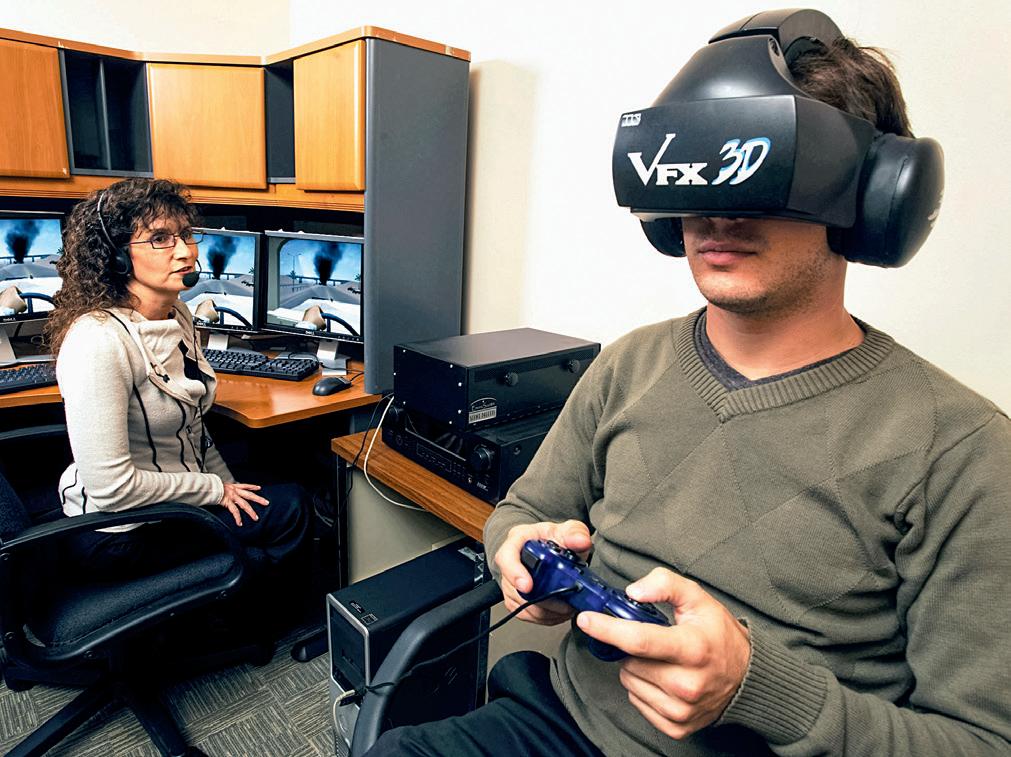
Emory began licensing the software in the 1990s and in 1999 helped launch Syntermed Inc., which distributes the technology worldwide. With more than 10,000 installations, ECTb has become a global tool in the fight against heart disease.
Garcia, who credits the software with saving his own life after a cardiac event, sees its reach as a model for academic medicine. “Once you feel the satisfaction of walking into a hospital in China or Italy and seeing your software helping a patient,” he says, “you realize this is exactly what research should do — translate into something that improves lives.”
AI AT WAR WITH CANCER: SMARTER IMAGING FOR SMARTER TREATMENT
Imagine cancer treatment as a war and the physician as the general who must pinpoint the enemy’s exact position. Thanks to AI-powered molecular imaging software, doctors now have sharper, faster, and more personalized tools to guide their strategy.
Developed at Emory by radiation oncologists Tim Fox and Ian Crocker, the technology — Velocity AI — helps physicians “see” cancer more clearly by integrating multiple scans into one dynamic, 3D-like image. The core technology, deformable image registration, aligns soft tissue across different image sets, warping and matching them to provide a high-resolution view of tumor boundaries.
“Essentially, we're trying to use imaging more as a predictive tool for cancer,” says Fox. “If you're able to assess the tumor response more quickly, then you can modify the treatment if the patient is not responding. It could have a huge impact on patient care.”
FACING FEARS HEAD ON
Virtually Better simulates realistic environments designed to help patients gradually become comfortable with fear-inducing situations.
Fox likens the system to Doppler radar — allowing physicians to track tumors and their response to therapy in real time. What once took hours can now happen in seconds, improving workflow and enabling faster clinical decisions.
In 2014, Varian Medical Systems acquired Velocity Medical Solutions, expanding the reach of the software. Today, Velocity is used in more than 200 cancer centers worldwide, helping physicians reduce uncertainty and better target their treatments.
“We needed to do a better job integrating imaging into the treatment planning,” says Fox. “From there, we just kept adding to it — creating a tool that solved a lot of our problems.”
As cancer remains the second-leading cause of death in the U.S., innovations like Velocity AI offer new hope by turning complex data into clearer decisions — and better outcomes.
VIRTUALLY BETTER: TREATING PHOBIAS, ADDICTIONS AND PTSD WITH VR
The weather outside the room’s picture window is calm — blue skies, birds chirping. Then the wind picks up, rain spatters the glass, thunder rumbles, and the lights flicker out. For someone with a phobia of storms, these are powerful triggers. But in this case, the storm is virtual — controlled by a therapist and delivered through a headset.
Virtual Reality Therapy (VRT) immerses patients in realistic, computer-generated environments that help them gradually become more comfortable with fear-inducing situations. Since its founding in 1996, Virtually Better Inc. has led the way in developing virtual tools to treat anxiety disorders such as fear of flying, heights, and public speaking, as well as post-traumatic stress disorder (PTSD).
“Virtually Better provides an alternative to traditional exposure therapy,” says Jill Uhl, the OTT’s director of license and patent strategy and chief intellectual property officer.. “It allows patients to be treated in-office with greater convenience, lower cost, and less disruption.”
Emory professor of psychiatry Barbara Rothbaum helped pioneer the approach with Georgia Tech’s Larry Hodges. Their first study used virtual heights — glass elevators, bridges — to treat acrophobia. “We had been taking patients up tall buildings and to the top of the parking garage for years,” Rothbaum says, “but we discovered that the virtual reality exposure translated into real life. Seven out of ten people at the end of treatment were able to go into a real-life height situation.”
Today, Virtually Better helps veterans of the Afghanistan and Iraq wars confront trauma through
simulated combat scenes. It’s also exploring addiction recovery using virtual bars and drug-use settings. A recent project, “CalmCraft: A Deep Sea Voyage,” helps children manage pain and anxiety through guided breathing in a virtual underwater world.
A SERENDIPITOUS SOLUTION: OBIZUR AND HEMOPHILIA A
When Emory hematologist Pete Lollar began researching blood coagulation in the 1990s, he didn’t intend to create a new treatment for hemophilia. But a surprising discovery in his lab would eventually lead to Obizur, a life-saving drug approved by the FDA in 2014 for acquired hemophilia A.
Hemophilia A is a bleeding disorder caused by a deficiency in clotting factor VIII (FVIII). While inherited cases are more common, acquired hemophilia arises when the immune system develops antibodies that inactivate FVIII — often with no prior warning. This can result in sudden, severe bleeding episodes that are difficult to treat.
Lollar and his research team, including Ernest Parker, John Healey and Rachel Barrow, developed a modified form of FVIII based on the pig version of the protein. Delivered intravenously, this recombinant porcine FVIII mimics the function of human FVIII but evades immune detection in patients with inhibitors.
“Porcine FVIII is similar enough to human FVIII to be effective in clotting, but less likely to be neutralized by antibodies,” the FDA explains.
Though the road to approval took 22 years, clinical trials confirmed Obizur’s safety and efficacy, particularly for patients with few other treatment options. The FDA also granted it orphan drug status, a designation that provides incentives like market exclusivity and tax credits to encourage development of treatments for rare diseases — defined in the U.S. as those affecting fewer than 200,000 people.
Now the Hemophilia of Georgia Professor of Pediatrics at Emory, Lollar reflects modestly on the achievement: “This is not really rocket science. We’re basically trying to replace a missing factor.” But for patients, the impact has been profound.
THE DISCOVERIES DON'T STOP HERE
These six innovations are just a small sample of Emory health innovation success stories.
Discover many more online at magazine.emory.edu.



From the Library Archives
SEEING IS BELIEVING
From some of the world’s oldest books to the personal photo collections of cultural and historical figures, Emory Libraries care for an array of unexpected treasures — and put it all to work in classrooms, exhibits and research.
BY KATE SWEENEY AND ANNA CHAPMAN
If every object tells a story, then thousands of tales are whispering their way through Emory Libraries’ archival collections.
At the Stuart A. Rose Manuscript, Archives and Rare Book Library, students, faculty and visitors can pore over the personal letters, photos and ephemera of literary legends, political and cultural icons and unsung heroes alike, with more than 200,000 volumes and 23,000 linear feet of original manuscripts and historical objects spanning more than 800 years of history.
Visitors to Pitts Theology Library can trace the history of the Protestant church to its very roots, including a vast collection related to the Reformation and the largest collection of hymnals outside the Library of Congress. Pitts also houses materials related to John Wesley, the founder of Methodism, and archives focused on African Christianity.
Meanwhile, artifacts at Woodruff Health Sciences Library showcase the evolution of modern medicine and Emory’s own notable medical science milestones.
And — in addition to serving as a traditional resource for academic study — the Robert W. Woodruff Library cares for some storied items of its own.
To Randy Gue, the arrival of these objects at Emory Libraries marks the start of a new chapter in their long lives.
“To me, that’s the fascinating part,” says Gue, the assistant director of collection development and curator of political, cultural and social movements at the Rose Library. “Scholars are using these items every day. And as time goes on, they’ll be studied for projects we’ve never conceived of. That’s really exciting.”
Here are some of the most important and fascinating collections housed at Emory’s Libraries, and their stories — as they’ve unfolded so far.
A rare German-language edition of the Nuremberg Chronicle at Pitts Theology Library
Rare Books and First Editions
A daguerreotype of author Walt Whitman, young and brown-bearded, stares up from the flyleaf of a first edition of “Leaves of Grass” from 1855 — written and printed by the author when he was still a relative unknown. Gold peacock feathers rain down the jacket and spine of an 1894 edition of “Pride and Prejudice” by Jane Austen, signed by the illustrator. You can also page through first editions by James Joyce, Emily Dickinson, Harper Lee and many others housed at the Rose Library. From Irish and African American literature to countercultural figures and modern poetry, the Rose is the place for true bibliophiles. The library holds approximately 133,976 print titles in all, many the very earliest printed copies of these works, preserved and available to scholars from the Emory community and beyond.

The “peacock edition” of “Pride and Prejudice,” signed by the illustrator.
A manuscript of Alice Walker’s “The Color Purple” also lives at the library, as does a book Flannery O’Connor wrote by hand as a teenager. The oldest printed book at the Rose (“Biblia Latina” from 1475) is not the oldest book the library cares for. That distinction goes to ancient cuneiform tablets on permanent loan from Emory’s Michael C. Carlos Museum and a Greek manuscript from the 4th century CE. These treasures make the Rose Library much more than a repository of rare books. It’s a vibrant crossroads of literary history and discovery.

The Moment Graffiti Made its Mark
They went by monikers like Taki 183, Blade and Friendly Freddie. They were teenagers, or younger. No one knew their art would change the world.
But their flamboyantly lettered “style writing” graffiti, sprayed on the sides of subway cars, came to influence hip-hop and art for decades to come.
The Rose Library houses about 1,500 photographed slides of many of the earliest instances of style writing, taken by Jack Stewart between 1970-1978. Stewart, a classically trained artist born and raised in Atlanta, was captivated by the early graffiti when it began appearing in New York. His estate also entrusted the Rose Library with his PhD dissertation, “Subway Graffiti: An Aesthetic Study of Graffiti on the Subway,” which street artists refer to as “the Bible.”
Julia Tulke, assistant teaching professor in the Institute for Liberal Arts, says students in her “Graffiti and Public Art” class are often floored when they compare the slides of early New York style writing with the brighter, cleaner lines that came later — in a Rose Library collection of Atlanta graffiti photographs from the 2010s.
“These early pieces are also stellar examples of raw and rebellious artistic responses to dire social circumstance,” says Tulke, in this case, mostly Black and Latino neighborhoods experiencing economic disinvestment in 1970s New York.
The collection has helped her students better understand cityscapes everywhere, she says, “because they know how to look at walls as a repository of information. That's what graffiti essentially is. It's kind of an archive in its own right.”
(clockwise from left)
An early example of style-writing graffiti, a photo of some of the first style writers and an outline of Jack Stewart's dissertation.

Through a Crystal Ball: Glimpses of Black Life During Jim Crow
What can later generations learn from our collected belongings after we’re gone? In the case of Mamie Wade Avant, those belongings include fortune-telling cards. The cards feature a brightly hued house, an all-seeing eye, a horse and rider, a ship. Each image portends prosperity, happiness in marriage, ill luck or true friendship.
Then there are the spells. Written on notebook paper whose blue lines are now faded, they trace out all manner of life’s enduring preoccupations, with spells to banish and spells to attract, spells for luck and spells for health.
Bibles, handwritten sermons and Christian pamphlets are also here. The crystal ball has surprising heft. The Rose Library houses Avant’s books, too: spellbooks, but also books on religion and race, peppered with opinionated notes in the margins.
Little is known about Avant, a Black resident of Savannah in the 1950s and ’60s. That’s part of what fascinates Emory student Angelica Johnson 28PhD, an English doctoral student who used census records to trace Avant’s early life to eastern South Carolina. Johnson’s dissertation considers possibilities for her beyond the religious stereotypes of Southern Black women. For example, portions of Avant’s spells were likely inspired by hoodoo, a collection of spiritual practices employed in some Southern Black communities. But they also contain elements of Christian prayer.
Working directly with these belongings helps Johnson imagine possibilities for Avant as a living, breathing Black woman living in the Jim Crow South.“Having access to a collection that includes the everyday, quotidian objects provides evidence of how people may have lived, especially people whose history has been marginalized,” she says. “It reminds student that archival materials are from real people from the past.”
Smiling, she adds, “It also gives you the opportunity to be nosy. I like to tell my students that: ‘We can be nosy! We can look at this archive and really get into it.’”
A crystal ball and playing cards belonging to Mamie Wade Avant
400 Years of Chinese History, Religion and Culture

A hanging print from 1843 features the Buddha guiding a ship of pilgrims across the waves — the water, a metaphor for the suffering of this life. Tiny circles populate the black and white image, lining the border, framing the sail and filling the ship’s hull. They serve a practical religious function: After chanting the name of the Amitabha Buddha a certain number of times, a Buddhist practitioner may color in a single dot.
“And you continue to do that until you fill all the dots in this image,” says Pinyan Zhu, assistant professor in art history. The colorful print at the end of this lengthy process is a step fulfilled on the journey to enlightenment.
The Buddha Amitabha print is one of 5,000 religious and cultural texts from the 17th-20th centuries that compose the Classical Chinese Literature collection at Pitts Theology Library.
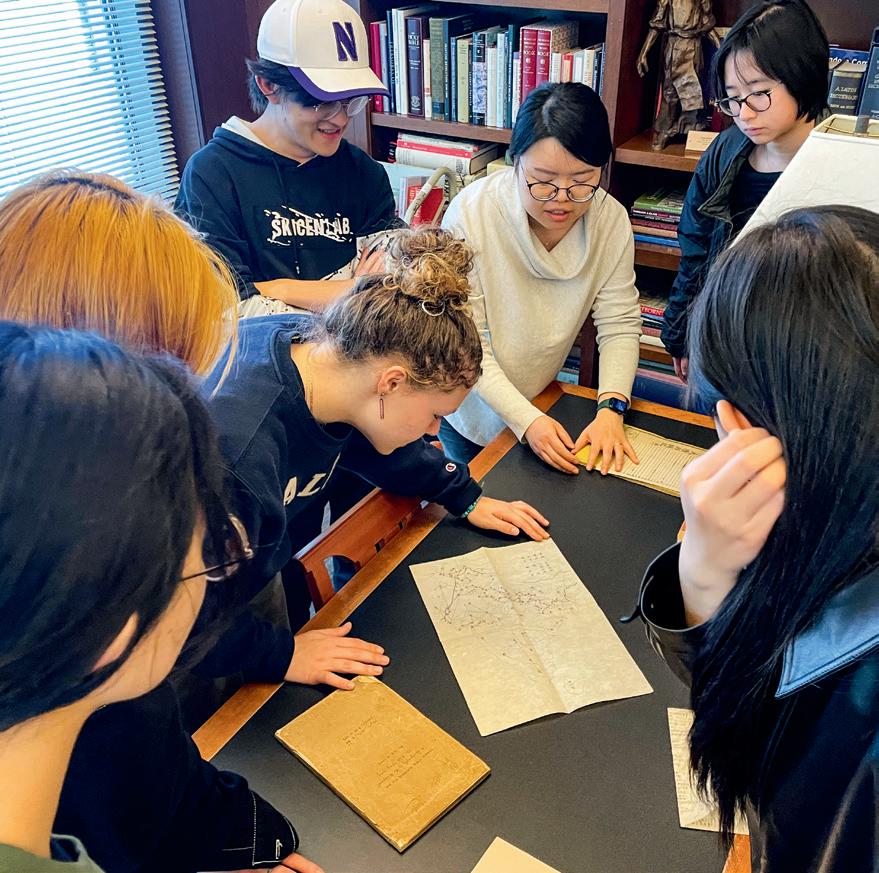
Emory’s purchase of this body of work from Hartford Theological Seminary in 1975 established Pitts as one of the nation’s leading theological libraries. Other items in the collection highlight how China and other countries view one another. Visitors can peruse “Records of the Western Regions,” a 7th-century chronicle of a Chinese monk’s journey through India. Later, this tale inspired “Journey to the West,” a juggernaut of a novel written in the 1700s that has sparked storytelling entertainment ever since, including operas, movies, TV shows, comics and video games.
Students in Zhu’s art history class, “Chinese Buddhist Art and Monuments,” developed a library exhibit based on students’ original research discoveries about many of the collection’s items. “East Asian Buddhism and the Christian Encounter,” planned for fall 2025, spotlights contrasting views of East and West by European and American missionaries and Buddhist pilgrims.
(top) An 1843 Buddha Amitabha print at Pitts Theology Library. (left) Students study maps in Pitts Library’s copy of “Journey to the West.”

A VITAL RESOURCE FOR RESEARCH
The final scene of “Raiders of the Lost Ark” gives Randy Gue chills. That’s when an anonymous worker loads the ark of the covenant which Indiana Jones has spent the entire adventure in pursuit of into a wooden crate. It is then wheeled down a long aisle to be locked away and forgotten forever in a nameless archive. “They don’t know what they’ve got there!” cries Indy.
The opposite is true of Emory Libraries. “What’s important to remember is this,” says Gue, the Rose Library’s assistant director of collection development. “Any given collection, that’s someone’s life legacy, right?”
At Emory, those legacies live on to find new life in in classrooms, exhibits, events and online digital archives, inspiring original research and critical engagement. And that’s what inspires trust in those whose donations hold great personal and historical value. Their choice to contribute signals the start of a robust relationship between donor and university — a relationship Gue takes very seriously.
“We can guarantee that these materials will be used by students and other scholars,” he says. “That’s the whole reason Emory has these collections. We're free and open to the public, and it gives students an opportunity they cannot get in classes at any other university in this country.”
With a preservation staff and conservation lab poised to provide a wide range of care services, it’s little wonder thousands of donors have trusted Emory Libraries to steward centuries worth of valuable collections and connect their stories of human experience to students and other scholars for generations to come.
Tracing the History of Modern Medicine
Besides connecting scholars and professionals to data and knowledge that support patient-based care, Woodruff Health Sciences Library also contains a panoply of archival material that explores the history of medicine.
Visitors can peruse a Civil War surgeon’s medical instruments, materials related to the discovery of anesthesia, as
well as photographs, medical instruments and 18th- and 19th-century books about human anatomy, pathology, surgery, midwifery and alternative medical practices.
Care to see a uniform belonging to Leila Anderson, a nurse who served in the World War I Emory unit in France?
That’s here, along with other items representing Emory’s health science history — including the medical journal kept by Nell Woodruff, for whom the Nell Hodgson Woodruff School of Nursing is named.

Groundbreaking Art from the AIDS Crisis
In one photo, a young gay couple sit at the foot of their bed, heads tilted toward each other. In another, a mother holds a photograph of her grown son, now deceased. In a third, a man sits in a hospital bed, turned toward the light of a window that’s out of frame. Beneath his image, a quote from poet Arthur O’Shaughnessy in the man’s own looping cursive:
“Alas for those who cannot sing but die with all their music in them."
In the late 1980s, Atlanta photographer Billy Howard took these portraits of people with HIV/AIDS, accompanied by their handwritten thoughts on living with and dying from the disease. The photos were gathered into his 1989 book, “Epitaphs for the Living.”
Howard’s project gave voice to a group who went largely unheard during the 1980s and 1990s, when there was no effective treatment for AIDS and people diagnosed with the disease faced tremendous public stigmatization.
The Rose Library houses a wealth of personal papers, mementos and artwork documenting the crisis in Atlanta, which emerged as a hub for AIDS art and activism. These include the papers of playwright, activist and poet Rebecca Ranson. Recent graduate Oli Turner 25C, who earned her bachelor’s degree in English
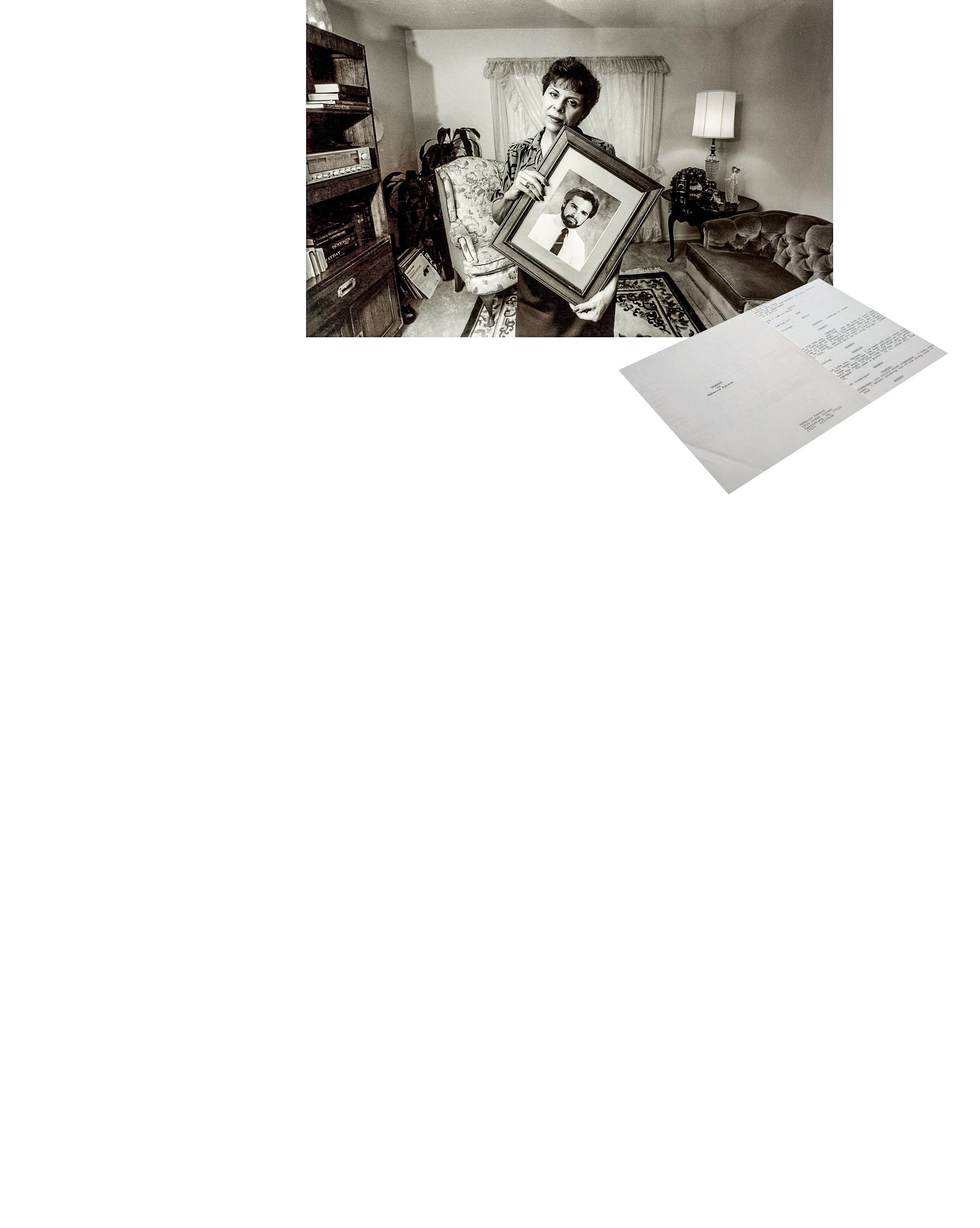
and creative writing this past spring, discovered Ranson through “The South in the Archive,” an English class taught by librarian Hannah Griggs.
Ranson’s play “Warren,” produced in 1984, became the first-known work of theater about AIDS. In the years that followed, it was performed around the country.
“I’m 21, so I didn’t grow up with the AIDS crisis in my consciousness,” says Turner, who wrote her senior honors thesis about Ranson, “and I really didn’t know the experience of people who lived through it.”
Ranson’s papers changed that.
“Reading those letters and journals,” Turner says, she felt a genuine connection between her generation’s LGBTQ activism and that time. “I was actually tearing up in the archive, because it transported me back to real and specific experiences from that era in a way that I don’t think other educational materials could.”
Items documenting Atlanta’s response to the HIV/AIDS crisis include Billy Howard’s photographs of people living with HIV/AIDS and the Rebecca Ranson play “Warren.”
Civil War surgeon’s medical instruments at Woodruff Health Sciences Library
A 15th-Century History of the World
A German-language printing of the Nuremberg Chronicle from 1493 is a shining star of Pitts Theology Library’s collection of early books, also known as incunabula. The Latin term literally means “swaddling clothes” and refers to printed matter in its 15th-century infancy.
“When it comes to early printed books, we have one of the strongest collections in the Southeast, and more than any other place in Georgia,” says Brandon Wason, head of special collections at Pitts, which houses about 120 incunabula
What first draws the eye to the Nuremberg Chronicle is its impressive size — the closed book measures 22 by 30 inches, a size called “imperial.” Published one year after Columbus set sail, it comprises an illustration-rich history of the world,

viewed through the lens of late 15th-century Germany, beginning with the Biblical stories of creation, Adam and Eve and the Great Flood, and moving on to the lineages of European bishops and kings.
An artifact of “old-world understanding,” says Wason, nowhere on these pages will the reader find the existence of the indigenous peoples or a drop of history outside of Europe. At its center sprawls a two-page woodcut of Nuremberg itself, the city where the book was fabricated. The Chronicle contains 1,809 woodcuts in all, produced from 645 blocks, making it the pinnacle of printing from this period and fascinating to art history scholars.
Most of the illustrations in the Pitts Library’s copy are in black and white. Filling them with color or hiring someone to do so would have been left to a wealthy purchaser — meaning every copy is unique. The one in the Pitts Library collection is a rare German-language version; the Rose Library holds its Latinlanguage twin.
Freedom Riders Leave a Legacy for Future Generations
Living a meaningful life has long been a guiding principle for Joan Browning and Charles Person, two courageous participants in the 1961 Freedom Rides during the Civil Rights movement. They donated their personal papers

and mementos from the Freedom Rides in hopes of inspiring future generations to take action and help shape a more just world.
Just 18 years old, Person was the youngest rider on the very first Freedom Ride, which traveled from Washington, D.C., to Birmingham, Alabama. While a student at Morehouse College, he also participated in sit-ins, risking arrest to challenge segregation at lunch counters across the city.
Browning, a white student at what is now Georgia College & State University, was expelled in 1961 for attending a Black church — a bold act
The Nuremberg Chronicle is a history of the world from a 15th-century perspective.
A jail note from Joan Browning's collection, in the care of Emory's Rose Library.
of solidarity. She went on to join the Albany Freedom Ride and was jailed for her activism.
Among the most poignant items in the collection are notes scrawled on scraps of toilet paper and napkins passed between Browning and fellow activists while they were jailed in Albany. One note from Browning reads: “Spirits over here are fine … . We have found a name for our present residence. Over my door is, ‘Welcome to the Crossbars Hotel.’ Keep the chins up — we are still winning. Love to all, Joan.” Another scrap bears Martin Luther King Jr.’s phone number — a powerful artifact of history scribbled on the most ephemeral of materials.

CHRONICLING THE AFRICAN AMERICAN EXPERIENCE
The Rose Library’s African American collections reflect the lives of peoples of African descent in North America, from their beginnings through present day, including social, political and cultural movements, as well as literature, sports and the arts.
Visitors may browse the minutes of the Student Nonviolence Coordinating Committee (SNCC), page through drafts of Langston Hughes’ poems and scripts,

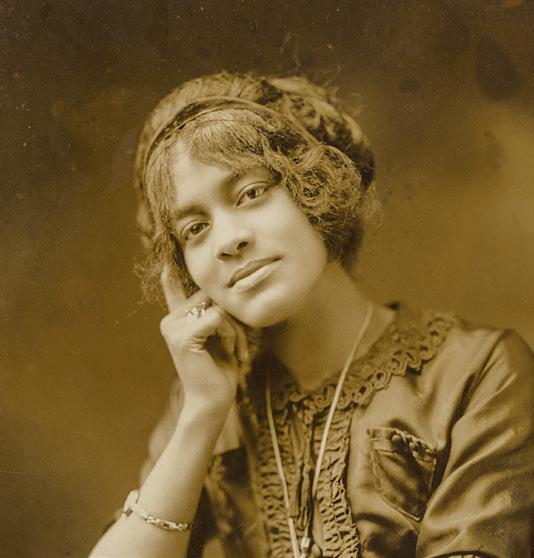
thrill to the adventures of Dwayne McDuffie’s comic book heroes or peruse more than 12,000 photographs of centuries of African American life. Whether it’s scrapbooks belonging to jazz legend Josephine Baker, original photos from “The Wiz,” or the drafts of Black Arts movement poet Carolyn Rodgers, this collection constitutes a critical resource for students, faculty and visiting scholars alike.
Capturing Atlanta Underground
Jon Arge took his Polaroid camera everywhere he went. In a time before camera phones, he documented the city’s gay nightlife in the 1990s at clubs like Backstreet and Metro — where cameras were otherwise banned. He also captured Atlanta’s vibrant drag scene, as well as house parties and fundraisers for AIDS-support organizations.
“After you got the image, you were holding the object the moment created,” Arge told Gue in an interview. “All the energy of that moment transfers into [the photograph] and it recharges the moment.”
The Rose also captures that ephemeral creative spirit in its collection of Atlanta’s punk music scene from 1980-2009, including zines, posters and photos. The collection has sparked events like DIY Fest, the popular annual gathering featuring music and hands-on art activities that Emory’s visual arts concentration hosts in partnership with the Rose. Along the way, classes studying the Rose’s collection have inspired students to embrace punk’s scrappy, anyone-can-do-it sensibility.
“Portrait of Blanche Thompson, posing on a chair,” in the Rose Library’s Robert Langmuir African American Photograph Collection
A pair of Polaroids by Jon Arge capturing 1990s gay nightlife in Atlanta and posters documenting the city’s punk rock scene.

The First Protestant Hymnal
With more than 18,000 religious songbooks spanning five centuries, Pitts Theology Library’s hymnody collection is second in size only to that of the Library of Congress.
So it’s a little mind-boggling to consider that nearly every work in the library’s collection, including the thick hymnals, the gospel songbooks and the rest — finds a common ancestor in one small, unassuming volume containing only eight hymns.
This is the Achtliederbuch, which literally translates to “eight-song book,” and it’s the world’s first Protestant hymnal, published in 1524. Pitts’ copy is one of only about 10 in the world, says Stephen Crist, chair of the Department of Music and professor of music history.
Crist teaches from Pitts’ copy of the Achtliederbuch and other hymnals as part of his “Singing the Sacred” class. Whether working with students or doing original research, he says, nothing matches the experience of holding an original songbook in your hands.
“Well, there’s no substitute for it,” remarks Crist. “Even very, very good scans don’t elicit the immediate emotional response. And it is one of the privileges of teaching at Emory. For this kind of work, Pitts Theology Library is second to none.”
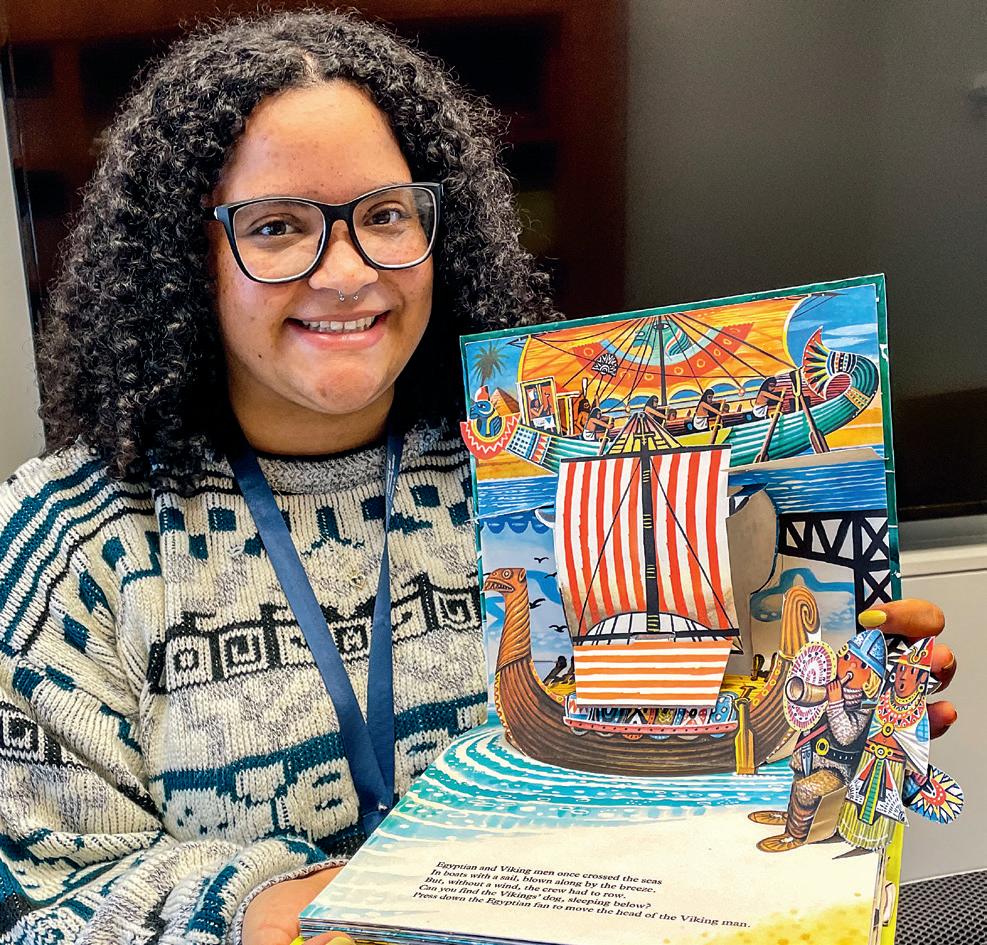
Exploring the Stories That First Shaped Us
One might think the vast collections at Emory’s Robert W. Woodruff Library are home only to weighty tomes of historical significance — but that would overlook a heartwarming and surprising corner of the archive: the children’s literature collection, which includes nearly 4,000 books.
“Most academic libraries do not collect children’s books,” says Chris Palazzolo, director of collections and open strategies at Woodruff Library. “Most libraries are acquiring the latest monograph on Hobbes, Locke, or the French Revolution,” he jokes.
The collection focuses on children’s books that have won prestigious honors like the Caldecott Medal and Newbery Medal. But it also stands out for its depth and historical range.
Rose Library student employee Mya Green 26C, a senior majoring in history and minoring in anthropology, curated “Pages of Wonder,” an exhibit featuring children’s literature. (far left) The Achtliederbuch is the world’s first Protestant hymnal.
new dress of spring. A 1960 edition of “Paddington” — one of Palazzolo’s favorites — is another gem.
“When I first started, we had a lot of staff and faculty who would hear about the collection from our library staff, and they would check out items for their kids,” he says. Instead of scholarship, he says, they were using it for leisure, “and we want to support that as well.”
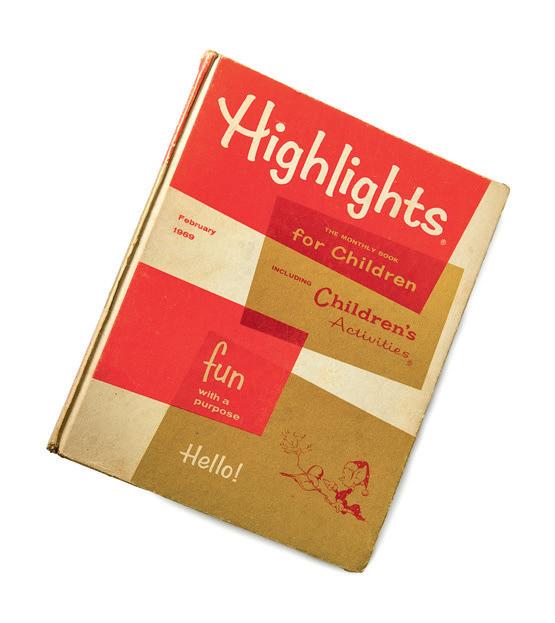
For example, Palazzolo highlights “Pumpkin Moonshine,” a 1938 book by Tasha Tudor about a young girl chasing a runaway pumpkin. Another Tudor title, “A Tale for Easter” (1941), evokes childhood memories of bunny rabbits, colored eggs and the first
And while the collection is a resource in its own right, it is also part of a broader effort at Emory to explore and preserve children’s literature as a cultural and historical artifact. Scholarly uses include students in Emory’s African American Studies PhD program who delve into the collection to study the representation of race in children’s literature. Meanwhile, events like the Rose Library’s 2024 exhibit “Pages of Wonder: A Journey Through Literature for Children” showcase the evolution of children’s storytelling — from fairy tales and puzzles to pop-ups and picture books.

A Collection to Sink Your Teeth Into
Children of the night, rejoice! In what may be the most comprehensive collection of Bram Stoker’s materials in the world, visitors to the Rose Library can pore over correspondence and manuscripts in the “Dracula” author’s spidery hand, as well as photographs, playbills, original artwork and hundreds of books, mostly Stoker’s own.
Stoker’s 1897 novel inspired nearly every vampire tale that has swooped onto the scene since — from the 1931 Bela Lugosi film to the “Twilight” books and movies, to the cult comedy film and TV show “What We Do in the Shadows.”
The Rose’s collection is made up of 4,000 items. Its 1,500 books include first editions of “Dracula” and Stoker’s other works, There are also first-edition translations of “Dracula” in four languages, as well as vampire-themed board games, comic books and movie posters.

The collection is the result of 40 years of work by John Moore, a private collector from Ireland. It was important to Moore to place the collection with a major academic library that would make it accessible to students and other scholars.

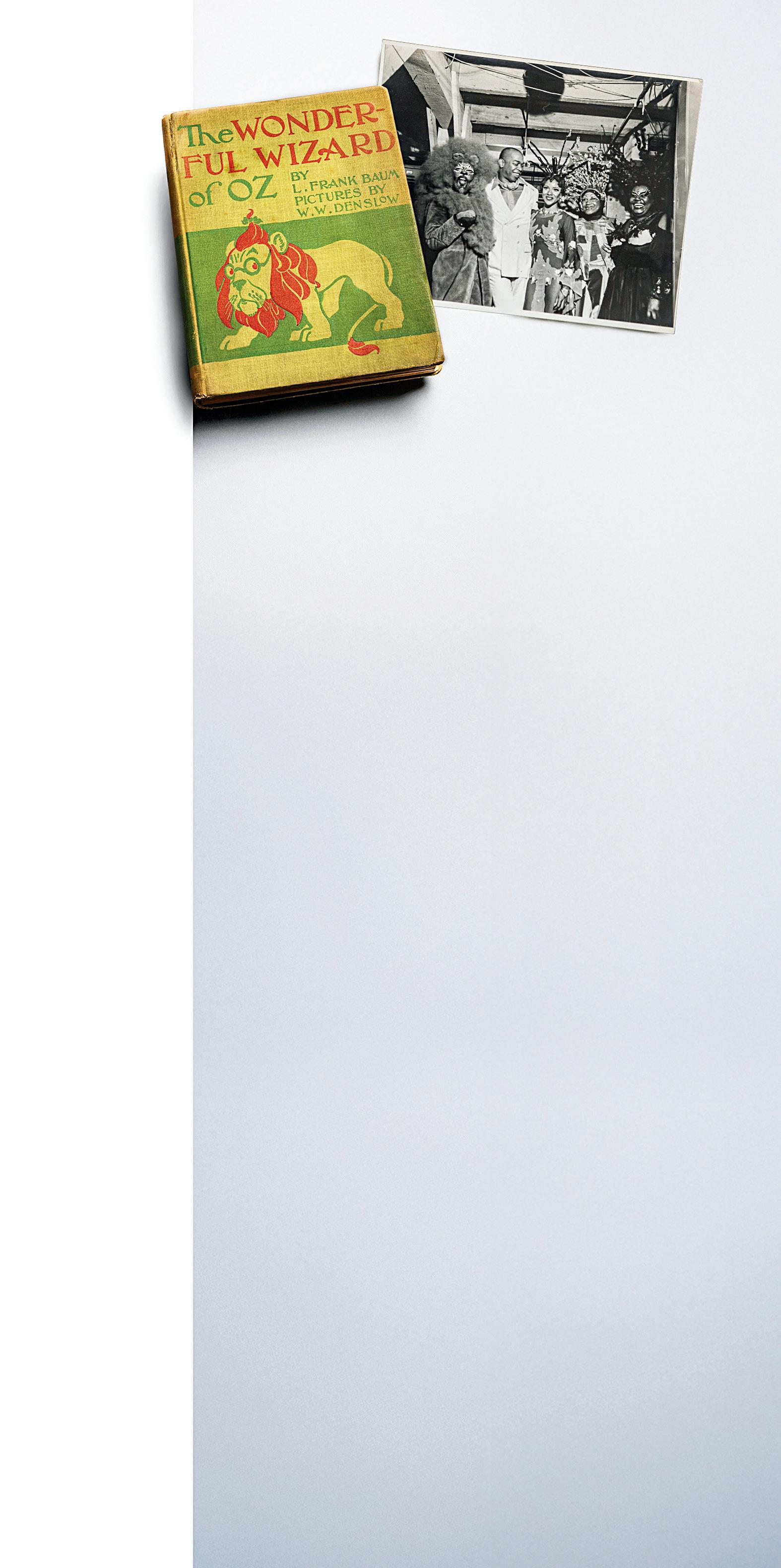
Easing on Down the Archive: Preserving the Legacy of ‘The Wiz’
Musical theater smash hit “The Wiz” opened with its first performance in Baltimore in 1974, launching a bold, joyful reimagining of “The Wizard of Oz” through the lens of Black culture. Since then, the show has achieved legendary status — and several tangible pieces of that cultural legacy now reside at Emory.
In 2018, Emory’s Rose Library acquired the personal collection of Geoffrey Holder, the Tony Award–winning director and costume designer of the original Broadway production of “The Wiz,” and his wife Carmen de Lavallade, an acclaimed actress, dancer and choreographer.
From original costume sketches to rare behind-the-scenes photographs, the early creative days of “The Wiz” come alive in the Rose’s collection. Vibrant renderings of iconic costumes — including the Scarecrow’s patchwork and the Wiz’s regal, futuristic robes — reflect Holder’s visionary aesthetic. The archive also includes his original costume design contract, candid rehearsal photos and detailed pencil sketches of sets that capture the production’s imaginative scope.
In fall 2023, as the pre-Broadway revival tour of “The Wiz” arrived at Atlanta’s Fox Theatre, the Rose displayed items from the collection in an exhibit — celebrating Black theatrical brilliance and the enduring magic of Holder’s vision.
The Bram Stoker collection includes handwritten manuscripts, first-edition translations of “Dracula” and colorful comic books.
A rare first-edition of “The Wonderful Wizard of Oz” and a backstage photo from the original Broadway production of “The Wiz.”
THE RECASTING 'VILLAIN'
BY KATE SWEENEY
Nominated for seven Tony Awards, Kimberly Belflower’s bold coming-of-age drama
“John Proctor Is the Villain” is the talk of Broadway — but to hear her tell it, the Emory playwright’s success was anything but expected.

OPENING NIGHT
Playwright
If you had told a college-aged Kimberly Belflower that one day she’d have a smash hit play on Broadway while teaching promising young playwrights at Emory University, she might not have believed you.
“I’d have been like, ‘Uh, what do you mean?’” she laughs.
These days, the assistant professor of dramatic writing in Emory’s theater studies and creative writing programs says she’s soaking in every moment from the Broadway success of her play “John Proctor Is the Villain.”
The drama has drawn rave reviews from critics and was nominated for a total of seven Tony Awards this year, including best play.
The drama is a coming-of-age story about a group of high school girls reading the Arthur Miller play “The Crucible” at their small-town Georgia high school when they start to notice similarities between the lives of the characters in the play and scandals brewing in their
own world. Belflower’s play, which draws parallels between the Salem witch trials and the #MeToo movement, first drew attention during runs at Studio Theater in Washington, D.C., and Huntington Theatre in Boston. Its Broadway premiere at the Booth Theater in April was directed by Dayna Taymor and featured Sadie Sink in the lead.
Belflower’s previous plays include “Gondal,” “Lost Girl” (winner of the Kennedy Center Darrell Ayers Playwriting Award), “The Sky Game” and “Only Reason” (formerly titled “Teen Girl FANtasies”; co-written with Megan Tabaque). Her work has been commissioned, produced and developed by theaters and colleges around the country.
“It’s been pretty thrilling,” says Belflower of her Broadway debut. “At the same time, I’m also trying to remind myself to just slow down and be present for it."
The cast of “John Proctor Is the Villain” takes a curtain call at the Booth Theatre on opening night.
Kimberly Belflower (center, wearing a pink dress) stands between lead actor Sadie Sink (left) and director Dayna Taymor (right).

GETTING TO BROADWAY
That’s been the case every step of the way, says Belflower, who’s still a little floored about how her play reached this point.
It started with a movie star. Or, more accurately, with a text from her agent about a movie star.
“My agent told me he was going to get my play in front of Sadie Sink,” Belflower says.
Sink, famous for playing teenage Max in the Netflix series “Stranger Things” and starring in that 10-minute Taylor Swift music video for the song “All Too Well,” began her career on Broadway and wished to return to the stage.
Belflower says she dismissed the idea as a long shot.
“Then, a few months later — long enough that I’d forgotten about it — he texted me, ‘Sadie Sink read the play. She loves it. She wants to be Shelby,’ which is one of the two leads.”
So began a whirlwind year and a half which included a staged script-reading with Sink and other actors, chats
DRAWN TO COMING-OF-AGE STORIES
Kimberly Belflower likes to write about teenage girls because, though they are unfairly disrespected, "they're so smart and weird and cool."
about creative direction with Tony-winning director Taymor, “whom I’d been dying to work with,” says Belflower, and waiting. Lots of waiting.
Finally, the play’s Broadway debut was confirmed in October 2024. “And [I was] so excited,” Belflower says. “At every moment I try to tell myself, ‘If all that happens is this, then this is more than I ever thought would happen, and I'm gonna just try really hard to soak it up, be present and take it day by day.’”
WHY JOHN PROCTOR ISN’T THE HERO
The story of the play began in 2017, when Belflower picked up a book by historian Stacy Schiff about the Salem witch trials, a topic she thinks “a lot of women and girls are interested in.”
She says one reason for this interest can be found in an assertion Schiff makes early on: that the witch trials and the suffrage movement were the only two moments in American history when women played the central role.
Belflower says the book opened her eyes to the historical realities of the young women accused of witchcraft in late1600s Massachusetts.
“Many were orphans,” she says. “Many of them had been sexually assaulted; it was just this really bleak reality of these men manipulating them in order to get land or gain power.”
Shortly after she finished the book, the world saw the first accusations that would proliferate into the #MeToo movement, in which women publicized their experiences of sexual harassment or assault, often using social media.
“And I was like, ‘Oh, this feels like another moment in time when women are at the center,’” Belflower says. “And then, I think it was Woody Allen who first called #MeToo a ‘witch hunt.’”
Belflower decided to reread “The Crucible,” the Arthur Miller play about the Salem witch trials based loosely on historical records. At the center of the play is the protagonist John Proctor, who has rebuffed the advances of his former servant, 17-year-old Abigail, after ending a previous affair between them.
“When I’d read it in high school, John Proctor had been this classic tragic hero, and Abigail, this teenage hussy,” Belflower recalls.
Rereading the play in the aftermath of #MeToo, she adds, shocked her. “I heard myself say, ‘It’s crazy, because John Proctor feels like the villain.’”
THE MOST INTERESTING STORIES ARE ABOUT MOMENTS OF CHANGE
BOOKISH SOUTHERN GIRLS
Belflower says she often felt like an outsider growing up in rural White County, Georgia.
“I mean, I’m still the only person in my family who doesn’t farm,” she laughs, quickly adding that they are very close regardless. “But when you grow up in a small Southern town and your family is all interested in doing the same thing, it's like, ‘How do I even imagine something else?’ Books transported me to other places.”
Belflower, whose skin is emblazoned with tattoos of resilient heroines from the chapter books she couldn’t put down as a girl — Matilda, Ramona Quimby and Harriet the Spy — places many adolescent girls at the center of her own work.
That’s when a bell went off. “When I start to get certain feelings in my gut and in my brain,” she says, “I know, ‘This is going to be something.’”
She had already submitted a different play to the Farm Theater’s College Collaboration Project supporting earlycareer playwrights. During her interview, the program’s director asked what else she was working on.
She told him about her new obsession with “The Crucible” and #MeToo. “And he said, ‘Oh, that’s the play I want to commission,’” Belflower recalls.
As part of her research, Belflower interviewed young women who’d been in high school and college during #MeToo. She asked them about topics ranging from their recollections of “The Crucible” to their experience of sex education.
The conversations led to a breakthrough. Belflower says she realized that the students felt no connection to the men who’d been outed for sexual misconduct, including “Harvey Weinstein, this dude who’d produced movies before most of them were born.”
She asked them: “‘What would you feel like if Harry Styles were accused of the same things?’ And they were like, ‘Well, he wouldn’t be.’ And I said, ‘Okay, but what if he was?’”
Belflower was discovering a central conflict of her play: What happens when someone you know and trust is guilty of sexual misconduct? What are the implications for the larger world you live in?
At the same time, she says she saw parallels between the conservative, religious small town where she was raised and the culture of Puritan New England depicted in “The Crucible.”
“I keep saying, I wish this play wasn't still relevant,” she says, “but things repeat themselves.”
Her play “Lost Girl,” which she directed at Theater Emory in fall 2023, reimagines the world of Peter Pan from Wendy’s perspective. The later “Gondal” brings together the Brontë sisters and a group of contemporary teens obsessed with Slender Man, an urban legend originating online.
“I also wrote fan fiction in high school,” she says, “so, recontextualizing stories is how I learned to write and how I learned to be.”
She is drawn to writing about teenagers largely because tumultuous times make for good storytelling.
“The most interesting stories are about moments of change,” she says. And, in your teen years, “your literal body is changing, and you’re experiencing every feeling for the first time.”
Circling back to this play’s #MeToo-related themes, she adds, “I also think teenage girls are the most disrespected people in the world. At the same time, they’re so smart and weird and cool. I just love them.”

MORE THAN A STRANGER
“John
Proctor Is the Villain” netted actor Sadie Sink a Tony nomination.
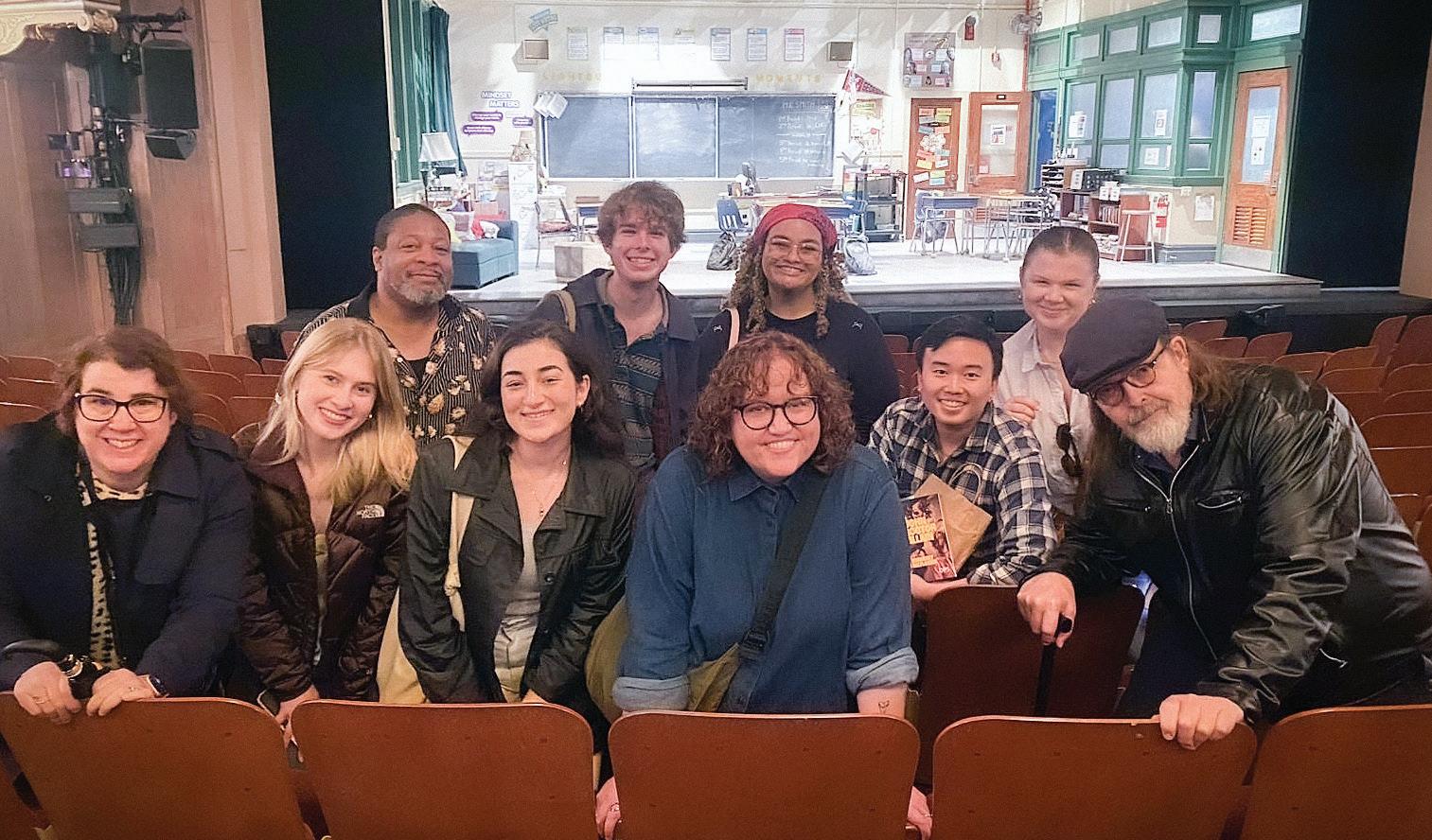
‘LIKE
SEEING MY LIFE ONSTAGE’
DRAMATIC INSIGHTS
Emory students visited Broadway’s Booth Theatre to see the play and discuss it with Belflower.
Emory students connect deeply with professor’s play during trip to Broadway.
For a group of Emory theater students, seeing “John Proctor Is the Villain” on Broadway wasn’t just a field trip to New York — it was a mirror held up to their personal experiences.
“It was like seeing my life onstage,” says Tai Jackson 26C. “I mean, modern day, rural Georgia! Not many stories on stage or even on screen do that. By the end, I was just euphoric, with tears welling up because it felt like watching my friends going through something.”
Jackson was one of six Emory students selected by Theater Emory to fly to New York in May to see the Broadway debut of the play written by their professor Kimberly Belflower. “I mean, where else but Emory would I have the opportunity to fly to New York to see my professor — someone I see all the time in the halls of my theater building at school — at her successful play on Broadway?” Jackson says.
Like Belflower, he grew up in a small Georgia town, making the play’s depiction of Southern teenage life all the more poignant. The experience even inspired him to consider writing a play of his own.
The lifelike dialogue of “John Proctor Is the Villain” struck a similar chord with Morgan Schatmeyer 26C, who also went on the trip. “I just think there’s never been anything like it before onstage,” she says. “Like, that is what my friends and I actually sound like when we talk. And it just made me feel so empowered as a teenage girl myself.”
For Schatmeyer, supporting Belflower felt deeply personal — an exciting chance to cheer the success of an educator who cares so deeply about student work.
“Kimberly is someone who attends every single show that we do,” Schatmeyer says. “She came to the very first student production I was in, and I remember thinking, ‘Wow, this professor cares so much.’”
Although she often felt out of place while growing up, Belflower has since realized that her background is an “artistic superpower.” She feels passionate about setting her work in the South and depicting the people who live there in all their nuanced complexity.
“I was raised in a two-stoplight town in Appalachian Georgia and that is not a lens on the world that a lot of people have,” she says.
STUDENTS KEEP HER GROUNDED
During the months of uncertainty about her play’s Broadway debut, Belflower felt extremely grateful for her Emory students, who, she says, save her from the threat of cynicism posed by the theater world’s business side.
“To see the wonder in their eyes when they talk about something that they’re working on,” she says, “I’m reminded that this is what it’s all about — being in touch with that 20-year-old inside of me while empowering these 20-yearolds to bring themselves to these stories.”
She received an especially poignant reminder while directing her play “Lost Girl” at Theater Emory in fall 2023. Belflower wrote the play’s first pages while an undergraduate herself at Columbus State University in the aftermath of romantic heartbreak. “And so, working on this together, with this group of undergrads was just moving beyond belief,” she says.
These days, Belflower is writing a play about someone in her 80s, with no teenagers in sight. But she says it doesn’t feel like a departure.
“I think we are always coming of age, you know? We experience these seismic shifts at different points. So, girlhood has always resonated with me, but I think the reason for that is I’m always changing and always growing and always becoming a new version of myself.”
While trying to stay present, she is still excited. Excited to see a dance sequence in “John Proctor” unfold on a Broadway stage. Excited to host six Emory theater and playwrighting students to New York to see the show.
“Obviously I’m excited about whatever opportunities come out of this,” she says. “But the main thing is that I’m just excited to keep telling stories.”
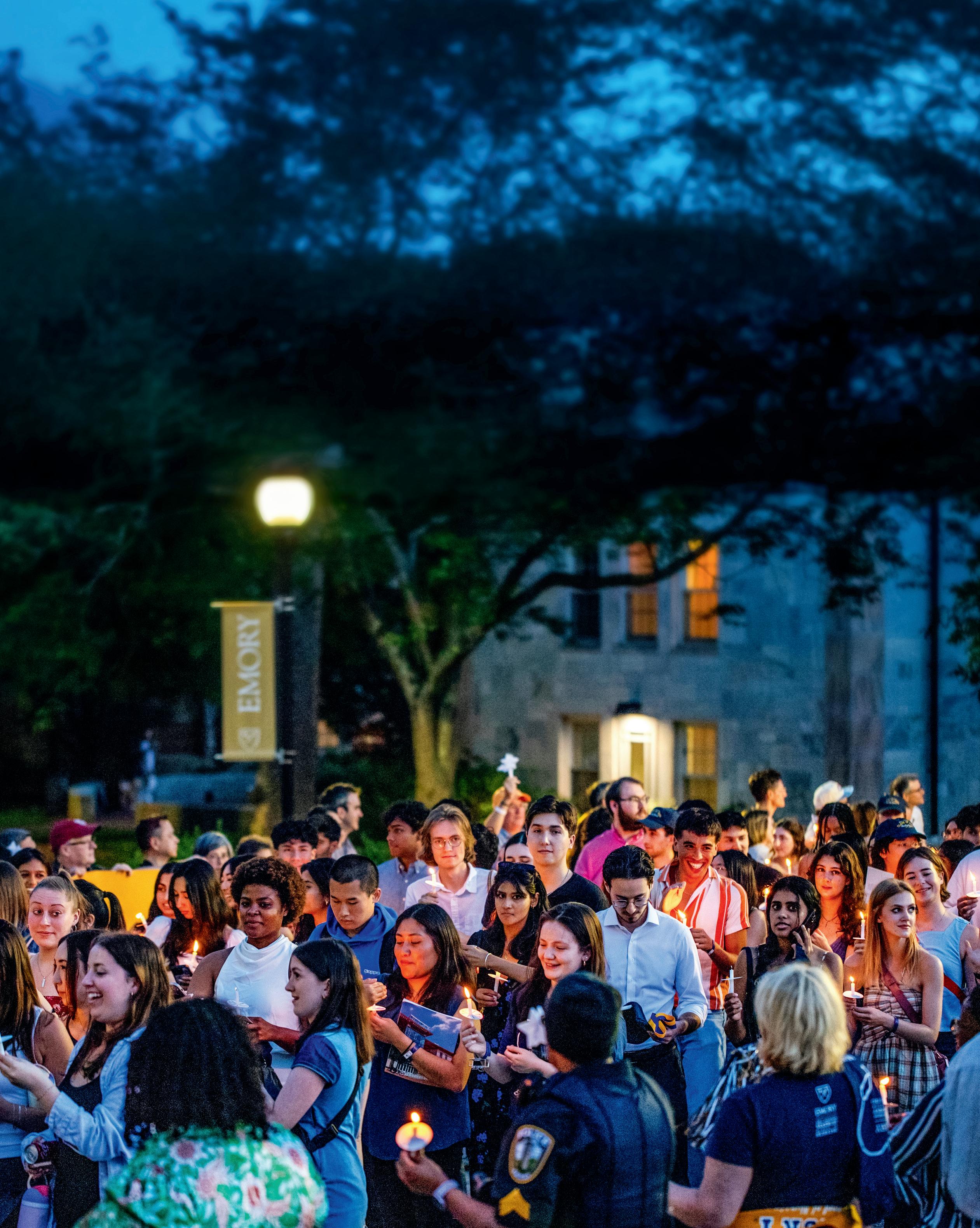
Illuminating the Future
As the sun dipped below the Atlanta skyline, casting a warm glow across Emory’s campus, the Class of 2025 gathered just days before Commencement for one of the university’s most beloved traditions — the Candlelight Crossover. This poignant ceremony marks the moment students symbolically “cross over” from undergraduates to alumni, stepping into a lifelong connection with the Emory community. Lined along the path were faculty, staff, alumni and other supporters, their cheers and applause echoing with pride and encouragement. For many alumni in attendance, the ceremony brought back memories of their time at Emory, bridging generations through a shared ritual of transition and celebration. The procession culminated at the Emory Student Center, where these soon-to-be-graduates were welcomed with a festive party featuring student DJs, celebratory treats and photo opportunities that captured both the joy of the night and the promise of the journey ahead. — Anna Chapman
ALUMNI INK
Recently Published Works by Emory Alumni

SLICE OF PURA VIDA-DISE
Kristen M. Brown 08B
This large-format, fine-art photography book is a stunning visual journey through the soul of coastal Costa Rica, captured by photographer Kristen M. Brown. Spanning over a decade of Brown’s photographic work, this volume features more than 150 vibrant images showcasing the country’s pristine beaches, golden sunsets and the laid-back surf culture that defines the “pura vida” lifestyle. Accompanied by whimsical poems and local insights, the book offers more than visual delight; it provides a heartfelt narrative that resonates with both seasoned travelers and dreamers alike. Whether you’re reminiscing about past adventures or seeking inspiration for future journeys, “Slice of Pura Vida-Dise” serves as a reminder of nature's allure and the simplicity of life in paradise.
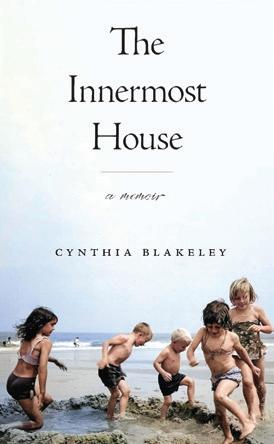
THE INNERMOST HOUSE: A MEMOIR
Cynthia Blakeley 96G
Author Cynthia Blakeley grew up in a 19th-century saltbox house in Massachusetts, surrounded by extended family and the emotional distance of her loving but elusive mother and strict father. As she explored the Outer Cape with her cousins — swimming, beachcombing and dancing in Provincetown — she also turned inward, filling journals with questions and memories. Years later, Blakeley returned home to uncover the family stories that shaped her. Her memoir navigates memory, secrecy and identity, asking how the stories we tell — about others and ourselves — define who we are.
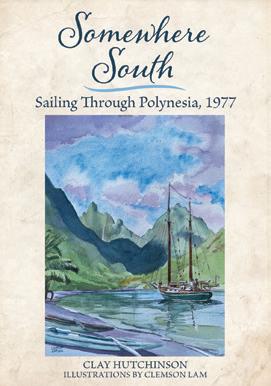
SOMEWHERE SOUTH: SAILING THROUGH POLYNESIA, 1977
Clay Hutchinson 70Ox 72C
Author Clay Hutchinson recounts the unforgettable 1977 voyage he undertook as one of three young, inexperienced sailors who set out from Hawaii aboard Lille Dansker, a wooden gaff-rigged ketch. With no fixed destination beyond “somewhere in the South Pacific,” the crew faced life-changing challenges at sea. They also worked and fished alongside locals, gaining a deep respect for island life and the rhythms of nature. The journey tested their resilience and forged a lasting appreciation for teamwork, self-reliance and the unpredictable wisdom of the sea. This memoir captures a simpler time and the spirit of adventure.
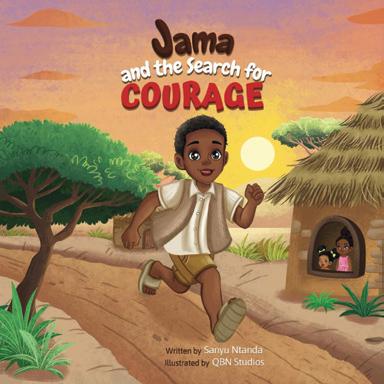
JAMA AND THE SEARCH FOR COURAGE
Sanya Ntanda 02C
“Jama and the Search for Courage” follows a 9-year-old boy from a small African village as he sets out on a mission from his father — one that will test his bravery and determination. Along the way, Jama faces unexpected challenges and learns that true courage isn’t the absence of fear, but the strength to act despite it. With vibrant illustrations and a heartfelt narrative, this picture book is geared for children ages 3–7. It gently introduces themes of resilience, bravery and family bonds, all set against the vivid backdrop of village life in Africa. Young readers gain a window into another culture while learning timeless life lessons about facing your fears with heart and hope.

CIRCULATING NOW, FULL CIRCLE
Jeffrey S. Reznick 99PhD and Elizabeth A. Mullen
Learn how the National Library of Medicine (NLM), the world’s largest biomedical library, is conveying the vitality of medical history in our 21st-century world in this newly published work. Senior Historian Jeffrey S. Reznick welcomes readers to explore the library’s timeless stewardship of a collection that spans 11 centuries, encompasses a variety of digital and physical formats and originates from nearly every part of the world. This book is an edited collection of curated posts from the NLM’s Circulating Now blog, which was created as a dynamic library and management resource.
SAVE THE DATE
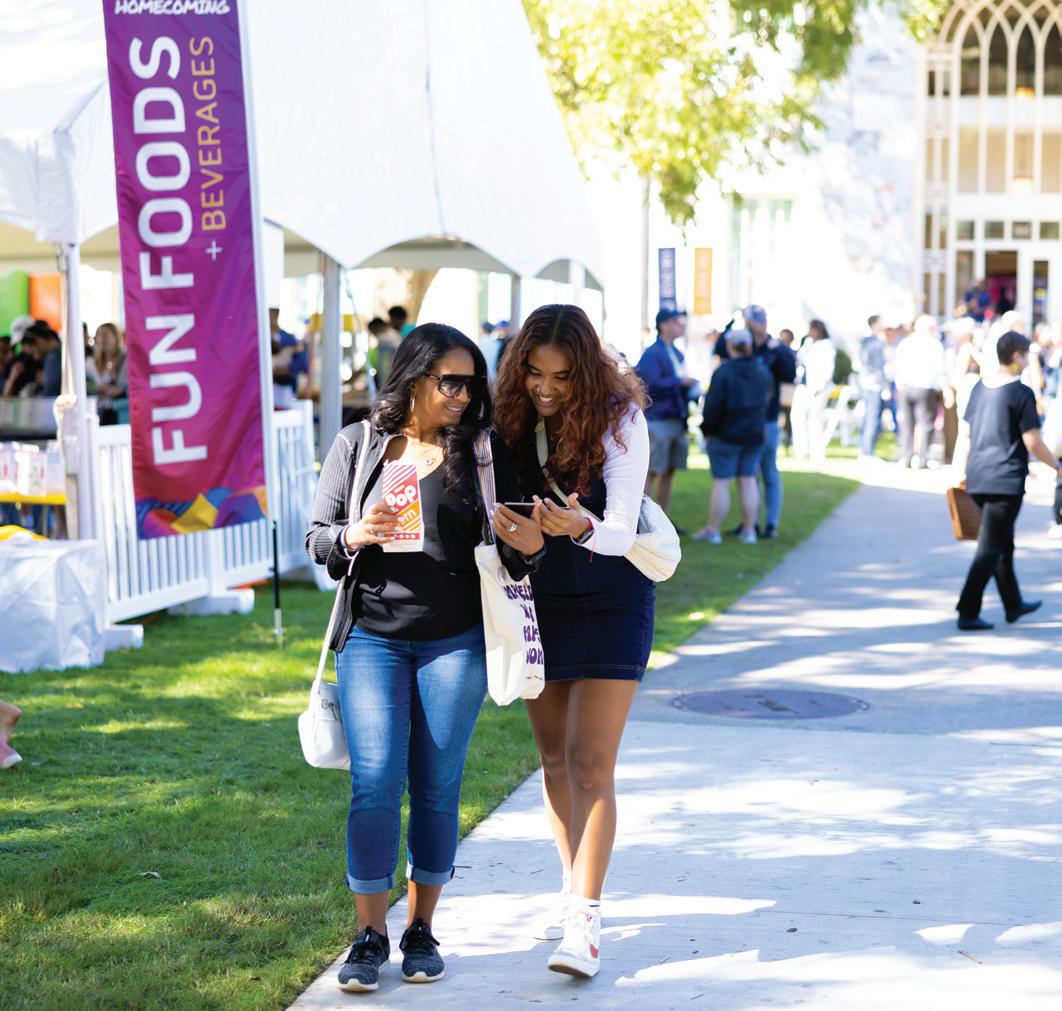
WINSHIP 5K
>> OCTOBER 4
Join us for the 15th-annual Winship 5K, where every step helps move cancer research forward. Since 2011, this beloved community event has united thousands in support of Winship Cancer Institute’s mission: to transform cancer care through groundbreaking research. Whether you run, walk, volunteer or donate, your participation fuels life-saving clinical trials, innovative treatments and enhanced patient care.
What began with 1,500 runners raising $200,000 has grown into a powerful movement — with over 40,000 participants and more than $11.4 million raised to date. Last year alone, the race drew 4,000 participants and raised more than $1 million. Funds support programs that benefit Winship’s 19,000 new patients annually and 1,350 enrolled in clinical trials. Two endowed professorships have also been established thanks to this event.
Be part of progress — join your fellow Emory alumni and help turn science into hope.
EMORY HOMECOMING AND FAMILY WEEKEND
>> OCTOBER 23-26
Reconnect with friends, explore campus, enjoy live entertainment, eat great food and celebrate at the largest Emory celebration of the year — 2025 Emory Homecoming and Family Weekend. Don’t miss the Alumni Reunion and Kickoff Party featuring class and affinity reunions. There will be many exciting campus programs and experiences for the entire community, including the food and music festival and other family-friendly activities offered through the weekend. Whether you’re in a reunion year or just looking to connect, there’s something for everyone.
REGISTER ONLINE
15 TH ANNUAL WINSHIP 5 K WINSHIP5K. EMORY.EDU
HOMECOMING WEEKEND Registration opens July 14. TOGETHER. EMORY.EDU/ HOMECOMING

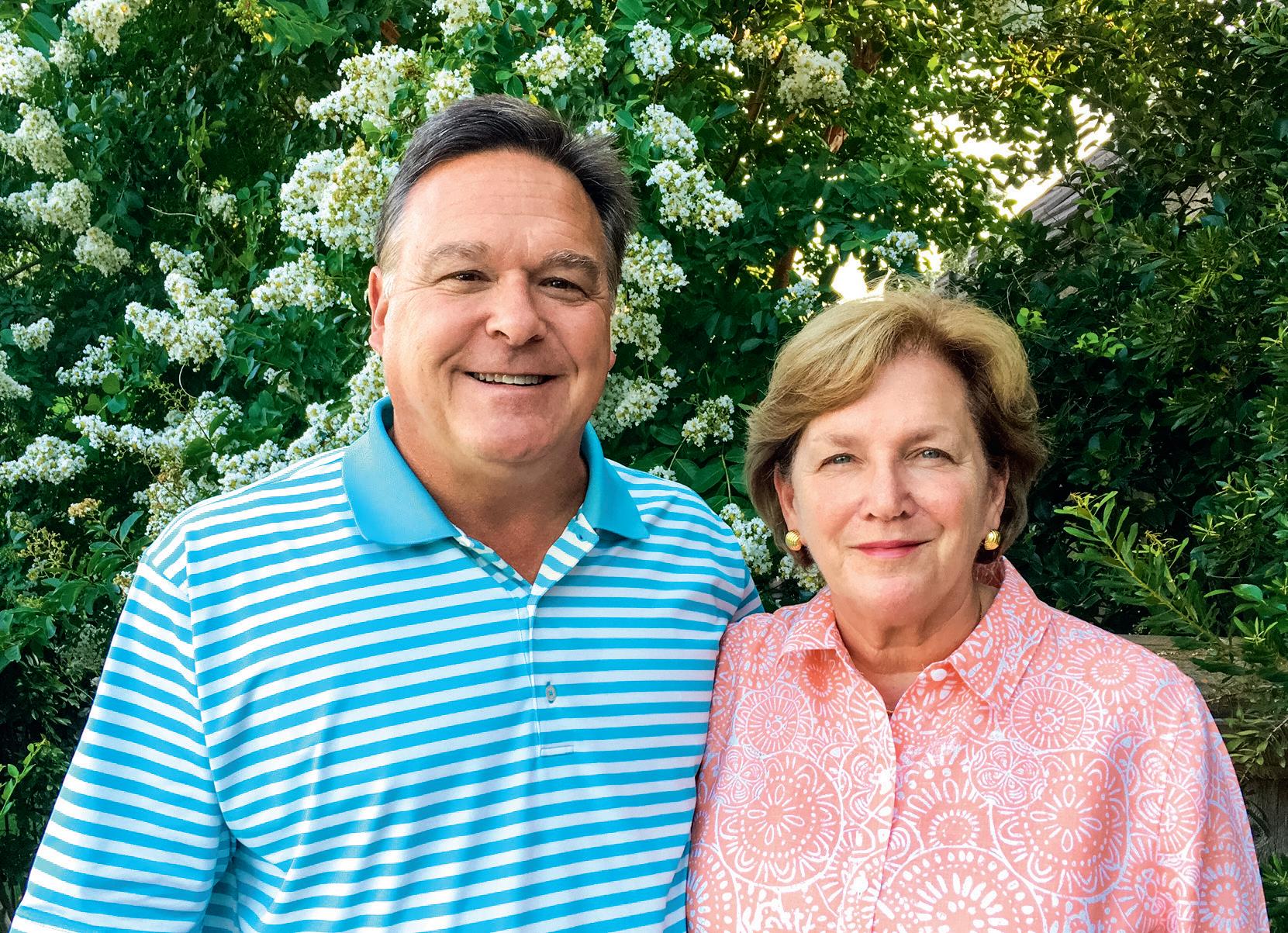
A Partnership in Marriage and Philanthropy
Alumni Tom and Susan Bisanz
Tom Bisanz 75B 80L first noticed Susan Hill 75B in a Goizueta Business School finance class on a dreary winter day. She walked in wearing a bright yellow raincoat, and he immediately sensed she would be important in his life.
“She would sit in the front row every lecture,” Tom recalls. “I’d sit in the back and watch her take out her notes — same routine every day. And I thought, ‘This is somebody I need to meet.’”
That class sparked a lifelong partnership — both in marriage and philanthropy. Today, Tom and Susan Hill Bisanz support Emory through two endowed scholarships: the Susan Hill Bisanz BBA Scholarship Endowment at Goizueta and the Thomas L. Bisanz Endowed Scholarship for the Center for Transactional Law and Practice at Emory Law. They’ve also contributed to the center’s growth and mission.
“We’ve found that so many students can use scholarship money,” Tom says. “It’s a sacrifice for parents to provide an education, particularly a private education like Emory.”
Scholarship recipient Yuwei Zhang agrees. “As an international student from China, the scholarship was crucial in making my Emory Law education financially possible,” she says. “It gave me the freedom to explore different legal paths without excessive financial pressure.”
Tom calls such feedback humbling: “You get back so much more than you give.”
The couple’s latest $100,000 gift will strengthen the William and Jane Carney Center for Business and Transactional Law, which trains students in hands-on legal skills like deal negotiation and document drafting — areas Tom wishes he’d had more exposure to in law school. “I didn’t have a center like this when I was in law school,” he says. “I would have loved the practical side.”
A longtime supporter of the center, Tom served on its advisory board for eight years and hosted its 15-year anniversary. He’s also a vocal advocate for William Carney’s recent $6 million matching gift to the center — an initiative he quickly pledged to support.
“I said, ‘I’m in for a significant match on that gift.’ The time is critical,” he says. “With that money, we can add faculty, provide scholarships and help the law school become top-tier.”
Tom’s philanthropic philosophy comes from his father: give back with time, talent and treasure. It’s a message he’s passed on to his children and to students. “If you start giving back as a student or young alum, you’ll carry that habit forward your whole life,” he says.
While the couple’s giving is rooted in gratitude, it’s also about impact. “We need to focus on the law school’s mission of training lawyers,” he says. “It’s important to alumni to see the credential remain strong and prominent.”
For the Bisanzes, giving to Emory is not about nostalgia — it’s about investing in future leaders.
“Emory remains very dear in Susan’s heart and in mine,” Tom says. “We’re grateful for the opportunity to give back — and we hope others will follow our lead.” — Michelle Babcock
help fuel Emory’s excellence in business and law.
LOVE, LEGACY AND GIVING BACK
Tom and Susan Bisanz met at Emory in the 1970s.
Building More Than Homes
Why Atlanta homebuilding visionary John Wieland supports Emory’s important work in ethics and brain health.
Few people have shaped Atlanta as tangibly as John Wieland. Over his decades-long career, he has built more than 30,000 homes — places where hundreds of thousands of Atlantans have lived, loved and created memories. And for more than a decade, Wieland has been helping Emory University protect those memories through his support of the Integrated Memory Care (IMC) program at the Nell Hodgson Woodruff School of Nursing.
Wieland’s connection to the IMC began when his wife, Susan, was diagnosed with Alzheimer’s.
“My wife’s situation progressed just as Emory was establishing the IMC under Dr. Carolyn Clevenger,” Wieland recalls. “Susan was one of the first to be treated under the integrated memory care model.”
This approach, says Clevenger, professor and clinical director of the IMC, has since set a new national standard for dementia care, now supported by Medicare and Medicaid. Wieland’s financial support enables Emory to extend IMC services to more than 20 senior living communities across metro Atlanta.
Wieland is also a big supporter Emory’s Center for Ethics, an advocacy that grew out of his service chairing the university’s Board of Visitors, which introduces new audiences to the university’s mission. “I got to know Dr. Jim Fowler and then-President James Laney through that appointment, and I went on to chair the Ethics Center Advisory Board for several years when Fowler was the director,” Wieland says.
Later, Fowler and Susan Wieland would share both an Alzheimer’s diagnosis and a doctor, neurologist Allan Levey, the director of the Goizueta Alzheimer’s Disease Research Center. Inspired, Wieland made a gift to support research at the center’s annual A Family Affair event.
“Brain health and ethics are my two deep interests at Emory,” Wieland says.
As a builder, Wieland has championed ethical standards for decades. Every prospective employee at a Wieland company must pass a vetted ethics test before being hired —
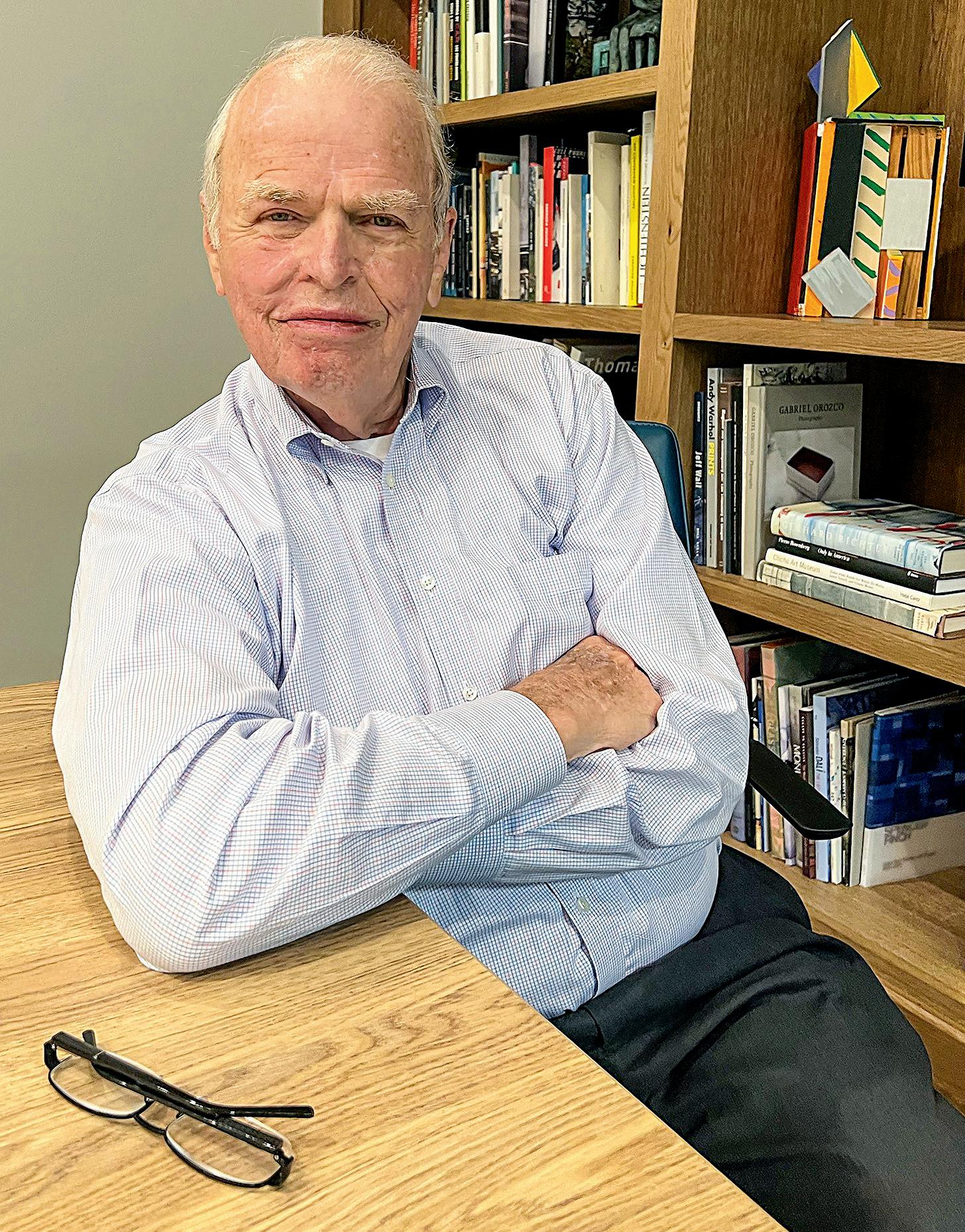
GROUNDBREAKER
a practice instituted more than 40 years ago. Wieland’s latest gift to the Center for Ethics will fund a faculty fellowship program, offering Emory professors a semester’s leave to pursue ethics-related projects. It will also bolster ethics research across the university, says center director John Lysaker.
Kathy Kinlaw, associate director of the Center for Ethics, has worked with Wieland for years. “This gift will strengthen our collaborative work and engage students in tackling complex ethical issues,” she says.
Wieland is especially passionate about helping young people navigate the flood of information they encounter daily. “It’s vital to teach students how to critically evaluate information and make thoughtful decisions,” he says. “Emory, with its culture of inquiry, is the perfect place for this.”
He adds: “Emory is infusing ethical thought into the curriculum, creating positive behavior patterns. It also offers endless learning opportunities — from visiting the Carlos Museum to attending a Schwartz Center performance. And if you’re lucky like me, you get to serve on committees and boards. It’s important to find your philanthropic niche, and I’ve found mine at Emory.” — Jennifer Carlile
John Wieland has found his philanthropy niche at Emory.

YOUR NEXT CAREER MOVE STARTS HERE
Whether you’re looking to grow within your current role, striving for a promotion, or transitioning to a new career, Emory Executive Education delivers the practical, marketrelevant knowledge and skills you need to stay competitive and excel professionally.
EXPLORE UPCOMING FALL 2025 PROGRAMS:
• Negotiations Strategy for Success
• Executive Communications & Leadership Presence
• Navigating Change for Growth
• Finance & Accounting for Non-Financial Managers
• Executive Coaching Program
• Select MBA electives open to non-degree participants
• Asynchronous Online courses covering topics in AI or Healthcare
ON-CAMPUS SHORT COURSE
All Emory alumni enjoy a 25% discount on Emory Executive Education offerings.
class notes
Neil Sklaroff 69C has been recognized in the 2025 edition of “The Best Lawyers in America” for land use and zoning law and litigation. He is a partner at Dilworth Paxson LLP in Philadelphia, Pa.
alpaca, whose wish for a baby sister is fulfilled in the form of Saachi, an angel. Set in a vibrant forest, the tale explores themes of love, acceptance and the bonds of family.
Sherri Silverman 71C had her artwork “Subtle Level Elemental Energies 1” featured in the 2024 Northern California Open at the Marin Museum of Contemporary Art. She also received an Adolph and Esther Gottlieb Emergency Grant, which supports mature visual artists in crisis. Silverman, a selftaught artist with a doctorate in creativity, art and the sacred, creates works informed by decades of meditation and spiritual practice.
Rodney O. Callahan 72T is a retired U.S. Army Reserve chaplain who achieved the rank of colonel during his 27 years of service. He also served as a chaplain with the Georgia Department of Corrections and at Pine Pointe Hospice in Macon, Ga. Walter B. Ferst 75L has been recognized in the 2025 edition of “The Best Lawyers in America” for his work in commercial finance law. He serves as of counsel at Dilworth Paxson LLP in Philadelphia, Pa. Harriet Paulk Hessam 76C and her granddaughter, Amelie Sultana Patel, co-authored the children's book “Saachi the Angel,” which received the Silver Award in the Spring 2024 Readers' Choice Book Awards. The story follows Amelie, an
Hudson Young 89Ox 91C has been appointed to the Human Rights Campaign (HRC) and HRC Foundation Board of Directors for 2024. A dedicated advocate for LGBTQ+ rights, Young has been actively involved with HRC since 2016, serving on the Board of Governors and as the Federal Club Council liaison. In 2024, he joined the Board Executive Committee and organized a Biden Victory fundraiser. He is the former president of Scholastic Services Inc.
Dr. Andy K. Su 92C was elected mayor of Mountain House, Calif., in March 2024, becoming the first mayor of the state's 483rd and newest city. He was sworn in on July 1, 2024, following a successful incorporation vote. Su also joined the San Joaquin Council of Governments Board in August 2024, representing Mountain House in regional planning efforts.
Michael B. Slade 96C was appointed to a 14-year term as U.S. Bankruptcy Judge for the Northern District of Illinois. He previously was a partner at Kirkland & Ellis in Chicago, Ill.
Rev. Tolton Pace 98C 02PH was appointed to the Atlanta Board of Education in January 2025 to represent District 6, following Eshé Collins’ election to the Atlanta City Council. Pace currently serves as a senior program officer at the Arthur M. Blank Family Foundation. His career spans youth development, philanthropy and education, including roles as a youth minister and Atlanta Public Schools educator.
Amanda Phillips 92Ox 94C was honored with the 2024 William Norton Outstanding Alumna Award by Oxford College. This prestigious award recognizes alumni who demonstrate exceptional dedication, loyalty and innovation in service to Oxford. Phillps is a board-certified OB/ GYN, health care leader and entrepreneur. She mentors students, supports nonprofits and serves on multiple boards focused on health, housing and community wellness. In 2019, she established an endowed scholarship to support underrepresented students at Emory, and she remains a champion of education, mentorship and community welfare at the university.
Dr. Nia Bodrick 07PH was named a 2024 Ascend Fellow by the Aspen Institute, recognizing her leadership in early childhood development and community resilience. A general pediatrician at Children’s National Hospital and assistant professor at George Washington University School of Medicine, she also serves as co-executive director of the Early Childhood Innovation Network in Washington, D.C. Her work focuses on strengthening systems that support children and families, particularly in
historically marginalized communities.
Jingzhi “JD” Dai 07BBA, managing director in Jefferies’ Debt Advisory and Restructuring Group, was named to the American Bankruptcy Institute’s 2024 “40 Under 40” list of emerging leaders in insolvency. He also co-founded Restructuring Asians in New York, a professional network.
David Jackson 07C has been recognized for the third consecutive year in the 2025 edition of the “World Trademark Review 1000: The World’s Leading Trademark Professionals.” A law partner at Womble Bond Dickinson’s office in Phoenix, Ariz., Jackson specializes in global brand strategy, trademark enforcement and intellectual property litigation.
Maham Khwaja 10C released her debut children's picture book, “The Home We Make,” through Lee & Low
and strive to rebuild a sense of home. Khwaja, a Pakistani American writer and filmmaker, previously worked on “Sim Sim Hamara” (Pakistan’s “Sesame Street”) and is developing her first feature film, “Auntie Express.”
Francesca Macchiaverna 11C was named a 2025 Georgia Super Lawyer in Business Litigation by Thomson Reuters. A partner at HunterMaclean in Savannah, Ga., she represents creditors in complex commercial disputes across Georgia and the Carolinas. Her practice includes bankruptcy, foreclosures and landlord-tenant matters.
YOUR KEY TO CLASS NOTES
AH: Allied Health
BBA: Goizueta Business School (undergraduate)
C: Emory College of Arts and Sciences
D: School of Dentistry
DNP: Doctor of Nursing Practice
FM: Fellowship in Medicine
G: James T. Laney School of Graduate Studies
H: Honorary degree
JM: Juris Master
L: School of Law
M: School of Medicine
Diana E. Neeves 11C was promoted to counsel at Robinson+Cole. Neeves specializes in environmental, energy, land use and telecommunications litigation and regulatory compliance. Avana
MBA: Goizueta Business School (graduate)
MSN: School of Nursing (graduate)
MR: Medical resident
N: Nell Hodgson Woodruff School of Nursing
OX: Oxford College
MPH: Rollins School of Public Health (graduate)
PhD: All doctor of philosophy degrees
T: Candler School of Theology
Books. Inspired by her own immigration experience, the story follows a young refugee girl and her family as they flee violence
Epperson-Temple 12C was honored with the 2025
SUBMIT CLASS NOTES TO: eurec@emory.edu
LEFT BLANK
LEFT BLANK
Carlene McKinnon Piloian 52N, of Oviedo, Fla., on May 6, 2024.
Fletcher Thorington 52T, of Birmingham, Ala., on November 25, 2024.
Susan Wall 52N 72N, of Arvin, Calif., on September 16, 2021.
T. Burton Wight Jr. 52B, of Buena Vista, Ga., of October 30, 2024.
Bascom F. Anthony 53C 56M 57MR, of Camarillo, Calif., on November 30, 2024.
Mary Sledd Barrett 53N, of Gainesville, Ga., on February 20, 2024.
Lillian Bragg 53N, of Livonia, Mich., on November 26, 2020.
Robert G. Strother 53T, of Spartanburg, S.C., on February 21, 2024.
Ben B. Blackburn III 54L, of Atlanta, on December 3, 2024.
John D. Hartness 54D, of Rocky Mount, N.C., on April 5, 2025.
Cameron H. Keels Jr. 54D, of Morganton, N.C., on April 10, 2025.
Pete Nick Poolos Jr. 54C 58MR, of Cleveland, Ohio, on March 17, 2025.
Lois L. Robinson 54N, of St. Johns, Fla., on May 20, 2022. Roy Hugh Ryan 54T, of Tupelo, Miss., on January 19, 2025.
Eugene Morris Zimmerman 54T, of Orlando, Fla., on November 5, 2024.
Mehadin K. Arafeh 55MR, of Middletown, Conn., on November 6, 2024.
Gretchen Leyda Artman 55N, of Lakeland, Fla., on December 18, 2024.
Florence F. Corley 55G, of Marietta, Ga., on August 18, 2024.
William B. Dillingham 55C 56G, of Decatur, Ga., on March 27, 2025.
Robert S. Donner 55C, of Macon, Ga., on September 1, 2024.
Kirk Terry Dornbush 55L, of Atlanta, on November 21, 2024.
Paul C. Garland 55B, of Statesville, N.C., on October 24, 2024.
Charles L. Hagood 55Ox 59C 62T, of Dacula, Ga., on July 24, 2024.
Martha Deariso Smith 55N, of Newnan, Ga., on November 19, 2023.
Othella P. Stillwell 55N, of Pickens, S.C., on June 16, 2023.
Wilton L. White 55C 58D, of Gainesville, Ga., on January 14, 2025.
Robert E. Williford Jr. 55M 58MR, of Asheboro, N.C., on June 21, 2024.
James E. Woodard 55Ox 58C, of Rome, Ga., on January 13, 2025.
Mary Emma McConaughey 56C, of Marietta, Ga., on December 19, 2024.
Ann Daniel McLean 56C, of Marietta, Ga., on March 27, 2025.
Richard A. Petry 56T, of Marietta, Ga., on August 29, 2024.
Stephen C. Woodward 56C 59M 62MR, of Sandy, Utah, on March 19, 2025.
Edmund L. Zibart 56T, of Auburn, Ky., on August 4, 2021.
Vincent C. Caranante 57D, of St. Petersburg, Fla., on July 16, 2020.
Preston T. Davis 57Ox 61C, of Tallahassee, Fla., on September 16, 2024.
Norman B. Ferris 57G 62PhD, of Murfreesboro, Tenn., on February 14, 2025.
William Ray Finklea 57T, of Lakeland, Fla., on March 1, 2025.
H. Donald Mizell 57T, of Melbourne, Fla., on November 25, 2021.
William F. Morgan 57C, of Annapolis, Md., on January 15, 2025.
Frances West Page 57N, of Nashville, Tenn., on December 31, 2023.
Hilt Tatum Jr. 57D, of Opelika, Ala., on February 17, 2025.
Joanne S. Taylor 57Ox 59C, of Tallahassee, Fla., on January 19, 2025.
Jack E. Wilson 57L, of Marietta, Ga., on August 5, 2024.
Frank E. Carlton III 58C 61M, of Savannah, Ga., on December 25, 2024.
Freeman Epes 58MR, of Sarasota, Fla., on October 20, 2022.
S. Clark Evans 58Ox, of Bartow, Ga., on May 12, 2024.
William A. Hamilton 58L, of Auburn, Ala., on November 11, 2024.
Betty Boyst Lawrence 58N, of Hunstville, Ala., on January 18, 2025.
June O'Shields 58N, of Jasper, Ga., on July 13, 2024.
L. N. Rhodes Jr. 58D, of Meridian, Miss., on February 24, 2025.
Glen Milton Starnes 58Ox, of Melrose, Fla., on February 26, 2024.
Elizabeth L. Thompson 58N, of Franklin, N.C., on May 14, 2022.
R. Chris Davidson 59B, of Saint Paul, Minn., on November 4, 2024.
LEFT BLANK
R. Eugene Davis 59T, of LaGrange, Ga., on October 6, 2024.
Martha Faye Ewing 59Ox, of Covington, Ga., on April 15, 2025.
Evelyn Harris Haller 59G 68PhD, of Lincoln, Neb., on March 27, 2025.
Harley L. Henderson 59Ox, of DeFuniak Springs, Fla., on January 30, 2025.
Helen F. Henry 59C 85T, of LaGrange, Ga., on October 2, 2024.
J. Neal Huffaker 59G, of Norman, Okla., on July 1, 2024.
Joan B. Hutchison 59N, of East Providence, R.I., on October 7, 2024.
James M. John 59T, of Roanoke, Va., on October 22, 2025.
Stephen G. Johnson Sr. 59T, of Springfield, Mo., on February 18, 2023.
Stephen J. Lange Jr. 59C 63M 65MR, of Savannah, Ga., on January 22, 2025.
Dan E. McConaughey 59L, of Atlanta, on January 5, 2025.
Curtis R. Richardson 59C, of Acworth, Ga., on February 9, 2025.
Palmer Collier Temple 59T, of Jasper, Ga., on February 21, 2025.
Myrtle E. Vaughn 59N, of Marietta, Ga., on April 10, 2025.
John B. Warren Jr. 59B, of Atlanta, on April 6, 2025
Errol MacGregor Clauss 61G 65PhD, of Clemmons, N.C., on March 26, 2025.
James F. Crowder Jr. 61C, of Miami, Fla., on April 4, 2025.
William H. Denlinger 61T, of Tucson, Ariz., on September 16, 2021.
Helen Hallum Graham 61C, of Atlanta, on March 30, 2025.
William Douglas Henderson Jr. 61C 65M 66MR, of Tallahassee, Fla., on April 3, 2025.
Jean Nathan Jones 61C, of Jackson, Miss., on January 16, 2025.
Roger C. Bishop 60C, of Huntsville, Ala., on March 15, 2025.
William Z. Bridges 60C 63M 68MR, of Thomasville, Ga., on January 22, 2025.
George William Liggin Jr. 60Ox, of Eastman, Ga., on January 25, 2025.
Carol S. McCubbins 60C, of Blowing Rock, N.C., on January 9, 2025.
William H. Pollok 60T 61T 87T, of Carmel, Ind., on March 4, 2025.
Martin L. Reish 60MR, of Atlanta, on January 7, 2025.
Edwin R. Sells 60T, of Mobile, Ala., on February 8, 2024.
Alvin Marx Sugarman 60B 88PhD, of Atlanta, on January 17, 2025.
Richard L. Wehrman 60T, of Penney Farms, Fla., on November 5, 2024.
Terry W. Weinle 60C, of Aiken, S.C., on October 2, 2024.
Patricia Nolan Williams 60G, of Atlanta, on July 19, 2024.
Robert B. Adams 61Ox 63C 65L, of Dalton, Ga., on April 15, 2025.
Carol B. Berz 61C, of Chattanooga, Tenn., on December 11, 2024.
Robert R. Botkin 61T 64PhD, of Lexington, Ky., on March 17, 2025.
Lee Raymond Shelton 61MR, of Atlanta, on September 7, 2024.
Florence Jones Strean 61C, of Port Republic, Md., on January 19, 2022.
J. Cecil Williamson 61T, of Starkville, Miss., on June 25, 2024.
Raymon E. Allison Jr. 62C 65D, of Canton, Ga., on July 21, 2024.
John Sentell Avant 62C, of Columbus, Ga., on December 29, 2024.
McCauley F. Barnes Jr. 62C 65D, of Orlando, Fla., on January 28, 2025.
James F. Matthews 62PhD, of Charlotte, N.C., on December 24, 2024.
Patricia Cagle Michael 62C, of Clayton, Ga., on January 30, 2025.
John Everett Noland Jr. 62C, of Nashville, Tenn., on December 2, 2024.
J. Wynn Pelham 62Ox, of Monroe, Ga., on March 5, 2025.
Evelyn H. Robertson 62Ox, of Buford, Ga., on June 13, 2021.
Thomas E. Rudolph 62G, of Snellville, Ga., on March 23, 2025.
W. Ferrell Shuford Jr. 62MR 67FM, of Wilmington, N.C., on December 14, 2024.
Beverly S. Tuttle 62N, of Wake Forest, N.C., on January 24, 2025.
LEFT BLANK
LEFT BLANK
‘EMORY
HAS BEEN TRULY BLESSED’
From inside classrooms to his global work promoting peace, President Carter helped shape Emory with care and courage. University leaders, faculty and alumni reflect on his lasting impact.
“When I was a senior at Emory, he would sit in the classroom.... We could ask him whatever we wanted, and he would talk about some of the policy challenges that he confronted. And it was a real eye-opener. He was so visible, whether it be through his town halls or coming to classes…. He did that for many students, and it is something that is very unique to Emory.”
— Cameron Taylor 90C, Emory Vice President of Government and Community Affairs

“President Carter demonstrated to the world, and the Emory community, the basis of all true power — moral authority. His steadfastness of purpose in making a better world won him global admiration, capped by the Nobel Peace Prize. Emory has been truly blessed in its association with President Carter, who has left us a model of a life of international renown devoted to service, the ideal Emory was founded upon.”
— James T. Laney, Emory President Emeritus
“The Emory community came to know Jimmy Carter one small, indelible interaction at a time. To the people of the United States, Jimmy Carter was an American president. To the citizens of the world, he was a humanitarian of grace and integrity. But at Emory, he was simply our president. We felt a sense of pride in his accomplishments. He embodied the ethos of Emory like no one in our history.”
— Gregory L. Fenves, Emory President
“It’s not possible to overstate President Carter’s impact on Guinea worm eradication. He made inroads with foreign leaders through his diplomacy. The fact that he actually traveled to the more remote villages made such an impact, not only on the villagers but on the health workers and leaders — they knew he meant business. And he was able to get donations to a cause no one had supported before.”
— Adam Weiss 15MPH 26MBA, Director of the Guinea Worm Eradication Program, The Carter Center
“We offer thanks for this American classic, this farmerintellectual who cultivated bold visions for peace with the same hope and determination with which he cultivated the bountiful soil of Plains, Georgia Thank you, precious Lord, for this poet and peacemaker, who rescued countless lives from disease and death and invited warriors to turn their swords into ploughshares.”
— Robert M. Franklin, James T. and Berta R. Laney Professor in Moral Leadership (leading a prayer at an Emory memorial service honoring President Carter)

“ “
I owe a lot of my success to law school. Emory accommodated my needs so I could attend.
THAT LASTS A GIFT a LIFETIME
Richard “Dick” Babush 63L loved his time at Emory School of Law despite some challenges.
As a nontraditional student with a family to support, he enrolled in night classes so he could work and attend school full-time. Each time he encountered a barrier, Emory found a way to help him continue.
He decided to thank Emory with a gift that helps remove barriers for other law students. As a recently retired attorney CPA largely focused on estate planning, trusts, and charitable giving, Babush chose to create a charitable gift annuity. He used an IRA rollover to fund the annuity, which will benefit the law school while providing him a reliable monthly income, offsetting his income taxes, and reducing his estate taxes.
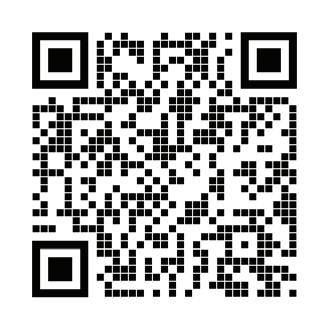
Emory
University Office of Alumni and Development Records
1762 Clifton Rd., Suite 1400 Atlanta, Georgia 30322
RECYCLE ME! Finished with this issue of Emory Magazine? Pass along to a friend or colleague!
